Paul van Yperen's Blog, page 234
May 21, 2019
Nur ein Schmetterling (1918)
Hella Moja starred in the German silent film Nur ein Schmetterling/Only a Butterfly (Iwa Raffay, 1918). Her own film company, Hella-Moja-Film, produced the film. Rotophot published a series of five sepia postcards of the film in their Film Sterne series, of which we cound find only four. We'll keep looking!
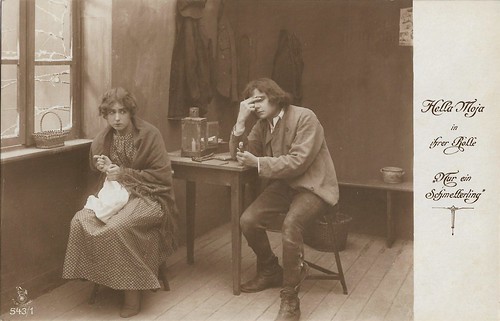
German postcard by Rotophot in the Film Sterne series, no. 543/1. Photo: Hella-Moja-Film. Hella Moja in Nur ein Schmetterling/Only a Butterfly (Iwa Raffay, 1918).
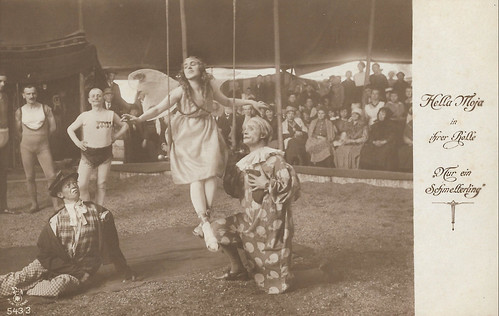
German postcard by Rotophot in the Film Sterne series, no. 543/3. Photo: Hella-Moja-Film. Hella Moja in Nur ein Schmetterling/Only a Butterfly (Iwa Raffay, 1918).
Countess or Damsel
Little is known about Nur ein Schmetterling/Only a Butterfly (Iwa Raffay, 1918). IMDb mentions that Iva (other sources write Iwa) Raffay was both director and scriptwriter, and that the cast also included Alfred Abel , Karl Falkenberg, Josef Ewald and Ernst Hofmann . We did not recognise them on the postcards.
Hella Moja was only 22 at the time. Since 1915, she had worked for pioneer studios like Messter, Union and Terra-Film, and had excelled in short silent melodramas like Die weiße Rose/The White Rose (Franz Hofer, 1915) opposite Erna Morena , Der Schwur der Renate Rabenau/The Vow of Renate Rabenau (Otto Rippert, 1916), Der Fremde/The Stranger (Otto Rippert, 1917) with Werner Krauss and Das verwunschene Schloss/The Enchanted Castle (Otto Rippert, 1918) again with Krauss.
In her films Hella Moja often played a countess or a damsel. With success. There was a Hella Moja serial, and in 1918 she could found her own film company, the Hella Moja Filmgesellschaft, in Berlin. Nur ein Schmetterling was the third production of her film company. 13 more films would follow until 1923. From then on her acting style was seen as old-fashioned and she started to focus on script-writing.
IMDb also mentions that Nur ein Schmetterling premiered in June 1918. So, the First World War or the Great War, was still going on. Germany was falling apart at home. Anti-war marches became frequent and morale in the army fell. In November the war finally ended.
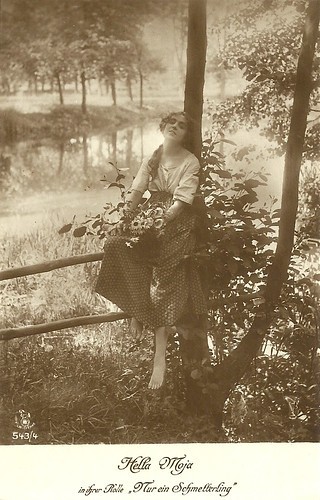
German postcard by Rotophot in the Film Sterne series, no. 543/4. Photo: Hella-Moja-Film. Hella Moja in Nur ein Schmetterling/Only a Butterfly (Iwa Raffay, 1918).

German postcard by Rotophot in the Film Sterne series, no. 543/5. Photo: Hella-Moja-Film. Hella Moja in Nur ein Schmetterling/Only a Butterfly (Iwa Raffay, 1918).
Sources: Wikipedia (German) and IMDb.

German postcard by Rotophot in the Film Sterne series, no. 543/1. Photo: Hella-Moja-Film. Hella Moja in Nur ein Schmetterling/Only a Butterfly (Iwa Raffay, 1918).

German postcard by Rotophot in the Film Sterne series, no. 543/3. Photo: Hella-Moja-Film. Hella Moja in Nur ein Schmetterling/Only a Butterfly (Iwa Raffay, 1918).
Countess or Damsel
Little is known about Nur ein Schmetterling/Only a Butterfly (Iwa Raffay, 1918). IMDb mentions that Iva (other sources write Iwa) Raffay was both director and scriptwriter, and that the cast also included Alfred Abel , Karl Falkenberg, Josef Ewald and Ernst Hofmann . We did not recognise them on the postcards.
Hella Moja was only 22 at the time. Since 1915, she had worked for pioneer studios like Messter, Union and Terra-Film, and had excelled in short silent melodramas like Die weiße Rose/The White Rose (Franz Hofer, 1915) opposite Erna Morena , Der Schwur der Renate Rabenau/The Vow of Renate Rabenau (Otto Rippert, 1916), Der Fremde/The Stranger (Otto Rippert, 1917) with Werner Krauss and Das verwunschene Schloss/The Enchanted Castle (Otto Rippert, 1918) again with Krauss.
In her films Hella Moja often played a countess or a damsel. With success. There was a Hella Moja serial, and in 1918 she could found her own film company, the Hella Moja Filmgesellschaft, in Berlin. Nur ein Schmetterling was the third production of her film company. 13 more films would follow until 1923. From then on her acting style was seen as old-fashioned and she started to focus on script-writing.
IMDb also mentions that Nur ein Schmetterling premiered in June 1918. So, the First World War or the Great War, was still going on. Germany was falling apart at home. Anti-war marches became frequent and morale in the army fell. In November the war finally ended.

German postcard by Rotophot in the Film Sterne series, no. 543/4. Photo: Hella-Moja-Film. Hella Moja in Nur ein Schmetterling/Only a Butterfly (Iwa Raffay, 1918).

German postcard by Rotophot in the Film Sterne series, no. 543/5. Photo: Hella-Moja-Film. Hella Moja in Nur ein Schmetterling/Only a Butterfly (Iwa Raffay, 1918).
Sources: Wikipedia (German) and IMDb.
Published on May 21, 2019 22:00
May 20, 2019
Matt Dillon
American actor Matt Dillon (1964) has had a successful film career has spanned over three decades. From his breakthrough performance in Francis Coppola's The Outsiders (1983) to his hilarious turn as an obsessed private investigator in There's Something About Mary (1998), he has proved himself to be one of the most diverse actors of his generation. Dillon showcased his wide range of dramatic and comedic talents with an arresting performance as a racist cop in the critically acclaimed Crash (2004). It earned him nominations for an Oscar and other awards.
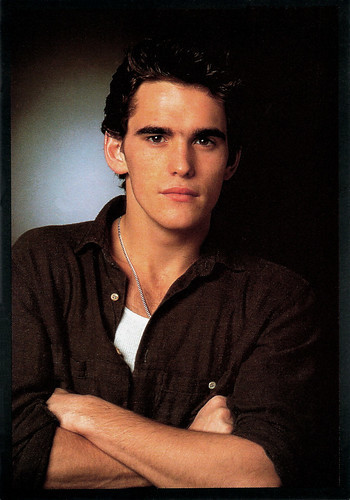
British postcard by Santoro Graphics Ltd., London, no. C236.
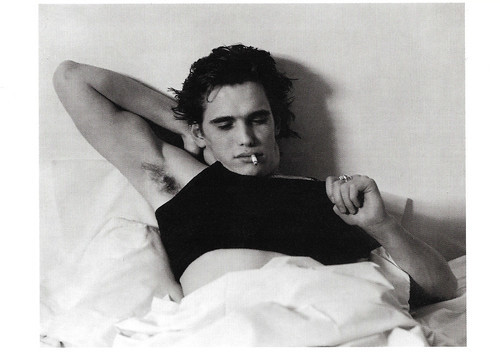
Swiss postcard by News Productions, Baulmes, no. 55736. Photo: Bruce Weber / Musée de l'Elysée, Lausanne, Switzerland. Caption: Matt Dillon, New York City, 1982.
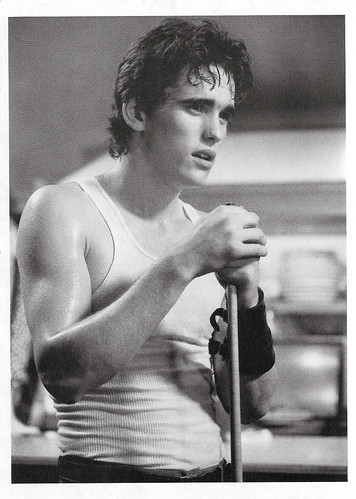
Vintage postcard by Canadian Postcard, no. A-76. Publicity still for Rumble Fish (Francis Coppola, 1983).
Dark, pretty-boy eyes and glacier-cut cheekbones
Matthew Raymond Dillon was born in 1964 in New Rochelle, New York. He was named after the protagonist in the TV series Gunsmoke. His parents are Mary Ellen, a homemaker, and Paul Dillon, a portrait painter and sales manager for Union Camp, a toy bear manufacturer. Matt is the second child of six and is the brother of actors Kevin Dillon and Paul Dillon. He is also a nephew of the late comic-strip artist Alex Raymond, creator of Flash Gordon, Jungle Jim, and Rip Kirby.
Matt began acting in elementary school, and, at the age of 14, he was discovered by Warner Bros. talent scouts while cutting class at Hommocks Middle School in Larchmont. His film debut was in Over the Edge (Jonathan Kaplan, 1979), a gritty teen drama about a group of bored teenagers in a suburb, who rebel against authority after the death of one of their own. His performance was well-received, which led to his casting in two other films released the following year.
With his dark, pretty-boy eyes and glacier-cut cheekbones, Dillon became a teen idol when he played the love interest of Kristy McNichol in Little Darlings (Ron Maxwell, 1980). He then played troubled teens in three of author S.E. Hinton's books made into films consecutively: Tex (Tim Hunter, 1982), The Outsiders (Francis Coppola, 1983) and Rumble Fish (Francis Coppola, 1983).
By the mid-1980s, Dillon sought to move beyond the teen mold and began taking more adult roles. He made his Broadway debut with the play 'The Boys of Winter' in 1985, and co-narrated the TV documentary Dear America: Letters From Home (Bill Couturié, 1987), which won two Emmy awards. In 1990, he won an IFP Spirit Award for his somber, unheroic portrayal of a drug addict in Gus Van Sant's Drugstore Cowboy (1989).
From there he went on to star in such acclaimed films as Singles (Cameron Crowe, 1992) playing the egocentric slacker head of a terrifically bad grunge band; To Die For (Gus Van Sant, 1995) as the well-meaning but tragically dim husband of psychotic weather girl Nicole Kidman, and Beautiful Girls (Ted Demme, 1996), in which Dillon was perfectly cast as a small-town snow plower unable to make good on the promise of his high-school glory days.
A huge hit was the comedy There's Something About Mary (Bobby Farrelly, Peter Farrelly, 1998) with Cameron Diaz and Ben Stiller. Dillon had a three-year relationship with Diaz. They broke up in 1998.
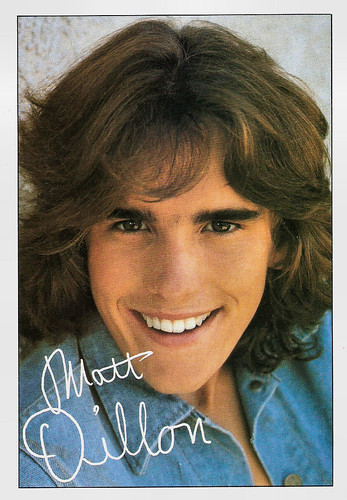
German collectors card by Bravo.
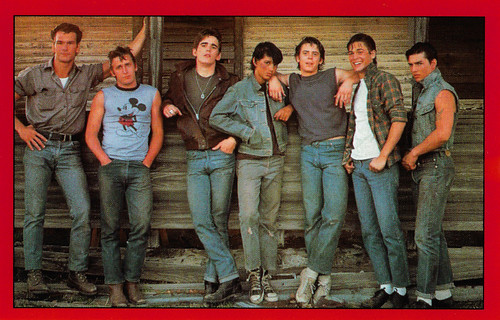
Australian postcard by TV Hits. Photo: N. Moran / Sygma / Austral International. Photo: Patrick Swayze, Emilio Estevez, Matt Dillon, Ralph Macchio, C. Thomas Howell, Rob Lowe and Tom Cruise in The Outsiders (Francis Coppola, 1983).
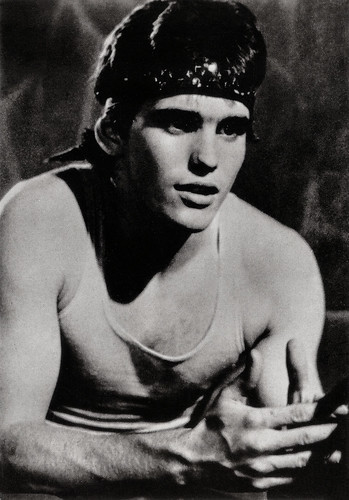
French postcard by Humour à la Carte, Paris, no. 3515. Photo: D.R. Publicity still for Rumble Fish (Francis Coppola, 1983).
Getting better with every film
Aside from being an accomplished actor, Matt Dillon wrote, and made his feature film directorial debut with City of Ghosts (2002). In this thriller, he also starred as a con man on the run from law enforcement, opposite Gérard Depardieu , Stellan Skarsgård, and James Caan. Prior to City of Ghosts, Dillon made his television directorial debut with an episode of HBO's gritty prison drama Oz (1997).
One of his best roles was in the film Crash (Paul Haggis, 2004), in which the narrative shifts between several different groups of seemingly unconnected people in Los Angeles whose relationships to each other are only revealed in the end. It would earn Dillon his first Oscar nomination.
Dillon starred in Factotum (Bent Hamer, 2005) for which he received glowing reviews for portraying Charles Bukowski's alter ego when the film premiered at the Cannes Film Festival. He then appeared opposite Kate Hudson and Owen Wilson in the comedy, You, Me and Dupree (Anthony Russo, Joe Russo, 2006).
During his long career, Dillon appeared in several music videos. He made a cameo appearance as a detective in Madonna's 'Bad Girl' music video which also stars Christopher Walken. Dillon appeared in 1987 in the music video for 'Fairytale of New York' by the Irish folk-punk band The Pogues playing a cop who escorts lead singer Shane MacGowan into the 'drunk tank'.
His more recent film credits include the comedy Girl Most Likely (Shari Springer Berman, Robert Pulcini, 2012) opposite Annette Bening and Kristen Wiig, the drama Sunlight, Jr. (Laurie Collyer, 2013) opposite Naomi Watts, and the heist comedy The Art Of The Steal (Jonathan Sobol, 2013) opposite Kurt Russell. Dillon also starred in M. Night Shyamalan's TV series Wayward Pines (2015).
Last year he surprised with his role as a serial killer in Lars von Trier's controversial film The House That Jack Built (2018), co-starring Bruno Ganz and Uma Thurman. The film debuted at the Cannes Film Festival, marking von Trier's return to the festival after more than six years. And as the New York Times' Film Critic A.O. Scott once wrote about Dillon, "He seems to be getting better with every film."
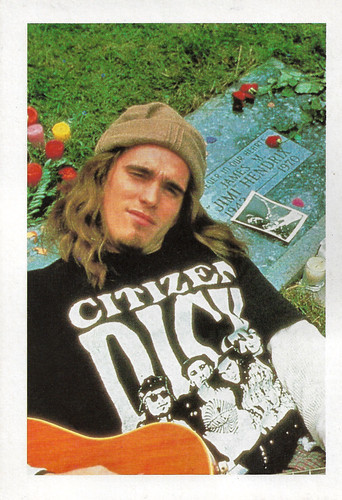
Italian postcard by Ediber-Angelus, Milano, no.4. Photo: Warner Bros. Matt Dillon in Singles (Cameron Crowe, 1992).
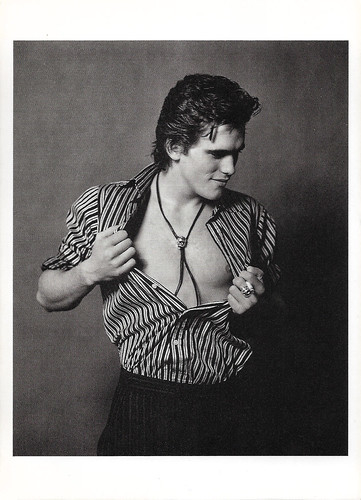
Swiss postcard by News Productions, Baulmes, no. 55738. Photo: Bruce Weber. Poster design for Musée de l'Elysée, Lausanne, Switzerland.

Swiss postcard by News Productions, Baulmes, no. 55775. Photo: Bruce Weber. Poster design for Musée de l'Elysée, Lausanne, Switzerland. Design: Werner Jeker.
Sources: Rebecca Flint Marx (AllMovie), (IMDb), Wikipedia and .

British postcard by Santoro Graphics Ltd., London, no. C236.

Swiss postcard by News Productions, Baulmes, no. 55736. Photo: Bruce Weber / Musée de l'Elysée, Lausanne, Switzerland. Caption: Matt Dillon, New York City, 1982.

Vintage postcard by Canadian Postcard, no. A-76. Publicity still for Rumble Fish (Francis Coppola, 1983).
Dark, pretty-boy eyes and glacier-cut cheekbones
Matthew Raymond Dillon was born in 1964 in New Rochelle, New York. He was named after the protagonist in the TV series Gunsmoke. His parents are Mary Ellen, a homemaker, and Paul Dillon, a portrait painter and sales manager for Union Camp, a toy bear manufacturer. Matt is the second child of six and is the brother of actors Kevin Dillon and Paul Dillon. He is also a nephew of the late comic-strip artist Alex Raymond, creator of Flash Gordon, Jungle Jim, and Rip Kirby.
Matt began acting in elementary school, and, at the age of 14, he was discovered by Warner Bros. talent scouts while cutting class at Hommocks Middle School in Larchmont. His film debut was in Over the Edge (Jonathan Kaplan, 1979), a gritty teen drama about a group of bored teenagers in a suburb, who rebel against authority after the death of one of their own. His performance was well-received, which led to his casting in two other films released the following year.
With his dark, pretty-boy eyes and glacier-cut cheekbones, Dillon became a teen idol when he played the love interest of Kristy McNichol in Little Darlings (Ron Maxwell, 1980). He then played troubled teens in three of author S.E. Hinton's books made into films consecutively: Tex (Tim Hunter, 1982), The Outsiders (Francis Coppola, 1983) and Rumble Fish (Francis Coppola, 1983).
By the mid-1980s, Dillon sought to move beyond the teen mold and began taking more adult roles. He made his Broadway debut with the play 'The Boys of Winter' in 1985, and co-narrated the TV documentary Dear America: Letters From Home (Bill Couturié, 1987), which won two Emmy awards. In 1990, he won an IFP Spirit Award for his somber, unheroic portrayal of a drug addict in Gus Van Sant's Drugstore Cowboy (1989).
From there he went on to star in such acclaimed films as Singles (Cameron Crowe, 1992) playing the egocentric slacker head of a terrifically bad grunge band; To Die For (Gus Van Sant, 1995) as the well-meaning but tragically dim husband of psychotic weather girl Nicole Kidman, and Beautiful Girls (Ted Demme, 1996), in which Dillon was perfectly cast as a small-town snow plower unable to make good on the promise of his high-school glory days.
A huge hit was the comedy There's Something About Mary (Bobby Farrelly, Peter Farrelly, 1998) with Cameron Diaz and Ben Stiller. Dillon had a three-year relationship with Diaz. They broke up in 1998.

German collectors card by Bravo.

Australian postcard by TV Hits. Photo: N. Moran / Sygma / Austral International. Photo: Patrick Swayze, Emilio Estevez, Matt Dillon, Ralph Macchio, C. Thomas Howell, Rob Lowe and Tom Cruise in The Outsiders (Francis Coppola, 1983).

French postcard by Humour à la Carte, Paris, no. 3515. Photo: D.R. Publicity still for Rumble Fish (Francis Coppola, 1983).
Getting better with every film
Aside from being an accomplished actor, Matt Dillon wrote, and made his feature film directorial debut with City of Ghosts (2002). In this thriller, he also starred as a con man on the run from law enforcement, opposite Gérard Depardieu , Stellan Skarsgård, and James Caan. Prior to City of Ghosts, Dillon made his television directorial debut with an episode of HBO's gritty prison drama Oz (1997).
One of his best roles was in the film Crash (Paul Haggis, 2004), in which the narrative shifts between several different groups of seemingly unconnected people in Los Angeles whose relationships to each other are only revealed in the end. It would earn Dillon his first Oscar nomination.
Dillon starred in Factotum (Bent Hamer, 2005) for which he received glowing reviews for portraying Charles Bukowski's alter ego when the film premiered at the Cannes Film Festival. He then appeared opposite Kate Hudson and Owen Wilson in the comedy, You, Me and Dupree (Anthony Russo, Joe Russo, 2006).
During his long career, Dillon appeared in several music videos. He made a cameo appearance as a detective in Madonna's 'Bad Girl' music video which also stars Christopher Walken. Dillon appeared in 1987 in the music video for 'Fairytale of New York' by the Irish folk-punk band The Pogues playing a cop who escorts lead singer Shane MacGowan into the 'drunk tank'.
His more recent film credits include the comedy Girl Most Likely (Shari Springer Berman, Robert Pulcini, 2012) opposite Annette Bening and Kristen Wiig, the drama Sunlight, Jr. (Laurie Collyer, 2013) opposite Naomi Watts, and the heist comedy The Art Of The Steal (Jonathan Sobol, 2013) opposite Kurt Russell. Dillon also starred in M. Night Shyamalan's TV series Wayward Pines (2015).
Last year he surprised with his role as a serial killer in Lars von Trier's controversial film The House That Jack Built (2018), co-starring Bruno Ganz and Uma Thurman. The film debuted at the Cannes Film Festival, marking von Trier's return to the festival after more than six years. And as the New York Times' Film Critic A.O. Scott once wrote about Dillon, "He seems to be getting better with every film."

Italian postcard by Ediber-Angelus, Milano, no.4. Photo: Warner Bros. Matt Dillon in Singles (Cameron Crowe, 1992).

Swiss postcard by News Productions, Baulmes, no. 55738. Photo: Bruce Weber. Poster design for Musée de l'Elysée, Lausanne, Switzerland.

Swiss postcard by News Productions, Baulmes, no. 55775. Photo: Bruce Weber. Poster design for Musée de l'Elysée, Lausanne, Switzerland. Design: Werner Jeker.
Sources: Rebecca Flint Marx (AllMovie), (IMDb), Wikipedia and .
Published on May 20, 2019 22:00
May 19, 2019
Divine
Harris Glenn Milstead, better known by his stage name Divine (1945-1988), was an American actor, singer, and drag queen. He was closely associated with the independent filmmaker John Waters. Divine became the international icon of bad taste cinema.
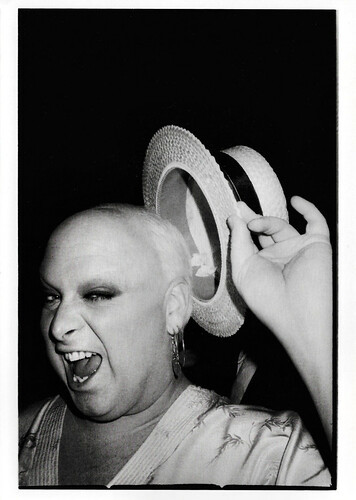
American postcard by Portfolio, N.Y., N.Y., no P 402. Photo: Christopher Makos. Caption: Divine, 1978.
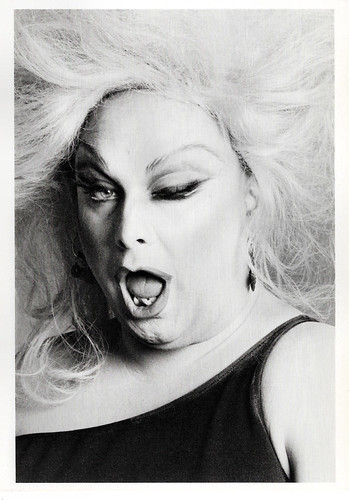
American postcard by Portfolio, N.Y., N.Y., no SC 5. Photo: Francesco Scavullo. Caption: Divine, New York, 1978.

Dutch promotion card by Europop, Haarlem. Photo: Francesco Scavullo, 1978.
Taboo in conventional American society
Harris Glenn Milstead was born in 1945 in Baltimore, Maryland to a conservative middle-class family. His parents were Harris Bernard Milstead and Frances Milstead (née Vukovich). Their only child, his parents lavished almost anything that he wanted upon him, including food. He became overweight, a condition he lived with for the rest of his life.
Divine preferred to use his middle name, Glenn, to distinguish himself from his father, and was referred to as such by his parents and friends. When he was 17, his parents sent him to a psychiatrist, where he first realised his sexual attraction to men as well as women, something then taboo in conventional American society. In 1963, he began attending the Marinella Beauty School, where he learned hair styling and, after completing his studies, gained employment at a couple of local salons, specialising in the creation of beehives and other upswept hairstyles. Milstead developed an early interest in drag while working as a women's hairdresser. He eventually gave up his job and for a while was financially supported by his parents, who catered to his expensive taste in clothes and cars. They reluctantly paid the many bills that he ran up financing lavish parties where he would dress up in drag as his favourite celebrity, actress Elizabeth Taylor . By the mid-1960s he had embraced the city's countercultural scene.
His friend from high school, John Waters gave him the name 'Divine' and the tagline of 'the most beautiful woman in the world, almost'. Waters later remarked that he had borrowed the name Divine from a character in Jean Genet's novel Our Lady of the Flowers (1943). Along with his friend David Lochary, Divine joined Waters' acting troupe, the Dreamlanders (which also included Mary Vivian Pearce and Mink Stole), and adopted female roles for their experimental short films. The first film was Roman Candles (John Waters, 1966), which was shown 'triple projected' on three 8mm projectors running simultaneously but was never released commercially. Divine starred in drag as a smoking nun. Other short films were Eat Your Makeup (John Waters, 1968), and The Diane Linkletter Story (John Waters, 1969), filmed on Sunday afternoons. Again in drag, he took a lead role in Waters' first full-length film, Mondo Trasho (John Waters, 1969) as an unnamed blonde woman who drives around town and runs over a hitchhiker. In their review of the film, the Los Angeles Free Press exclaimed that "The 300-pound (140 kg) sex-symbol Divine is undoubtedly some sort of discovery."
In 1970, he travelled to San Francisco, California, a city which had a large gay subculture that attracted Divine, who was then embracing his homosexuality. Divine played the role of Lady Divine, the operator of an exhibit known as 'The Cavalcade of Perversion' who turns to murdering visitors in Waters's film Multiple Maniacs (John Waters, 1970). The film contained several controversial scenes, notably one which involved Lady Divine masturbating using a rosary while sitting inside a church. In another scene, Lady Divine kills her boyfriend and proceeds to eat his heart; in actuality, Divine bit into a cow's heart which had gone rotten from being left out on the set all day. At the end of the film, Lady Divine is raped by a giant lobster named Lobstora, an act that drives her into madness; she subsequently goes on a killing spree in Fell's Point before being shot down by the National Guard. Due to its controversial nature, Waters feared that the film would be banned and confiscated by the Maryland Censor Board, so avoided their jurisdiction by only screening it at non-commercial venues, namely rented church premises. Multiple Maniacs was the first of Waters's films to receive widespread attention, as did Divine. KSFX remarked that "Divine is incredible! Could start a whole new trend in films."
Following his San Francisco sojourn, Divine returned to Baltimore and participated in Pink Flamingos (John Waters, 1972). Designed by Waters to be an exercise in poor taste, the film featured Divine as Babs Johnson, living in a pink trailer with her egg-eating grandmother, chicken-loving son and voyeuristic daughter. Babs claims to be 'the filthiest person alive' and she is forced to prove her right to the title from challengers, Connie (Mink Stole) and Raymond Marble (David Lochary). In one scene, the Marbles send Babs a turd in a box as a birthday present, and in order to enact this scene, Divine defecated into the box the night before. The final scene in the film proved particularly infamous, involving Babs eating fresh dog feces. Divine later told a reporter: "I followed that dog around for three hours just zooming in on its asshole," waiting for it to empty its bowels so that they could film the scene. The scene became one of the most notable moments of Divine's acting career, and he later complained of people thinking that "I run around doing it all the time". The film proved a hit on the U.S. midnight movie circuit, became a cult classic, and established Divine's fame within the American counterculture.
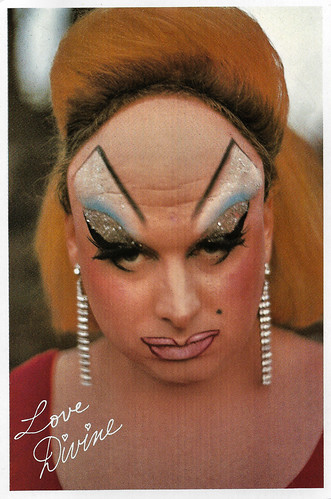
American postcard by American Postcard Company, no. 894. Photo: Bob Adams / New Line Cinema. Divine in Pink Flamingos (John Waters, 1972).
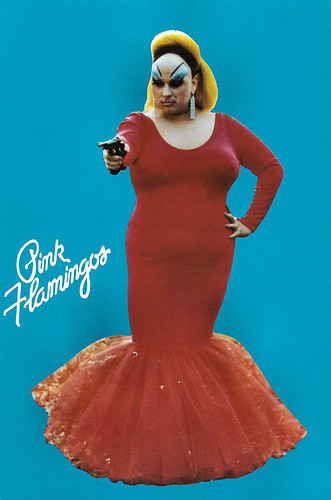
American postcard by American Postcard Company, 1982. Photo: Lawrence Irvine / New Line Cinema. Divine in Pink Flamingos (John Waters, 1972).
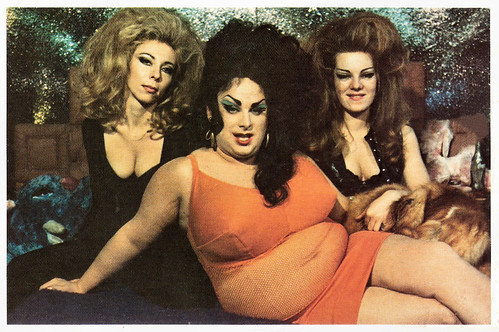
American postcard by The American Postcard Co. Inc., no. 895, 1982. Photo: Bruce Moore / New Line Cinema Corp. Divine, Cookie Mueller, and Susan Walsh in Female Trouble (John Waters, 1974). Caption: Divine as Dawn Davenport and Her Sisters in Crime, from Female Trouble by John Waters.
The stereotype of simply being a female impersonator
Divine returned to San Francisco, where he and Mink Stole starred in a number of small-budget plays at the Palace Theater as part of drag troupe The Cockettes, including 'Divine and Her Stimulating Studs', 'Divine Saves the World', 'Vice Palace', 'Journey to the Center of Uranus' and 'The Heartbreak of Psoriasis'. In 1974, Divine returned to Baltimore to film Waters's next motion picture, Female Trouble (John Waters, 1974), in which he played the lead role.
Divine was unable to appear in Waters's next feature, Desperate Living (John Waters, 1977), despite the fact that the role of Mole McHenry had been written for him. This was because he had returned to working in the theatre as the scheming prison matron Pauline in Tom Eyen's play 'Women Behind Bars' and its sequel,'The Neon Woman'.
While in London in 1978, Divine attended as the guest of honour at the fourth Alternative Miss World pageant, a 'mock' event founded by Andrew Logan in 1972 in which 'drag queens' – including men, women and children – competed for the prize. The event held in a circus tent on Clapham Common in South London was filmed by director Richard Gayer. His film, Alternative Miss World (Richard Gayer, 1980), premiered at the Odeon in London's Leicester Square as well as featuring at the Cannes Film Festival, both events which were attended by Divine.
Continuing his cinematic work, he starred in Polyester (John Waters, 1981) as Francine Fishpaw. Unlike earlier roles, Fishpaw was not a strong female but a meek and victimised woman who falls in love with her dream lover, Todd Tomorrow, played by Tab Hunter . The film was released in 'Odorama', accompanied by 'scratch 'n' sniff' cards for the audience to smell at key points in the film.
In 1981, Divine embarked on a career in the disco industry by producing a number of Hi-NRG tracks, most of which were written by Bobby Orlando. He achieved international chart success with hits like 'You Think You're a Man', 'I'm So Beautiful', and 'Walk Like a Man', all of which were performed in drag.
The next Divine film, Lust in the Dust (Paul Bartel, 1985), reunited him with Tab Hunter and was Divine's first film not directed by John Waters. Set in the Wild West during the nineteenth century, the film was a sex comedy that starred Divine as Rosie Velez, a promiscuous woman who works as a singer in saloons and competes for the love of Abel Wood ( Tab Hunter ) against another woman (Lainie Kazan). A parody of the Western Duel in the Sun (King Vidor, 1946), the film was a moderate critical success.
Divine followed this production with a very different role, that of gay male gangster Hilly Blue in Trouble in Mind (Alan Rudolph, 1985), starring Kris Kristofferson and Keith Carradine. The script was written with Divine in mind. Although not a major character in the film, Divine had been eager to play the part because he wished to perform in more male roles and leave behind the stereotype of simply being a female impersonator. Reviews of the film were mixed, as were the evaluations of Divine's performance.
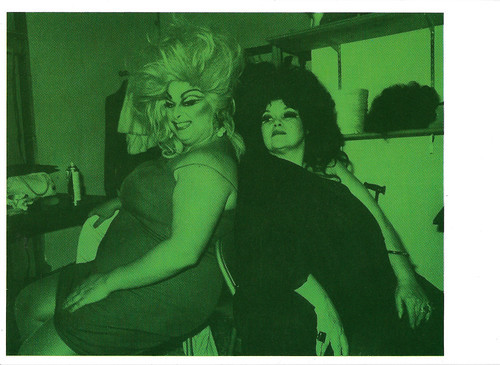
German postcard in the series Die Leidenschaften des Rosa von Praumheim by Gebr. König Postkartenverlag, Köln (Cologne), no. 10/10. Photo: Michael Oblowitz. Divine and Tally Brown in Tally Brown, New York (Rosa von Praunheim, 1979).
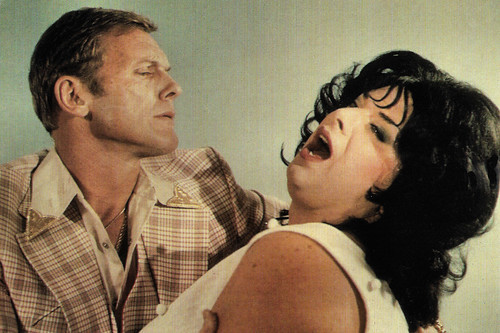
American postcard by American Postcard Company, no. 3896, 1998. Photo: New Line Cinema. Publicity still for Polyester (John Waters, 1981). Caption: Tab Hunter as "Todd Tomorrow" and Divine as "Francine Fishpaw" in John Waters' Polyester, 1981.
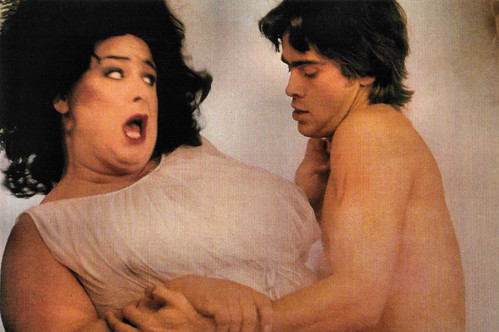
American postcard by American Postcard Company, no. 3900, 1998. Photo: New Line Cinema. Publicity still for Polyester (John Waters, 1981). Caption: Divine as "Francine Fishpaw," and STIV BATORS as "Bo-Bo Belsinger" in John Waters' Polyester, 1981. The film introduced "ODORAMA" which allowed the audience to share in 10-of the more penetrating odors that plagued poor "Francine".
His breakthrough into mainstream cinema
Divine reunited with John Waters for Hairspray (John Waters, 1988), which represented his breakthrough into mainstream cinema. Set in Baltimore during the 1960s, Hairspray revolved around self-proclaimed "pleasantly plump" teenager Tracy Turnblad (Ricki Lake) as she pursues stardom as a dancer on a local television show and rallies against racial segregation.
As he had in Female Trouble, Divine took on two roles in the film, one of which was female and the other male. The first of these, Edna Turnblad, was Tracy's loving mother; the other was the racist head of the station that airs the 'Corny Collins show'. Hairspray was only a moderate success upon its initial theatrical release, earning a modest gross of $8 million. However, it managed to attract a larger audience on home video in the early 1990s and became a cult classic.
Divine's final film role was in the low-budget comedy horror Out of the Dark (Michael Schroeder, 1989), produced with the same crew as Lust in the Dust. Appearing in only one scene within the film, he played the character of Detective Langella, a foulmouthed policeman investigating the murders of a killer clown. Out of the Dark would be released the year after Divine's death.
On 7 March 1988, three weeks after Hairspray was released nationwide, Divine was staying at the Regency Plaza Suites Hotel in Los Angeles. He was scheduled to film a guest appearance the following day as Uncle Otto on the Fox network's television series Married... with Children in the second season wrap-up episode. Shortly before midnight, he died in his sleep, at age 42, of an enlarged heart (according to Wikipdia ) or respiratory failure caused by sleep apnoea (according to IMDb ). It was probably a combination.
Described by People magazine as the 'Drag Queen of the Century', Divine has remained a cult figure, particularly within the LGBT community, and has provided the inspiration for fictional characters, artworks, and songs. Various books and documentary films devoted to his life have also been produced, including 'Divine Trash' (1998) and 'I Am Divine' (2013), written by Divine's manager and friend Bernard Jay. Frances Milstead subsequently cowrote her own book about Divine, entitled 'My Son Divine' (2001), with Kevin Heffernan and Steve Yeager. His mother's continued relationship with the gay community was later documented in the film Frances: A Mother Divine (Tim Dunn, Michael O'Quinn, 2010).
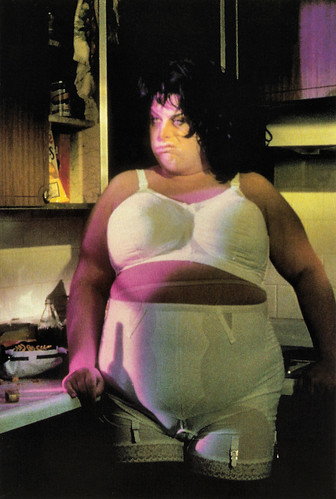
American postcard by American Postcard Company, no. 3897, 1998. Photo: Bob Adams / New Line Cinema. Publicity still for Polyester (John Waters, 1981). Caption: Divine as "Francine Fishpaw," in John Waters' Polyester, 1981. The film introduced "Odorama" which allowed the audience to share in 10-of the more penetrating odors that plagued poor "Francine".
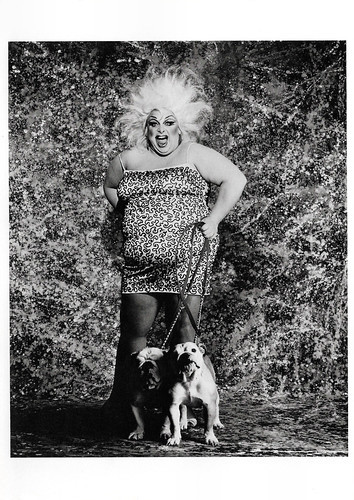
American postcard by Fotofolio, New York. Photo: Greg Gorman. Caption: Divine, Los Angeles, 1984. N.B. Proceeds from the sale of this card benefitted the American foundation for AIDS research.
Pink Flamingos Trailer, introduced by John Waters. Source: gaymoviereviews (YouTube).
Sources: Wikipedia and .

American postcard by Portfolio, N.Y., N.Y., no P 402. Photo: Christopher Makos. Caption: Divine, 1978.

American postcard by Portfolio, N.Y., N.Y., no SC 5. Photo: Francesco Scavullo. Caption: Divine, New York, 1978.

Dutch promotion card by Europop, Haarlem. Photo: Francesco Scavullo, 1978.
Taboo in conventional American society
Harris Glenn Milstead was born in 1945 in Baltimore, Maryland to a conservative middle-class family. His parents were Harris Bernard Milstead and Frances Milstead (née Vukovich). Their only child, his parents lavished almost anything that he wanted upon him, including food. He became overweight, a condition he lived with for the rest of his life.
Divine preferred to use his middle name, Glenn, to distinguish himself from his father, and was referred to as such by his parents and friends. When he was 17, his parents sent him to a psychiatrist, where he first realised his sexual attraction to men as well as women, something then taboo in conventional American society. In 1963, he began attending the Marinella Beauty School, where he learned hair styling and, after completing his studies, gained employment at a couple of local salons, specialising in the creation of beehives and other upswept hairstyles. Milstead developed an early interest in drag while working as a women's hairdresser. He eventually gave up his job and for a while was financially supported by his parents, who catered to his expensive taste in clothes and cars. They reluctantly paid the many bills that he ran up financing lavish parties where he would dress up in drag as his favourite celebrity, actress Elizabeth Taylor . By the mid-1960s he had embraced the city's countercultural scene.
His friend from high school, John Waters gave him the name 'Divine' and the tagline of 'the most beautiful woman in the world, almost'. Waters later remarked that he had borrowed the name Divine from a character in Jean Genet's novel Our Lady of the Flowers (1943). Along with his friend David Lochary, Divine joined Waters' acting troupe, the Dreamlanders (which also included Mary Vivian Pearce and Mink Stole), and adopted female roles for their experimental short films. The first film was Roman Candles (John Waters, 1966), which was shown 'triple projected' on three 8mm projectors running simultaneously but was never released commercially. Divine starred in drag as a smoking nun. Other short films were Eat Your Makeup (John Waters, 1968), and The Diane Linkletter Story (John Waters, 1969), filmed on Sunday afternoons. Again in drag, he took a lead role in Waters' first full-length film, Mondo Trasho (John Waters, 1969) as an unnamed blonde woman who drives around town and runs over a hitchhiker. In their review of the film, the Los Angeles Free Press exclaimed that "The 300-pound (140 kg) sex-symbol Divine is undoubtedly some sort of discovery."
In 1970, he travelled to San Francisco, California, a city which had a large gay subculture that attracted Divine, who was then embracing his homosexuality. Divine played the role of Lady Divine, the operator of an exhibit known as 'The Cavalcade of Perversion' who turns to murdering visitors in Waters's film Multiple Maniacs (John Waters, 1970). The film contained several controversial scenes, notably one which involved Lady Divine masturbating using a rosary while sitting inside a church. In another scene, Lady Divine kills her boyfriend and proceeds to eat his heart; in actuality, Divine bit into a cow's heart which had gone rotten from being left out on the set all day. At the end of the film, Lady Divine is raped by a giant lobster named Lobstora, an act that drives her into madness; she subsequently goes on a killing spree in Fell's Point before being shot down by the National Guard. Due to its controversial nature, Waters feared that the film would be banned and confiscated by the Maryland Censor Board, so avoided their jurisdiction by only screening it at non-commercial venues, namely rented church premises. Multiple Maniacs was the first of Waters's films to receive widespread attention, as did Divine. KSFX remarked that "Divine is incredible! Could start a whole new trend in films."
Following his San Francisco sojourn, Divine returned to Baltimore and participated in Pink Flamingos (John Waters, 1972). Designed by Waters to be an exercise in poor taste, the film featured Divine as Babs Johnson, living in a pink trailer with her egg-eating grandmother, chicken-loving son and voyeuristic daughter. Babs claims to be 'the filthiest person alive' and she is forced to prove her right to the title from challengers, Connie (Mink Stole) and Raymond Marble (David Lochary). In one scene, the Marbles send Babs a turd in a box as a birthday present, and in order to enact this scene, Divine defecated into the box the night before. The final scene in the film proved particularly infamous, involving Babs eating fresh dog feces. Divine later told a reporter: "I followed that dog around for three hours just zooming in on its asshole," waiting for it to empty its bowels so that they could film the scene. The scene became one of the most notable moments of Divine's acting career, and he later complained of people thinking that "I run around doing it all the time". The film proved a hit on the U.S. midnight movie circuit, became a cult classic, and established Divine's fame within the American counterculture.

American postcard by American Postcard Company, no. 894. Photo: Bob Adams / New Line Cinema. Divine in Pink Flamingos (John Waters, 1972).

American postcard by American Postcard Company, 1982. Photo: Lawrence Irvine / New Line Cinema. Divine in Pink Flamingos (John Waters, 1972).

American postcard by The American Postcard Co. Inc., no. 895, 1982. Photo: Bruce Moore / New Line Cinema Corp. Divine, Cookie Mueller, and Susan Walsh in Female Trouble (John Waters, 1974). Caption: Divine as Dawn Davenport and Her Sisters in Crime, from Female Trouble by John Waters.
The stereotype of simply being a female impersonator
Divine returned to San Francisco, where he and Mink Stole starred in a number of small-budget plays at the Palace Theater as part of drag troupe The Cockettes, including 'Divine and Her Stimulating Studs', 'Divine Saves the World', 'Vice Palace', 'Journey to the Center of Uranus' and 'The Heartbreak of Psoriasis'. In 1974, Divine returned to Baltimore to film Waters's next motion picture, Female Trouble (John Waters, 1974), in which he played the lead role.
Divine was unable to appear in Waters's next feature, Desperate Living (John Waters, 1977), despite the fact that the role of Mole McHenry had been written for him. This was because he had returned to working in the theatre as the scheming prison matron Pauline in Tom Eyen's play 'Women Behind Bars' and its sequel,'The Neon Woman'.
While in London in 1978, Divine attended as the guest of honour at the fourth Alternative Miss World pageant, a 'mock' event founded by Andrew Logan in 1972 in which 'drag queens' – including men, women and children – competed for the prize. The event held in a circus tent on Clapham Common in South London was filmed by director Richard Gayer. His film, Alternative Miss World (Richard Gayer, 1980), premiered at the Odeon in London's Leicester Square as well as featuring at the Cannes Film Festival, both events which were attended by Divine.
Continuing his cinematic work, he starred in Polyester (John Waters, 1981) as Francine Fishpaw. Unlike earlier roles, Fishpaw was not a strong female but a meek and victimised woman who falls in love with her dream lover, Todd Tomorrow, played by Tab Hunter . The film was released in 'Odorama', accompanied by 'scratch 'n' sniff' cards for the audience to smell at key points in the film.
In 1981, Divine embarked on a career in the disco industry by producing a number of Hi-NRG tracks, most of which were written by Bobby Orlando. He achieved international chart success with hits like 'You Think You're a Man', 'I'm So Beautiful', and 'Walk Like a Man', all of which were performed in drag.
The next Divine film, Lust in the Dust (Paul Bartel, 1985), reunited him with Tab Hunter and was Divine's first film not directed by John Waters. Set in the Wild West during the nineteenth century, the film was a sex comedy that starred Divine as Rosie Velez, a promiscuous woman who works as a singer in saloons and competes for the love of Abel Wood ( Tab Hunter ) against another woman (Lainie Kazan). A parody of the Western Duel in the Sun (King Vidor, 1946), the film was a moderate critical success.
Divine followed this production with a very different role, that of gay male gangster Hilly Blue in Trouble in Mind (Alan Rudolph, 1985), starring Kris Kristofferson and Keith Carradine. The script was written with Divine in mind. Although not a major character in the film, Divine had been eager to play the part because he wished to perform in more male roles and leave behind the stereotype of simply being a female impersonator. Reviews of the film were mixed, as were the evaluations of Divine's performance.

German postcard in the series Die Leidenschaften des Rosa von Praumheim by Gebr. König Postkartenverlag, Köln (Cologne), no. 10/10. Photo: Michael Oblowitz. Divine and Tally Brown in Tally Brown, New York (Rosa von Praunheim, 1979).

American postcard by American Postcard Company, no. 3896, 1998. Photo: New Line Cinema. Publicity still for Polyester (John Waters, 1981). Caption: Tab Hunter as "Todd Tomorrow" and Divine as "Francine Fishpaw" in John Waters' Polyester, 1981.

American postcard by American Postcard Company, no. 3900, 1998. Photo: New Line Cinema. Publicity still for Polyester (John Waters, 1981). Caption: Divine as "Francine Fishpaw," and STIV BATORS as "Bo-Bo Belsinger" in John Waters' Polyester, 1981. The film introduced "ODORAMA" which allowed the audience to share in 10-of the more penetrating odors that plagued poor "Francine".
His breakthrough into mainstream cinema
Divine reunited with John Waters for Hairspray (John Waters, 1988), which represented his breakthrough into mainstream cinema. Set in Baltimore during the 1960s, Hairspray revolved around self-proclaimed "pleasantly plump" teenager Tracy Turnblad (Ricki Lake) as she pursues stardom as a dancer on a local television show and rallies against racial segregation.
As he had in Female Trouble, Divine took on two roles in the film, one of which was female and the other male. The first of these, Edna Turnblad, was Tracy's loving mother; the other was the racist head of the station that airs the 'Corny Collins show'. Hairspray was only a moderate success upon its initial theatrical release, earning a modest gross of $8 million. However, it managed to attract a larger audience on home video in the early 1990s and became a cult classic.
Divine's final film role was in the low-budget comedy horror Out of the Dark (Michael Schroeder, 1989), produced with the same crew as Lust in the Dust. Appearing in only one scene within the film, he played the character of Detective Langella, a foulmouthed policeman investigating the murders of a killer clown. Out of the Dark would be released the year after Divine's death.
On 7 March 1988, three weeks after Hairspray was released nationwide, Divine was staying at the Regency Plaza Suites Hotel in Los Angeles. He was scheduled to film a guest appearance the following day as Uncle Otto on the Fox network's television series Married... with Children in the second season wrap-up episode. Shortly before midnight, he died in his sleep, at age 42, of an enlarged heart (according to Wikipdia ) or respiratory failure caused by sleep apnoea (according to IMDb ). It was probably a combination.
Described by People magazine as the 'Drag Queen of the Century', Divine has remained a cult figure, particularly within the LGBT community, and has provided the inspiration for fictional characters, artworks, and songs. Various books and documentary films devoted to his life have also been produced, including 'Divine Trash' (1998) and 'I Am Divine' (2013), written by Divine's manager and friend Bernard Jay. Frances Milstead subsequently cowrote her own book about Divine, entitled 'My Son Divine' (2001), with Kevin Heffernan and Steve Yeager. His mother's continued relationship with the gay community was later documented in the film Frances: A Mother Divine (Tim Dunn, Michael O'Quinn, 2010).

American postcard by American Postcard Company, no. 3897, 1998. Photo: Bob Adams / New Line Cinema. Publicity still for Polyester (John Waters, 1981). Caption: Divine as "Francine Fishpaw," in John Waters' Polyester, 1981. The film introduced "Odorama" which allowed the audience to share in 10-of the more penetrating odors that plagued poor "Francine".

American postcard by Fotofolio, New York. Photo: Greg Gorman. Caption: Divine, Los Angeles, 1984. N.B. Proceeds from the sale of this card benefitted the American foundation for AIDS research.
Pink Flamingos Trailer, introduced by John Waters. Source: gaymoviereviews (YouTube).
Sources: Wikipedia and .
Published on May 19, 2019 22:00
May 18, 2019
Sheree North
American film and television actress Sheree North (1932–2005) was one of 20th Century-Fox's intended successors to Marilyn Monroe. But North became her own woman in a varied and sometimes bumpy 40+ year film, stage and TV career.
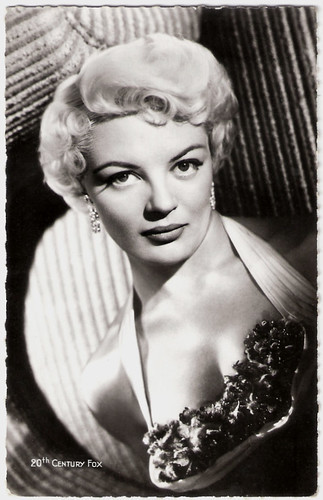
French postcard by Editions du Globe, Paris, no. 553. Photo: 20th Century Fox.
A brush with scandal
Sheree North was born Dawn Shirley Crang in 1932 in Los Angeles. She was the daughter of June Shoard and Richard Crang. Following her mother's remarriage to Edward Bethel, she was known as Dawn Shirley Bethel.
North began taking dance lessons at age 6. At age 10 she danced in several USO shows during WWII. At age 13 she lied about her age so she could become a chorus girl. In 1948, she married Fred Bessire. She bore her first child at age 17 in 1949, and continued dancing in clubs under the stage name Shirley Mae Bessire.
North made her film debut as an uncredited extra in the Red Skelton comedy Excuse My Dust (Roy Rowland, 1951). She was discovered in a Santa Monica night club by a famous choreographer who cast her as a chorus girl in the film Here Come the Girls (Claude Binyon, 1953), starring Bob Hope. Around that time, she adopted the stage name Sheree North.
She made her Broadway debut in the musical Hazel Flagg. For her performance, she won a 1953 Theatre World Award. She reprised her role in the film version, Living It Up (Norman Tautog, 1954) with Dean Martin and Jerry Lewis. In 1954, North signed a four-year contract with 20th Century-Fox.
In March 1954, North had a brush with scandal when it was revealed that she had earlier danced a 'Tiger Dance' in a bikini in an 8 mm erotic film. Fox capitalised on the publicity as the studio previously had with Marilyn Monroe 's nude calendar posing in 1952. She became Fox's alternative to MM. When she was pictured on the cover of the 21 March 1955, issue of Life magazine, the headline read, "Sheree North Takes Over From Marilyn Monroe ".
She appeared in such Box Office friendly entertainments as the musicals How to be very, very popular (Nunnally Johnson, 1955) with Betty Grable in her final role, and The Best Things in Life are Free (Michael Curtiz, 1956) with Gordon MacRae, Dan Dailey and Ernest Borgnine, as well as the comedy The Lieutenant wore Skirts (Frank Tashlin, 1956) with Tom Ewell.
Fox later signed Jayne Mansfield in 1956 and North was pushed aside by the studio. She appeared in four more forgettable Fox films - The Way to the Gold (Robert D. Webb, 1957), No Down Payment (Martin Ritt, 1957) with Joanne Woodward, In Love and War (Philip Dunne, 1958), and Mardi Gras (Edmund Goulding, 1958) with Pat Boone. Her contract was not renewed after 1958.
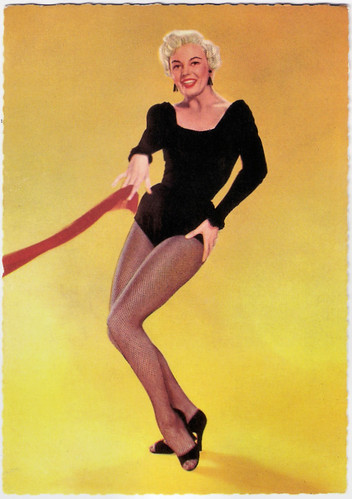
German postcard by ISV, no. A 27. Photo: 20th Century Fox. Publicity still for The Best Things in Life Are Free (Michael Curtiz, 1956).
Usually playing a tough, sexy dame or hard edge, world-weary type
Sheree North's career stalled. She made occasional appearances on TV over the next 10 years, in such programs as Gunsmoke (1963), The Virginian (1964-1966), Burke's Law (1963-1965), The Big Valley (1966), The Fugitive (1965-1967), and more.
North joined the stage cast of 'I Can Get It for You Wholesale' in 1962, which featured Elliott Gould and introduced Barbra Streisand. North took over for Shirley Knight in a Los Angeles production of 'Dutchman', which coincided with the 1965 Watts riots. The production was controversial and was blamed by conservatives for inciting unrest. It was picketed, ads were blocked from the newspapers and North's car was set on fire. Despite that, the production ran for a year.
From 1959 to 1968, she appeared in only one feature film, the low budget Sci-Fi flick Destination Inner Space (Francis D. Lyon, 1966) with Scott Brady.
In 1968 she began her longtime association with director Don Siegel, appearing in a supporting role in the cop drama Madigan (Don Siegel, 1968) with Richard Widmark and Henry Fonda. Siegel went on to cast in her in some of her best screen roles.
She usually played a tough, sexy dame or hard edge, world-weary type. That meant a slew of strippers, hookers, widows, cocktail waitresses, trampy housewives, etc. North's other work with Siegel included the brassy forger Jewell Everett in Charley Varrick (Don Siegel, 1973), John Wayne's former flame Serepata in The Shootist (Don Siegel, 1973) and a brainwashed Soviet spy/housewife in Telefon (Don Siegel, 1977).
With Elvis Presley, North played in one of his final films, The Trouble With Girls (Peter Tewksbury, 1969).
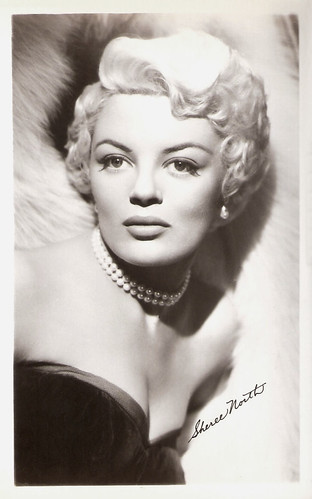
Vintage postcard.
Blanche Devereaux's sister Virginia
From 1969 to the late 1970s, Sheree North was an in-demand supporting player on the big screen. She played a nameless waitress/stripper who sleeps with Gene Hackman in John Frankenheimer's forgotten gem The Gypsy Moths (1969), and a former romantic interest of Burt Lancaster , now trying to save her common-law fugitive husband in the Western Lawman (Michael Winner, 1971).
Then followed such roles as a security guard's drug dealing wife in The Organization (Don Medford, 1971) with Sidney Poitier as Virgil Tibbs, the slutty wife of Bill McKinney in the crime drama classic The Outfit (John Flynn, 1973), and the sexy hairdresser Myrna in Breakout (Tom Gries, 1975) with Charles Bronson .
Through the 1980s and 1990s, she made numerous appearances on TV and appeared in an occasional feature film like Maniac Cop (William Lustig, 1988) and Defenseless (Martin Campbell, 1991), starring Barbara Hershey.
In her later career, she was best known for playing Babs, Kramer's (Michael Richards) mom, on Seinfeld (1995-1998). Her many other TV credits include: Lou Grant's girlfriend with 'spunk' on The Mary Tyler Moore Show (1970), Alias Smith and Jones (1972), Kung Fu (1973), McMillan & Wife (1973), Baretta (1977), Matlock (1986) and The Golden Girls (1985-1989), as Blanche Devereaux's (Rue McClanahan) sister, Virginia.
She also played Norma Jean Baker's unbalanced mom in Marilyn: The Untold Story (Jack Arnold, John Flynn, 1980), Her appearances on Marcus Welby, M.D. (1969) and Archie Bunker's Place (1979) netted her Emmy Nominations. North's last onscreen role came in John Landis' black comedy Susan's Plan (1998), starring Nastassja Kinski .
Sheree North was married four times, to Phillip Alan Norman, Dr. Gerhardt Ralph Sommer, John M. 'Bud' Freeman and Frederick Arnold Bessire Jr. and she had two daughters, Dawn Jeanette Bessire (1949) and Erica Eve Sommer (1959), from different marriages. Emmy Award-winning film title designer Phill Norman had been her companion from 1981 and they married in 2003, two years before her death. Sheree North died during cancer surgery in 2005. She was 73.
Sheree North's 'original Tiger Dance', which created a scandal in 1954. Source: Stone Marble AcMa (YouTube).
Sources: Scott Rollins (The Scott Rollins Film and TV Trivia Blog), Wikipedia and

French postcard by Editions du Globe, Paris, no. 553. Photo: 20th Century Fox.
A brush with scandal
Sheree North was born Dawn Shirley Crang in 1932 in Los Angeles. She was the daughter of June Shoard and Richard Crang. Following her mother's remarriage to Edward Bethel, she was known as Dawn Shirley Bethel.
North began taking dance lessons at age 6. At age 10 she danced in several USO shows during WWII. At age 13 she lied about her age so she could become a chorus girl. In 1948, she married Fred Bessire. She bore her first child at age 17 in 1949, and continued dancing in clubs under the stage name Shirley Mae Bessire.
North made her film debut as an uncredited extra in the Red Skelton comedy Excuse My Dust (Roy Rowland, 1951). She was discovered in a Santa Monica night club by a famous choreographer who cast her as a chorus girl in the film Here Come the Girls (Claude Binyon, 1953), starring Bob Hope. Around that time, she adopted the stage name Sheree North.
She made her Broadway debut in the musical Hazel Flagg. For her performance, she won a 1953 Theatre World Award. She reprised her role in the film version, Living It Up (Norman Tautog, 1954) with Dean Martin and Jerry Lewis. In 1954, North signed a four-year contract with 20th Century-Fox.
In March 1954, North had a brush with scandal when it was revealed that she had earlier danced a 'Tiger Dance' in a bikini in an 8 mm erotic film. Fox capitalised on the publicity as the studio previously had with Marilyn Monroe 's nude calendar posing in 1952. She became Fox's alternative to MM. When she was pictured on the cover of the 21 March 1955, issue of Life magazine, the headline read, "Sheree North Takes Over From Marilyn Monroe ".
She appeared in such Box Office friendly entertainments as the musicals How to be very, very popular (Nunnally Johnson, 1955) with Betty Grable in her final role, and The Best Things in Life are Free (Michael Curtiz, 1956) with Gordon MacRae, Dan Dailey and Ernest Borgnine, as well as the comedy The Lieutenant wore Skirts (Frank Tashlin, 1956) with Tom Ewell.
Fox later signed Jayne Mansfield in 1956 and North was pushed aside by the studio. She appeared in four more forgettable Fox films - The Way to the Gold (Robert D. Webb, 1957), No Down Payment (Martin Ritt, 1957) with Joanne Woodward, In Love and War (Philip Dunne, 1958), and Mardi Gras (Edmund Goulding, 1958) with Pat Boone. Her contract was not renewed after 1958.

German postcard by ISV, no. A 27. Photo: 20th Century Fox. Publicity still for The Best Things in Life Are Free (Michael Curtiz, 1956).
Usually playing a tough, sexy dame or hard edge, world-weary type
Sheree North's career stalled. She made occasional appearances on TV over the next 10 years, in such programs as Gunsmoke (1963), The Virginian (1964-1966), Burke's Law (1963-1965), The Big Valley (1966), The Fugitive (1965-1967), and more.
North joined the stage cast of 'I Can Get It for You Wholesale' in 1962, which featured Elliott Gould and introduced Barbra Streisand. North took over for Shirley Knight in a Los Angeles production of 'Dutchman', which coincided with the 1965 Watts riots. The production was controversial and was blamed by conservatives for inciting unrest. It was picketed, ads were blocked from the newspapers and North's car was set on fire. Despite that, the production ran for a year.
From 1959 to 1968, she appeared in only one feature film, the low budget Sci-Fi flick Destination Inner Space (Francis D. Lyon, 1966) with Scott Brady.
In 1968 she began her longtime association with director Don Siegel, appearing in a supporting role in the cop drama Madigan (Don Siegel, 1968) with Richard Widmark and Henry Fonda. Siegel went on to cast in her in some of her best screen roles.
She usually played a tough, sexy dame or hard edge, world-weary type. That meant a slew of strippers, hookers, widows, cocktail waitresses, trampy housewives, etc. North's other work with Siegel included the brassy forger Jewell Everett in Charley Varrick (Don Siegel, 1973), John Wayne's former flame Serepata in The Shootist (Don Siegel, 1973) and a brainwashed Soviet spy/housewife in Telefon (Don Siegel, 1977).
With Elvis Presley, North played in one of his final films, The Trouble With Girls (Peter Tewksbury, 1969).

Vintage postcard.
Blanche Devereaux's sister Virginia
From 1969 to the late 1970s, Sheree North was an in-demand supporting player on the big screen. She played a nameless waitress/stripper who sleeps with Gene Hackman in John Frankenheimer's forgotten gem The Gypsy Moths (1969), and a former romantic interest of Burt Lancaster , now trying to save her common-law fugitive husband in the Western Lawman (Michael Winner, 1971).
Then followed such roles as a security guard's drug dealing wife in The Organization (Don Medford, 1971) with Sidney Poitier as Virgil Tibbs, the slutty wife of Bill McKinney in the crime drama classic The Outfit (John Flynn, 1973), and the sexy hairdresser Myrna in Breakout (Tom Gries, 1975) with Charles Bronson .
Through the 1980s and 1990s, she made numerous appearances on TV and appeared in an occasional feature film like Maniac Cop (William Lustig, 1988) and Defenseless (Martin Campbell, 1991), starring Barbara Hershey.
In her later career, she was best known for playing Babs, Kramer's (Michael Richards) mom, on Seinfeld (1995-1998). Her many other TV credits include: Lou Grant's girlfriend with 'spunk' on The Mary Tyler Moore Show (1970), Alias Smith and Jones (1972), Kung Fu (1973), McMillan & Wife (1973), Baretta (1977), Matlock (1986) and The Golden Girls (1985-1989), as Blanche Devereaux's (Rue McClanahan) sister, Virginia.
She also played Norma Jean Baker's unbalanced mom in Marilyn: The Untold Story (Jack Arnold, John Flynn, 1980), Her appearances on Marcus Welby, M.D. (1969) and Archie Bunker's Place (1979) netted her Emmy Nominations. North's last onscreen role came in John Landis' black comedy Susan's Plan (1998), starring Nastassja Kinski .
Sheree North was married four times, to Phillip Alan Norman, Dr. Gerhardt Ralph Sommer, John M. 'Bud' Freeman and Frederick Arnold Bessire Jr. and she had two daughters, Dawn Jeanette Bessire (1949) and Erica Eve Sommer (1959), from different marriages. Emmy Award-winning film title designer Phill Norman had been her companion from 1981 and they married in 2003, two years before her death. Sheree North died during cancer surgery in 2005. She was 73.
Sheree North's 'original Tiger Dance', which created a scandal in 1954. Source: Stone Marble AcMa (YouTube).
Sources: Scott Rollins (The Scott Rollins Film and TV Trivia Blog), Wikipedia and
Published on May 18, 2019 22:00
May 17, 2019
Photo by Gaumont-British
The Gaumont British Picture Corporation (GB) was a company that produced and distributed films and operated a cinema chain in the United Kingdom. In the 1930s, it was the largest film company in the UK, employing 16,000 people. Among the studio's best known films are two of Alfred Hitchcock's classic British thrillers, The 39 Steps (1935) and The Lady Vanishes (1938). Major stars of the studio were Jessie Matthews, Robert Donat, Madeleine Carroll, Conrad Veidt, Jack Hulbert, Cicely Courtneidge, Gordon Harker, and many others. Gaumont and its subsidiary Gainsborough produced 721 films.
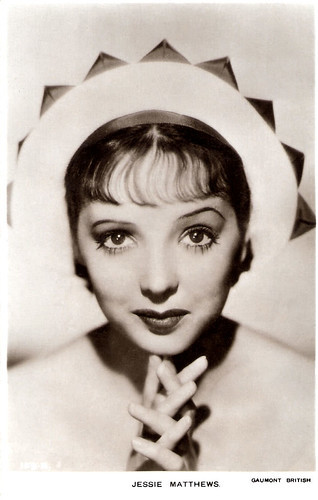
British postcard, no. 159b. Photo: Gaumont-British.
Saucer-eyed, long-legged Jessie Matthews (1907-1981) was a gamine, graceful dancer, with a sweet, pure-toned singing voice, and waif-like sex appeal, who embodied 1930s style. For most of the decade, she was the most popular musical star in England.
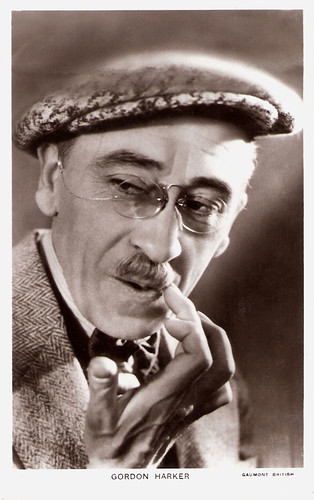
British postcard in the Picturegoer Series, no. 717. Photo: Gaumont-British.
Gordon Harker (1885-1967) was a popular English film actor who specialised in Cockney roles. Throughout the 1930s and 1940s, he seemed to appear in every crime film produced in England, including four directed by Alfred Hitchcock.
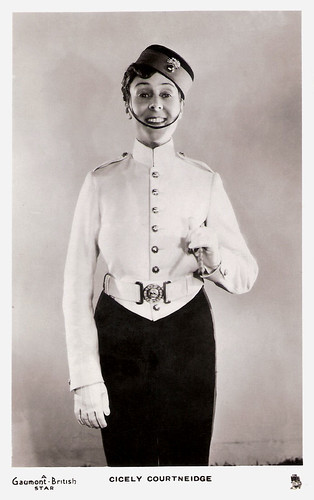
British postcard by Raphael Tuck & Sons, no. 14. Photo: Gaumont-British.
Cicely Courtneidge (1893–1980) was an elegantly knockabout comedienne. For 62 years, she formed a husband and wife team with comedian Jack Hulbert on stage, radio, TV and in the cinema. During the 1930s she also starred in eleven British films and one disastrous American production.
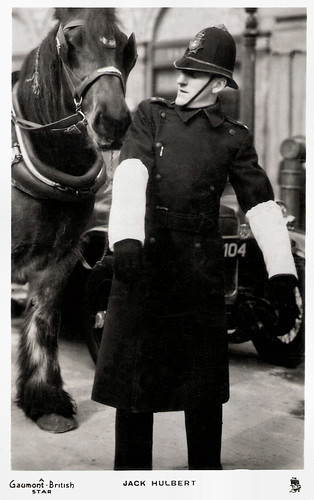
British postcard by Raphael Tuck & Sons 'Real Photograph', no. 15. Photo: Gaumont-British.
Jack Hulbert (1892-1978) was a popular comedian of the 1930s with a trademark chiseled chin. In his musicals he often appeared with his wife Cicely Courtneidge.
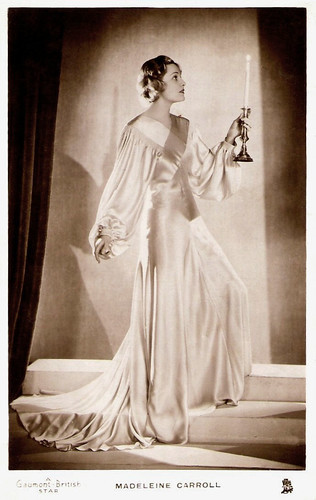
British postcard by Raphael Tuck & Sons in the Real Photograph Series, no. 7-8. Photo: Gaumont-British.
Madeleine Carroll (1906–1987) was a blonde beauty of ladylike demeanour. The first of Alfred Hitchcock's ‘ice-cool blondes’ was immensely popular in the 1930s and 1940s, and was nicknamed 'The Queen of British Cinema'.
Gaumont Film production
Gaumont-British was founded by Frenchman Leon Gaumont in 1898 as the British subsidiary of the French Gaumont Film Company. The first studio was established at Freeman's Cricket Field in Dulwich. The first director was Alfred Collins. Many successful films, like A Runaway Match (Alfred Collins, 1903), Lost! A Leg of Mutton (Alfred Collins, 1906), Curfew Shall Not Ring To-night (Arthur Gilbert, 1907), and Napoleon and the English Sailor (Alfred Collins, 1908) with Herbert Darnley, were made at Dulwich, and England was at the time the chief supplier of films for the American market.
Gaumont invented the Chronophone and the Chronochrome. The Chronophone involved a synchronised gramophone disc sounding together with the silent picture, to produce a talking picture as early as 1902. The Chronochrome, introduced in 1913, was an equally successful attempt at reproduction in natural colours by the simultaneous projection of three pictures through a coloured screen in green, red and purple violet.
Gaumont recorded several important topical events. Gaumont decided that production must be undertaken on a far larger scale in England than ever before. More extensive studios were necessary, and the first British building solely for the purpose of film production was erected with the most modern equipment and laboratories on the same site at Lime Grove in Shepherd's Bush. The first automatic film printing works set up at Lime Grove for world-wide trade in 1912.
In 1913 Gaumont distributed the first feature length film in England. It was the Messter Film production Richard Wagner/The Life of Richard Wagner (Carl Froelich, William Wauer, 1913), with an elaborate musical setting provided by the London Symphony Orchestra under the direction of Sir Landon Ronald.
George Pearson directed for Gaumont-British the four part serial Ultus, the Man from the Dead (George Pearson, 1915) starring Aurele Sydney a.k.a. Aurelio Sidney. The film was so successful that a series of Ultus pictures was made. This series was followed by Sally Bishop (George Pearson, 1916) with Marjorie Villis, Aurele Sydney and Peggy Hyland .
During the First World War, the British Government took over the building and the studio was used for research and propaganda purposes, although film production was permitted to continue part-time. Thus the Shepherd's Bush Studios not only assisted in the propagation of the war, but also provided entertainment for a war-weary public such as a film version of H. G. Wells's The First Men in the Moon (Bruce Gordon, J.L.V. Leigh, 1919).
After the war, the British industry appeared completely crushed.
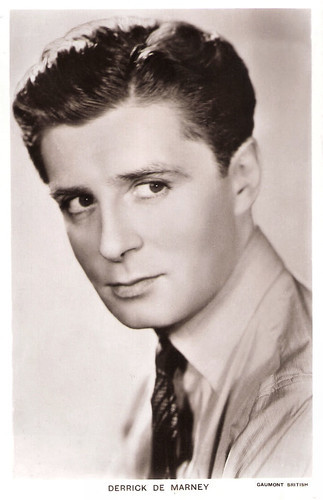
British postcard in the Picturegoer Series, no. 1193. Photo: Gaumont-British.
Derrick De Marney (1906–1978) was a handsome and versatile English stage and film actor. Today, he is best known for his starring role as Robert Tisdall, wrongly accused of murder in Alfred Hitchcock's Young and Innocent (1937).
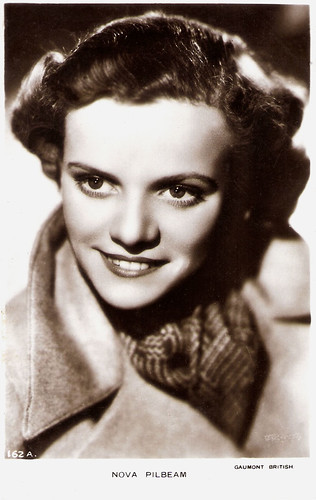
British postcard, no. 162 A. Photo: Gaumont-British.
As a teenager Nova Pilbeam played in two Alfred Hitchcock classics, The Man Who Knew Too Much (1934) and Young and Innocent (1937). In 1948 she vanished from the British cinema.
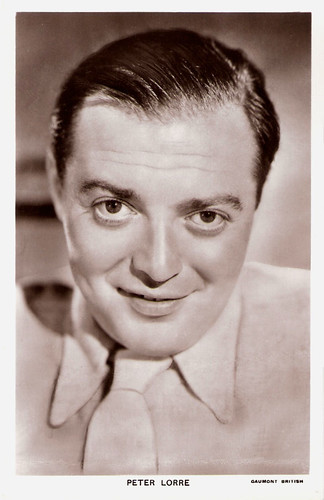
British postcard in the Picturegoer Series, London, no. 1033. Photo: Gaumont-British.
Peter Lorre (1904–1964) with his trademark large, popped eyes, his toothy grin and his raspy voice was an American actor of Jewish Austro-Hungarian descent. He was an international sensation as the psychopathic child murderer in Fritz Lang’s M (1931). He later became a popular actor in a two British Hitchcock films and in a series of Hollywood crime films and mysteries.

British postcard in the Picturegoer Series, London, no. 880b. Photo: Gaumont-British.
Blue-eyed blonde Anna Lee (1913-2004) was a British-born American actress. She started her career in British films and earned the title 'Queen of the Quota Quickies'. In 1939, she moved to Hollywood with her husband, director Robert Stevenson.
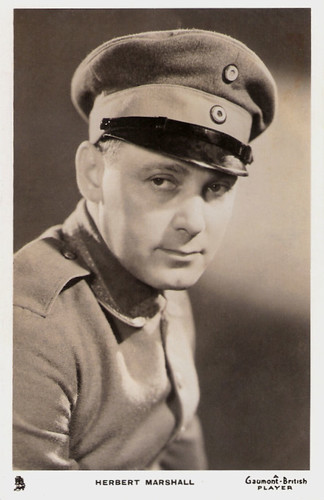
British postcard by Raphael Tuck & Sons in the Real Photograph Series, no. 176. Photo: Gaumont-British.
Herbert Marshall (1890-1966), was a popular English cinema and theatre actor. He overcame the loss of a leg in World War I to enjoy a long career in Hollywood, first as a romantic lead opposite stars like Marlene Dietrich and Greta Garbo, later as a fine character actor.
Gainsborough and Gaumont
The British subsidiary of Gaumont became independent in 1922 when Leon Gaumont sold the control of the company to Isidore Ostrer. Born in 1889 to a humble Jewish family in Whitechapel, Ostrer had made his first fortune in textiles during World War 1, then he established a private bank, and in 1922 he took over the Gaumont film company and renamed it Gaumont-British.
Ostrer engaged his four brothers to run the company with him. He made his brother Maurice Ostrer director of both the corporation and the sister company Gainsborough studios, where Maurice acted in the capacity of executive film producer. Brother Mark Ostrer was the chairman, who oversaw the 343 cinemas, theatres, dance halls, and restaurants owned, controlled or managed by the corporation and associated companies.
Fourth brother, Harry Ostrer, who had been a school teacher, worked with scripts. His daughter became 'the Gainsborough lady', who nodded her head at the beginning of each film. The fifth brother, David Ostrer, worked in distribution. Years later, his son, Bertram Ostrer, produced a few films independently, including Dentist in the Chair (Don Chaffey, 1960) starring Bob Monkhouse, Dentist on the Job (C.M. Pennington-Richards, 1961), and Captain Nemo and the Underwater City (James Hill, 1969) with Robert Ryan.
The first film under the Gainsborough banner was released in 1924. Four years later, Gainsborough Pictures Limited was established as one of the associated production companies within the Gaumont-British Picture Corporation Limited. During this period films were produced under both banners, Gaumont and Gainsborough. The Gaumont banner was dropped in 1938, and all films produced from 1938 to 1950 were under the Gainsborough banner. (Next week, EFSP will do a post on Gainsborough).
In 1927 a leading silent film studio, the Ideal Film Company, merged with Gaumont. After a few years, sound film arrived. The film industry was immensely boosted by the arrival of talkies in 1929, and cinema attendance also rose because of audiences' need for mental escape from the bad economic times and the growing troubles in Europe.
Maurice Elvey was directing High Treason (Maurice Elvey, 1929) with Benita Hume and Basil Gill . when sound film arrived and the film had to be turned into a 'talkie' under difficult conditions. Sound-proofing had to be done while the film was actually being made.
In the summer of 1931, during Victor Saville's direction of the sound film version of Hindle Wakes (Victor Saville, 1931) with Sybil Thorndike and John Stuart , the new condenser microphone of British Acoustic was first used. Since that date all Gaumont-British productions used this apparatus.
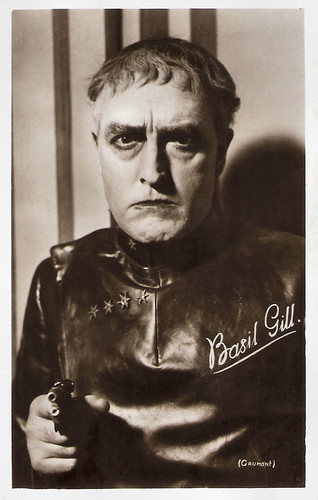
British postcard issued with Sarony Cigarettes, no. 67 of a second series of 42 Cinema Stars. Photo: Gaumont. Publicity still for High Treason (Maurice Elvey, 1929) with Basil Gill .
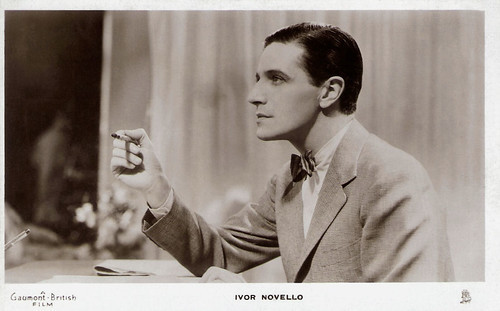
British postcard by Raphael Tuck & Sons, London, no. 50-S. Photo: Gaumont-British. Ivor Novello in Love and Let Love/Sleeping Car (Anatole Litvak, 1933).
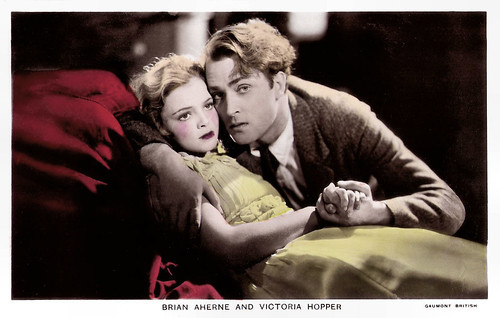
British Real Photograph postcard in the Film Partners series, no. P 121. Photo: Gaumont-British. Brian Aherne and Victoria Hopper in The Constant Nymph (Basil Dean, 1933).
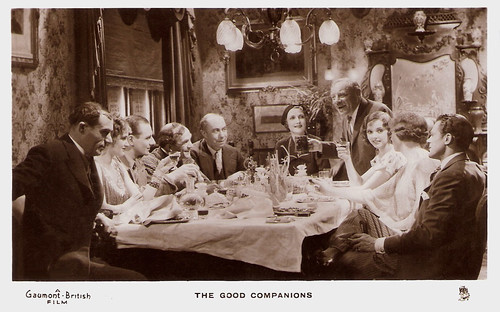
British postcard by Raphael Tuck & Sons in the Real Photograph Series, no. 27-B. Photo: Gaumont-British. Publicity still for The Good Companions (Victor Saville, 1933) with a.o. John Gielgud (third from left), A.W. Baskcomb (fifth from left) and Jessie Matthews (third from right).
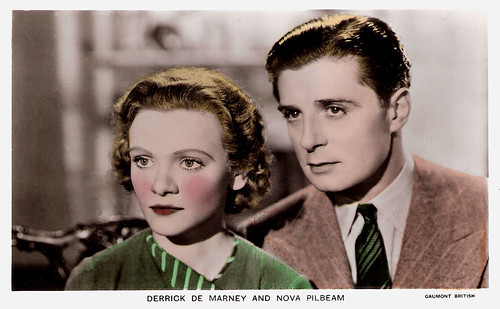
British hand-coloured postcard in the Film Partners Series, no PC 236. Photo: Gaumont-British. Derrick De Marney and Nova Pilbeam in Young and Innocent/The Girl Was Young (Alfred Hitchcock, 1937).
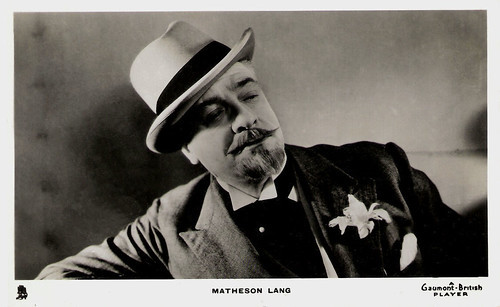
British postcard by Raphael Tuck & Sons (Real Photograph), no. 166. Photo: Gaumont-British.
Tall and good-looking Matheson Lang (1879-1948) was a Canadian-born stage and film actor and playwright. He is best known for his Shakespearean roles in British productions of Hamlet, Macbeth, and Romeo and Juliet and for his role as Mr. Wu in the early 20th century. He was one of the first major stars of the British theatre who acted in a silent film. During the 1920s, he became a popular film star in Great Britain.
Gaumont British
Gaumont-British (GB) moved into its decade of glory, the 1930s. GB dominated the British film industry with its large chain of cinemas and its vast studio complex at Lime Grove. The company employed 16,000 people. Amongst the directors were Victor Saville, Walter Forde, William Thiele, Anthony Asquith, Sinclair Hill, and Alfred Hitchcock. Several other internationally known names were added later.
Alfred Hitchcock directed eleven films for Gaumont and Gainsborough. Before his directing debut, he adapted the screenplays for three Gainsborough films in 1924 and 1925. He then directed five Gainsborough films in 1926 and 1927. After a six year absence, he directed five Gaumont films between 1934 and 1937, including his adaptation of The 39 Steps (Alfred Hitchcock, 1935), starring Robert Donat and Madeleine Carroll . In 1938, Hitchcock directed one more Gainsborough film, The Lady Vanishes (Alfred Hitchcock, 1938) with Margaret Lockwood and Michael Redgrave .
The list of actors and actresses on contract by GB in were of equal distinction, including Jack Hulbert, Cicely Courtneidge , Gordon Harker , John Stuart , Belle Chrystall, Renate Müller , Fred Kerr, Sonnie Hale, and Edmund Gwenn.
Early in 1932, GB quietly took over Baird Television Ltd. which had become financially precarious. As a result, Baird Television received a badly-needed infusion of capital which enabled it to hire scientists with expertise in the new technology of electronic television, and to move to the Crystal Palace where a fully equipped television studio and ultra short wave transmitter was set up.
After a boardroom coup in 1933, Nigel Ostrer's position as managing director became nominal. Under the new arrangement he did research on large-screen and colour television. The Ostrers felt that television could be part of his film empire, with live telecasts of sporting events being shown on cinema screens as an accompaniment to the main feature film.
In the United States, Gaumont-British had its own distribution operation for its films until December 1938, when it outsourced distribution to 20th Century Fox.
At the outbreak of the Second World War, all television was shut down. GB came under scrutiny by a Board of Trade enquiry and Ostrer also felt threatened by the possibility of German invasion. In 1940 he was named on the infamous Nazi death list of people they thought to be a danger, including Winston Churchill, J.B. Priestly and Noel Coward.
In 1941, rival film magnate J. Arthur Rank of the Rank Organisation bought Gaumont-British and its sister company Gainsborough Pictures. Isidore Ostrer moved to the USA for the war years and though he eventually returned to Britain he never made a major comeback in the film industry. His business interest returned to the textile industry in which he had started many years earlier. He lived on until 1975 in semi-seclusion.
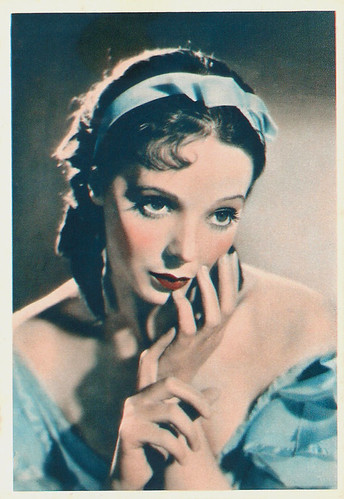
British collectors card by De Reszke Cigarettes, no. 9. Photo: Gaumont-British. Jessie Matthews in Waltzes from Vienna (Alfred Hitchcock, 1934).
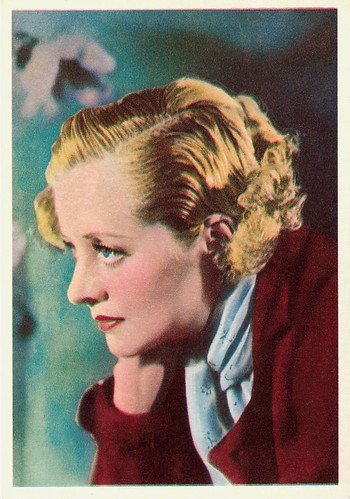
British postcard by De Reszke Cigarettes, no. 21. Photo: Gaumont-British.
Evelyn Laye (1900–1996) was one of England's most popular stars of musical revue and operetta during the 1920s. She did a few screen appearances in both London and Hollywood, including in the classic musical Evensong (Victor Saville, 1934).
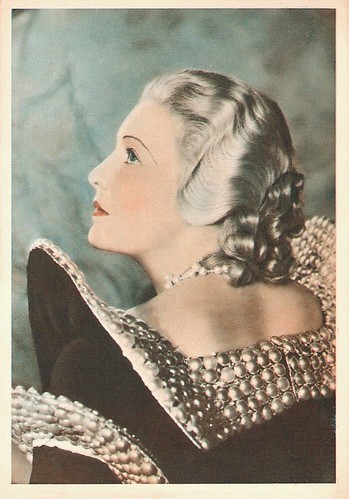
British postcard by De Reszke Cigarettes, no. 32. Photo: Gaumont-British. Madeleine Carroll in The Dictator/Loves of a Dictator (Victor Saville, 1935).
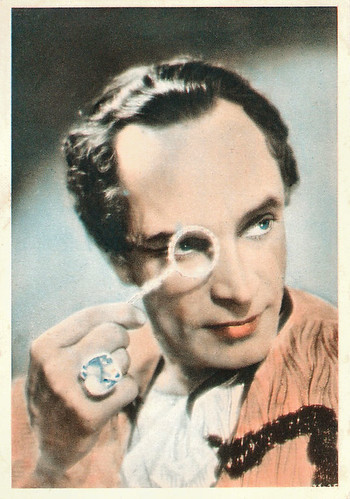
British postcard by De Reszke Cigarettes, no. 33. Photo: Gaumont-British. Conrad Veidt in Jew Süss (Lothar Mendes, 1934).
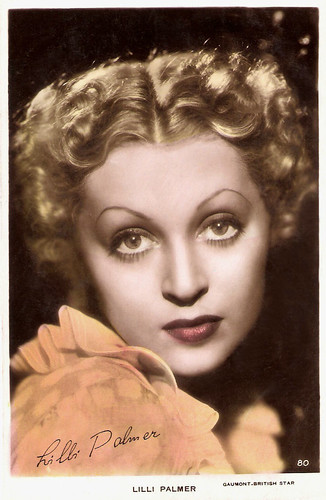
British postcard by Art Card, no. 80. Photo: Gaumont-British. This card dates from the years Lilli Palmer played in Alfred Hitchcock's Secret Agent (1936).
Gaumont cinemas
Gaumont-British developed or acquired large 'super-cinemas' such as the New Victoria (later Gaumont and finally Odeon) in Bradford opened in 1930, the Gaumont in Manchester opened in 1935, and the Gaumont State Cinema in Kilburn, London, opened in 1937.
The corporation also took over many smaller cinemas across the country, eventually owning 343 properties. One such property was the Holderness Hall in Hull, built by the pioneering William Morton in 1912 and managed by him until 1930 when he could no longer compete.
Many of the Gaumont cinemas had a theatre organ for entertainment before the show, in the intervals, or after the show. The name 'Gaumont' was adopted to describe the style of the flat-top organ console case (originally for the Pavilion Theatre, Shepherd's Bush), for some Compton organs built from October 1931 to 1934.
In 1941, after the take-over by Rank, all Gaumont cinemas were rebranded as Odeon cinemas. Cinema exhibition in the UK was characterised by alignments between exhibitors and distributors. After the Odeon and Gaumont takeovers, Rank had access to the product of 20th Century Fox, Paramount, Disney, Columbia, Universal, United Artists and its own film productions. Rival ABC had only Warner Brothers, MGM and its own ABPC productions but both also took films from smaller distributors.
With ample supply of product, Rank maintained the separate Odeon and Gaumont release pattern for many years. Some Odeon cinemas were renamed Gaumont when transferred to Gaumont release. As attendances declined during the 1950s many cinemas on all circuits were closed and eventually, the booking power of the Gaumont circuit declined. In January 1959 Rank restructured its exhibition operation and combined the best Gaumonts and the best Odeons in a new Rank release, while the rest were given a new 'National' release.
In 1961, Paramount objected to Rank consigning its Dean Martin comedy All in a Night's Work (Joseph Anthony, 1961) to the national circuit and henceforth switched its allegiance to the ABC circuit. With the continuing decline in attendances and cinema numbers, the National release died on its feet and henceforth there were two release patterns, Rank and ABC.
There was no reason to perpetuate the Gaumont name and in towns that lost their Odeon, the Gaumont was usually renamed Odeon within a couple of years of the latter's closure. Even so, the Gaumont name continued to linger until, in January 1987, the last Gaumont, in Doncaster, was renamed Odeon.
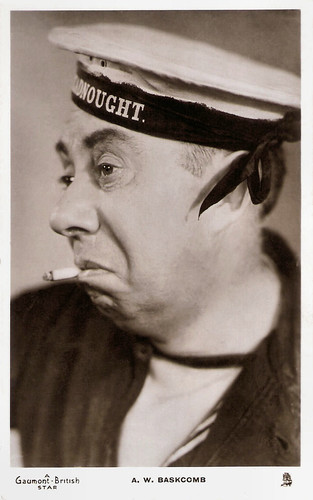
British postcard by Raphael Tuck & Sons' Real Photograph, no. 42-S. Photo: Gaumont-British.
A.W. Baskcomb (1880-1939) is best remembered for his creation of the part of ‘Slightly’ in the very first stage production of J.M. Barrie's Peter Pan (1904). He created a major character out of an underwritten part and went on to play it for seven years. At the end of his career he became briefly a popular film star.
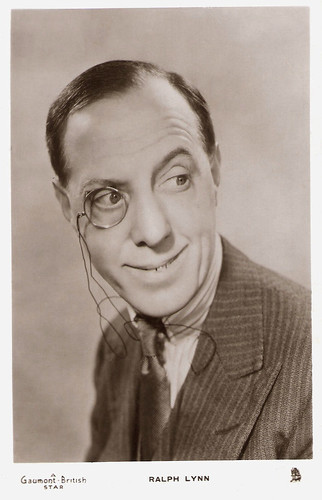
British postcard by Raphael Tuck & Sons' Real Photograph, London, no. 30-S. Photo: Gaumont-British.
British actor Ralph Lynn (1882-1962) was a tweedy, dark-haired comedian who made a stage career out of playing monocled silly ass twits. He was a veteran performer of London's highly popular Aldwych Repertory Theatre farces, and he and fellow members Tom Walls and Robertson Hare successfully took many of their stylised productions to the big screen in the 1930s.
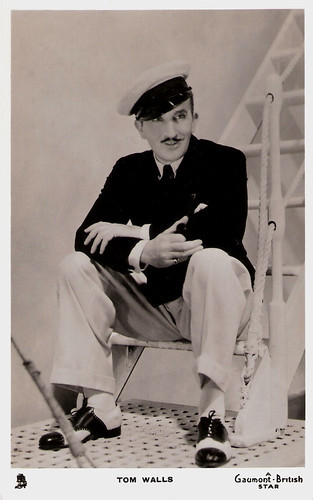
British postcard by Raphael Tuck & Sons, Real Photograph Postcard, no. 178. Photo: Gaumont-British.
English actor Tom Walls (1883-1949) was a popular character player on stage and in films, and also worked as a film director. He is indelibly associated with the popular Aldwych Theatre farces of the 1920s and 1930s and was one of the most influential figures in British comedy.
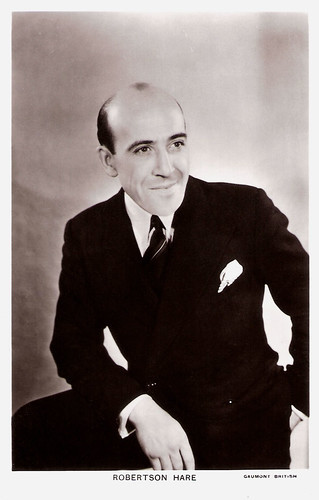
British postcard in the Picturegoer Series, no. 947a. Photo: Gaumont-British.
Robertson Hare (1891-1979) was an English actor, who came to fame in the Aldwych farces between 1923 and 1933. Bald, short and fussy, Hare made his career in character roles, often as a figure of put-upon respectability.
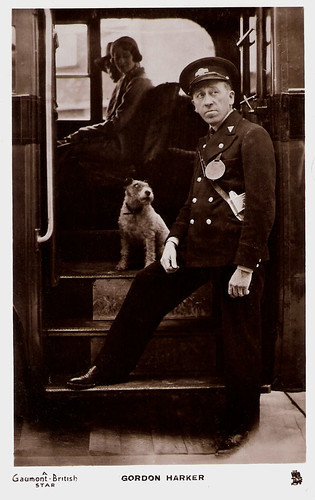
British Real Photograph postcard by Raphael Tuck & Sons, no. 19-S. Photo: Gaumont-British. Gordon Harker in Love On Wheels (Victor Saville, 1932).
Sources: Nigel Ostrer (The Ostrers and Gaumont British), Wikipedia and .

British postcard, no. 159b. Photo: Gaumont-British.
Saucer-eyed, long-legged Jessie Matthews (1907-1981) was a gamine, graceful dancer, with a sweet, pure-toned singing voice, and waif-like sex appeal, who embodied 1930s style. For most of the decade, she was the most popular musical star in England.

British postcard in the Picturegoer Series, no. 717. Photo: Gaumont-British.
Gordon Harker (1885-1967) was a popular English film actor who specialised in Cockney roles. Throughout the 1930s and 1940s, he seemed to appear in every crime film produced in England, including four directed by Alfred Hitchcock.

British postcard by Raphael Tuck & Sons, no. 14. Photo: Gaumont-British.
Cicely Courtneidge (1893–1980) was an elegantly knockabout comedienne. For 62 years, she formed a husband and wife team with comedian Jack Hulbert on stage, radio, TV and in the cinema. During the 1930s she also starred in eleven British films and one disastrous American production.

British postcard by Raphael Tuck & Sons 'Real Photograph', no. 15. Photo: Gaumont-British.
Jack Hulbert (1892-1978) was a popular comedian of the 1930s with a trademark chiseled chin. In his musicals he often appeared with his wife Cicely Courtneidge.

British postcard by Raphael Tuck & Sons in the Real Photograph Series, no. 7-8. Photo: Gaumont-British.
Madeleine Carroll (1906–1987) was a blonde beauty of ladylike demeanour. The first of Alfred Hitchcock's ‘ice-cool blondes’ was immensely popular in the 1930s and 1940s, and was nicknamed 'The Queen of British Cinema'.
Gaumont Film production
Gaumont-British was founded by Frenchman Leon Gaumont in 1898 as the British subsidiary of the French Gaumont Film Company. The first studio was established at Freeman's Cricket Field in Dulwich. The first director was Alfred Collins. Many successful films, like A Runaway Match (Alfred Collins, 1903), Lost! A Leg of Mutton (Alfred Collins, 1906), Curfew Shall Not Ring To-night (Arthur Gilbert, 1907), and Napoleon and the English Sailor (Alfred Collins, 1908) with Herbert Darnley, were made at Dulwich, and England was at the time the chief supplier of films for the American market.
Gaumont invented the Chronophone and the Chronochrome. The Chronophone involved a synchronised gramophone disc sounding together with the silent picture, to produce a talking picture as early as 1902. The Chronochrome, introduced in 1913, was an equally successful attempt at reproduction in natural colours by the simultaneous projection of three pictures through a coloured screen in green, red and purple violet.
Gaumont recorded several important topical events. Gaumont decided that production must be undertaken on a far larger scale in England than ever before. More extensive studios were necessary, and the first British building solely for the purpose of film production was erected with the most modern equipment and laboratories on the same site at Lime Grove in Shepherd's Bush. The first automatic film printing works set up at Lime Grove for world-wide trade in 1912.
In 1913 Gaumont distributed the first feature length film in England. It was the Messter Film production Richard Wagner/The Life of Richard Wagner (Carl Froelich, William Wauer, 1913), with an elaborate musical setting provided by the London Symphony Orchestra under the direction of Sir Landon Ronald.
George Pearson directed for Gaumont-British the four part serial Ultus, the Man from the Dead (George Pearson, 1915) starring Aurele Sydney a.k.a. Aurelio Sidney. The film was so successful that a series of Ultus pictures was made. This series was followed by Sally Bishop (George Pearson, 1916) with Marjorie Villis, Aurele Sydney and Peggy Hyland .
During the First World War, the British Government took over the building and the studio was used for research and propaganda purposes, although film production was permitted to continue part-time. Thus the Shepherd's Bush Studios not only assisted in the propagation of the war, but also provided entertainment for a war-weary public such as a film version of H. G. Wells's The First Men in the Moon (Bruce Gordon, J.L.V. Leigh, 1919).
After the war, the British industry appeared completely crushed.

British postcard in the Picturegoer Series, no. 1193. Photo: Gaumont-British.
Derrick De Marney (1906–1978) was a handsome and versatile English stage and film actor. Today, he is best known for his starring role as Robert Tisdall, wrongly accused of murder in Alfred Hitchcock's Young and Innocent (1937).

British postcard, no. 162 A. Photo: Gaumont-British.
As a teenager Nova Pilbeam played in two Alfred Hitchcock classics, The Man Who Knew Too Much (1934) and Young and Innocent (1937). In 1948 she vanished from the British cinema.

British postcard in the Picturegoer Series, London, no. 1033. Photo: Gaumont-British.
Peter Lorre (1904–1964) with his trademark large, popped eyes, his toothy grin and his raspy voice was an American actor of Jewish Austro-Hungarian descent. He was an international sensation as the psychopathic child murderer in Fritz Lang’s M (1931). He later became a popular actor in a two British Hitchcock films and in a series of Hollywood crime films and mysteries.

British postcard in the Picturegoer Series, London, no. 880b. Photo: Gaumont-British.
Blue-eyed blonde Anna Lee (1913-2004) was a British-born American actress. She started her career in British films and earned the title 'Queen of the Quota Quickies'. In 1939, she moved to Hollywood with her husband, director Robert Stevenson.

British postcard by Raphael Tuck & Sons in the Real Photograph Series, no. 176. Photo: Gaumont-British.
Herbert Marshall (1890-1966), was a popular English cinema and theatre actor. He overcame the loss of a leg in World War I to enjoy a long career in Hollywood, first as a romantic lead opposite stars like Marlene Dietrich and Greta Garbo, later as a fine character actor.
Gainsborough and Gaumont
The British subsidiary of Gaumont became independent in 1922 when Leon Gaumont sold the control of the company to Isidore Ostrer. Born in 1889 to a humble Jewish family in Whitechapel, Ostrer had made his first fortune in textiles during World War 1, then he established a private bank, and in 1922 he took over the Gaumont film company and renamed it Gaumont-British.
Ostrer engaged his four brothers to run the company with him. He made his brother Maurice Ostrer director of both the corporation and the sister company Gainsborough studios, where Maurice acted in the capacity of executive film producer. Brother Mark Ostrer was the chairman, who oversaw the 343 cinemas, theatres, dance halls, and restaurants owned, controlled or managed by the corporation and associated companies.
Fourth brother, Harry Ostrer, who had been a school teacher, worked with scripts. His daughter became 'the Gainsborough lady', who nodded her head at the beginning of each film. The fifth brother, David Ostrer, worked in distribution. Years later, his son, Bertram Ostrer, produced a few films independently, including Dentist in the Chair (Don Chaffey, 1960) starring Bob Monkhouse, Dentist on the Job (C.M. Pennington-Richards, 1961), and Captain Nemo and the Underwater City (James Hill, 1969) with Robert Ryan.
The first film under the Gainsborough banner was released in 1924. Four years later, Gainsborough Pictures Limited was established as one of the associated production companies within the Gaumont-British Picture Corporation Limited. During this period films were produced under both banners, Gaumont and Gainsborough. The Gaumont banner was dropped in 1938, and all films produced from 1938 to 1950 were under the Gainsborough banner. (Next week, EFSP will do a post on Gainsborough).
In 1927 a leading silent film studio, the Ideal Film Company, merged with Gaumont. After a few years, sound film arrived. The film industry was immensely boosted by the arrival of talkies in 1929, and cinema attendance also rose because of audiences' need for mental escape from the bad economic times and the growing troubles in Europe.
Maurice Elvey was directing High Treason (Maurice Elvey, 1929) with Benita Hume and Basil Gill . when sound film arrived and the film had to be turned into a 'talkie' under difficult conditions. Sound-proofing had to be done while the film was actually being made.
In the summer of 1931, during Victor Saville's direction of the sound film version of Hindle Wakes (Victor Saville, 1931) with Sybil Thorndike and John Stuart , the new condenser microphone of British Acoustic was first used. Since that date all Gaumont-British productions used this apparatus.

British postcard issued with Sarony Cigarettes, no. 67 of a second series of 42 Cinema Stars. Photo: Gaumont. Publicity still for High Treason (Maurice Elvey, 1929) with Basil Gill .

British postcard by Raphael Tuck & Sons, London, no. 50-S. Photo: Gaumont-British. Ivor Novello in Love and Let Love/Sleeping Car (Anatole Litvak, 1933).

British Real Photograph postcard in the Film Partners series, no. P 121. Photo: Gaumont-British. Brian Aherne and Victoria Hopper in The Constant Nymph (Basil Dean, 1933).

British postcard by Raphael Tuck & Sons in the Real Photograph Series, no. 27-B. Photo: Gaumont-British. Publicity still for The Good Companions (Victor Saville, 1933) with a.o. John Gielgud (third from left), A.W. Baskcomb (fifth from left) and Jessie Matthews (third from right).

British hand-coloured postcard in the Film Partners Series, no PC 236. Photo: Gaumont-British. Derrick De Marney and Nova Pilbeam in Young and Innocent/The Girl Was Young (Alfred Hitchcock, 1937).

British postcard by Raphael Tuck & Sons (Real Photograph), no. 166. Photo: Gaumont-British.
Tall and good-looking Matheson Lang (1879-1948) was a Canadian-born stage and film actor and playwright. He is best known for his Shakespearean roles in British productions of Hamlet, Macbeth, and Romeo and Juliet and for his role as Mr. Wu in the early 20th century. He was one of the first major stars of the British theatre who acted in a silent film. During the 1920s, he became a popular film star in Great Britain.
Gaumont British
Gaumont-British (GB) moved into its decade of glory, the 1930s. GB dominated the British film industry with its large chain of cinemas and its vast studio complex at Lime Grove. The company employed 16,000 people. Amongst the directors were Victor Saville, Walter Forde, William Thiele, Anthony Asquith, Sinclair Hill, and Alfred Hitchcock. Several other internationally known names were added later.
Alfred Hitchcock directed eleven films for Gaumont and Gainsborough. Before his directing debut, he adapted the screenplays for three Gainsborough films in 1924 and 1925. He then directed five Gainsborough films in 1926 and 1927. After a six year absence, he directed five Gaumont films between 1934 and 1937, including his adaptation of The 39 Steps (Alfred Hitchcock, 1935), starring Robert Donat and Madeleine Carroll . In 1938, Hitchcock directed one more Gainsborough film, The Lady Vanishes (Alfred Hitchcock, 1938) with Margaret Lockwood and Michael Redgrave .
The list of actors and actresses on contract by GB in were of equal distinction, including Jack Hulbert, Cicely Courtneidge , Gordon Harker , John Stuart , Belle Chrystall, Renate Müller , Fred Kerr, Sonnie Hale, and Edmund Gwenn.
Early in 1932, GB quietly took over Baird Television Ltd. which had become financially precarious. As a result, Baird Television received a badly-needed infusion of capital which enabled it to hire scientists with expertise in the new technology of electronic television, and to move to the Crystal Palace where a fully equipped television studio and ultra short wave transmitter was set up.
After a boardroom coup in 1933, Nigel Ostrer's position as managing director became nominal. Under the new arrangement he did research on large-screen and colour television. The Ostrers felt that television could be part of his film empire, with live telecasts of sporting events being shown on cinema screens as an accompaniment to the main feature film.
In the United States, Gaumont-British had its own distribution operation for its films until December 1938, when it outsourced distribution to 20th Century Fox.
At the outbreak of the Second World War, all television was shut down. GB came under scrutiny by a Board of Trade enquiry and Ostrer also felt threatened by the possibility of German invasion. In 1940 he was named on the infamous Nazi death list of people they thought to be a danger, including Winston Churchill, J.B. Priestly and Noel Coward.
In 1941, rival film magnate J. Arthur Rank of the Rank Organisation bought Gaumont-British and its sister company Gainsborough Pictures. Isidore Ostrer moved to the USA for the war years and though he eventually returned to Britain he never made a major comeback in the film industry. His business interest returned to the textile industry in which he had started many years earlier. He lived on until 1975 in semi-seclusion.

British collectors card by De Reszke Cigarettes, no. 9. Photo: Gaumont-British. Jessie Matthews in Waltzes from Vienna (Alfred Hitchcock, 1934).

British postcard by De Reszke Cigarettes, no. 21. Photo: Gaumont-British.
Evelyn Laye (1900–1996) was one of England's most popular stars of musical revue and operetta during the 1920s. She did a few screen appearances in both London and Hollywood, including in the classic musical Evensong (Victor Saville, 1934).

British postcard by De Reszke Cigarettes, no. 32. Photo: Gaumont-British. Madeleine Carroll in The Dictator/Loves of a Dictator (Victor Saville, 1935).

British postcard by De Reszke Cigarettes, no. 33. Photo: Gaumont-British. Conrad Veidt in Jew Süss (Lothar Mendes, 1934).

British postcard by Art Card, no. 80. Photo: Gaumont-British. This card dates from the years Lilli Palmer played in Alfred Hitchcock's Secret Agent (1936).
Gaumont cinemas
Gaumont-British developed or acquired large 'super-cinemas' such as the New Victoria (later Gaumont and finally Odeon) in Bradford opened in 1930, the Gaumont in Manchester opened in 1935, and the Gaumont State Cinema in Kilburn, London, opened in 1937.
The corporation also took over many smaller cinemas across the country, eventually owning 343 properties. One such property was the Holderness Hall in Hull, built by the pioneering William Morton in 1912 and managed by him until 1930 when he could no longer compete.
Many of the Gaumont cinemas had a theatre organ for entertainment before the show, in the intervals, or after the show. The name 'Gaumont' was adopted to describe the style of the flat-top organ console case (originally for the Pavilion Theatre, Shepherd's Bush), for some Compton organs built from October 1931 to 1934.
In 1941, after the take-over by Rank, all Gaumont cinemas were rebranded as Odeon cinemas. Cinema exhibition in the UK was characterised by alignments between exhibitors and distributors. After the Odeon and Gaumont takeovers, Rank had access to the product of 20th Century Fox, Paramount, Disney, Columbia, Universal, United Artists and its own film productions. Rival ABC had only Warner Brothers, MGM and its own ABPC productions but both also took films from smaller distributors.
With ample supply of product, Rank maintained the separate Odeon and Gaumont release pattern for many years. Some Odeon cinemas were renamed Gaumont when transferred to Gaumont release. As attendances declined during the 1950s many cinemas on all circuits were closed and eventually, the booking power of the Gaumont circuit declined. In January 1959 Rank restructured its exhibition operation and combined the best Gaumonts and the best Odeons in a new Rank release, while the rest were given a new 'National' release.
In 1961, Paramount objected to Rank consigning its Dean Martin comedy All in a Night's Work (Joseph Anthony, 1961) to the national circuit and henceforth switched its allegiance to the ABC circuit. With the continuing decline in attendances and cinema numbers, the National release died on its feet and henceforth there were two release patterns, Rank and ABC.
There was no reason to perpetuate the Gaumont name and in towns that lost their Odeon, the Gaumont was usually renamed Odeon within a couple of years of the latter's closure. Even so, the Gaumont name continued to linger until, in January 1987, the last Gaumont, in Doncaster, was renamed Odeon.

British postcard by Raphael Tuck & Sons' Real Photograph, no. 42-S. Photo: Gaumont-British.
A.W. Baskcomb (1880-1939) is best remembered for his creation of the part of ‘Slightly’ in the very first stage production of J.M. Barrie's Peter Pan (1904). He created a major character out of an underwritten part and went on to play it for seven years. At the end of his career he became briefly a popular film star.

British postcard by Raphael Tuck & Sons' Real Photograph, London, no. 30-S. Photo: Gaumont-British.
British actor Ralph Lynn (1882-1962) was a tweedy, dark-haired comedian who made a stage career out of playing monocled silly ass twits. He was a veteran performer of London's highly popular Aldwych Repertory Theatre farces, and he and fellow members Tom Walls and Robertson Hare successfully took many of their stylised productions to the big screen in the 1930s.

British postcard by Raphael Tuck & Sons, Real Photograph Postcard, no. 178. Photo: Gaumont-British.
English actor Tom Walls (1883-1949) was a popular character player on stage and in films, and also worked as a film director. He is indelibly associated with the popular Aldwych Theatre farces of the 1920s and 1930s and was one of the most influential figures in British comedy.

British postcard in the Picturegoer Series, no. 947a. Photo: Gaumont-British.
Robertson Hare (1891-1979) was an English actor, who came to fame in the Aldwych farces between 1923 and 1933. Bald, short and fussy, Hare made his career in character roles, often as a figure of put-upon respectability.

British Real Photograph postcard by Raphael Tuck & Sons, no. 19-S. Photo: Gaumont-British. Gordon Harker in Love On Wheels (Victor Saville, 1932).
Sources: Nigel Ostrer (The Ostrers and Gaumont British), Wikipedia and .
Published on May 17, 2019 22:00
May 16, 2019
May McAvoy
May McAvoy (1899-1984) was an American actress of the silent screen, best known as Esther in the classic epic Ben-Hur (Fred Niblo, 1925).
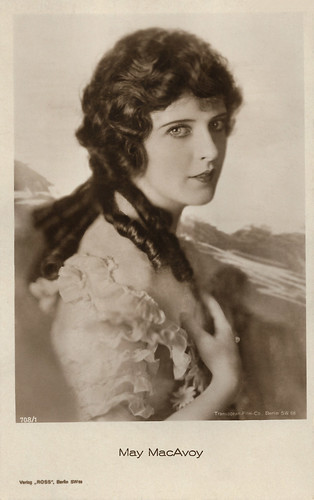
German postcard by Ross Verlag, Berlin, no. 708/1, 1925-1926. Photo: Transocean-Film-Co, Berlin.
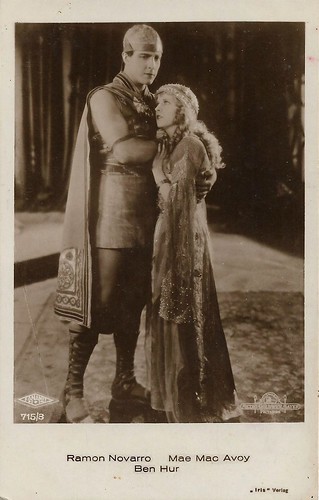
Austrian postcard by Iris Verlag, no. 715/3. Photo: Fanamet / Metro-Goldwyn-Mayer. Ramon Novarro and May McAvoy in Ben-Hur: A Tale of the Christ (Fred Niblo, 1925).
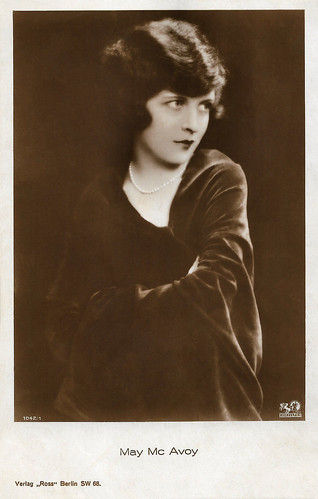
German postcard by Ross Verlag, Berlin, no. 1042/1, 1927-1928. Photo: Phoebus Film.
Petite and Independent
May McAvoy was born in New York City in 1899, within a well-to-do family that owned and operated a livery stable.
May left school at the age of 17 to act in her first role in the film Hate by Walter Richard Stahl. From then she had small parts, even uncredited roles in films, for various Californian film companies, until she did a few films for the J. Stuart Blackton Company.
J. Stuart Blackton, the co-founder of and regular director at Vitagraph, had started his own production company in 1917. After two smaller parts in films for the company, she got her first lead in The House of the Tolling Bell (J. Stuart Blackton, 1920), a mystery film about a haunted house. Blackton let her star again, again opposite Bruce Gordon, in The Forbidden Valley (J. Stuart Blackton, 1920).
In 1921 she acted e.g. in Chester M. Franklin's A Private Scandal, which script had been purposely written by Hector Turnbull for McAvoy. The film was the first of a series of seven films at Realart Pictures, in which McAvoy constantly starred, directed either by Frank O'Connor or William Desmond Taylor. The apparent success of these films convinced Paramount to lure her away with a contract. Petite as she was, McAvoy was independent enough to defend her interests.
In 1922 May McAvoy started to act at Paramount/ Famous Players-Lasky, where she already had done an occasional film in the past. It was William C. DeMille who mostly directed her at Paramount: in Clarence (1922), starring Wallace Reid and Agnes Ayres, Grumpy (1923), starring Theodore Roberts, Only 38 (1923), in which she herself had the lead, and The Bedroom Window (1924), another starring role with Malcolm McGregor and Ricardo Cortez as her co-stars. It was probably McAvoy's last film for Paramount.
In 1923 May McAvoy got into a row with director-producer Cecil B. DeMille, because she refused the role in his film Adam's Rib, as it meant her hair would be bobbed and she had to show partial nudity. Instead, she complained parts she wanted were given to other actresses: to Betty Bronson in Peter Pan and to Betty Compson in Little Minister. After she had been suspended, she bought off her contract and started freelancing.
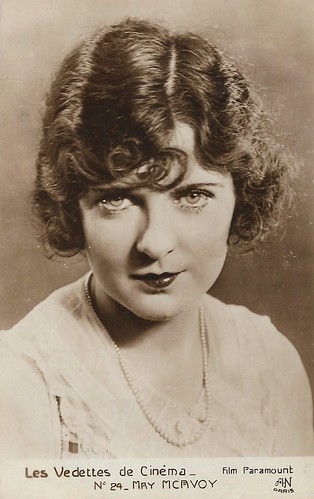
French postcard in the Les Vedettes de Cinéma series by A.M., Paris, no. 24. Photo: Film Paramount.
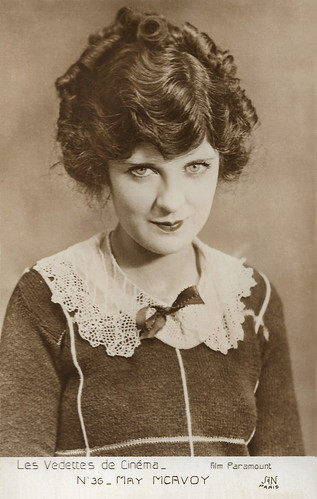
French postcard in Les Vedettes de Cinéma series by A.N., Paris, no. 36. Photo: Paramount.
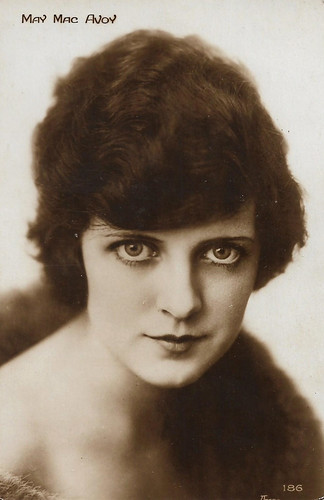
French postcard by Editions Cinémagazine, Paris, no. 186. Photo: Apeda.
MGM's classic super production
Freelancing didn't mean a fallback at all, as May McAvoy managed to play memorable parts in e.g. The Enchanted Cottage (John S. Robertson, 1924) starring and produced by Richard Barthelmess, Tessie (Dallas M. Fitzgerald, 1925) and in particular Lady Windermere's Fan (Ernst Lubitsch, 1925) with Ronald Colman .
McAvoy replaced Gertrude Olmstead in her best known silent film, MGM's classic super production Ben-Hur: A Tale of the Christ (Fred Niblo 1925). McAvoy played Esther, the love interest of the title character, played by Ramon Novarro . Her former rival at Paramount, Betty Bronson, would play the small part of the Virgin Mary.
Two years after, McAvoy had an important part in what is often credited as the first sound feature, The Jazz Singer (Alan Crossland 1927), which, actually, was a part-talkie, in which most actors, including McAvoy, did not talk yet. She played Mary, girlfriend of the male lead, played by singer-actor Al Jolson.
Afterward, May McAvoy did act in all-talkie movies, such as The Lion and the Mouse (Lloyd Bacon, 1928), and The Terror (Roy Del Ruth, 1928), shot at Warner's studio in Burbank with failing technology, distorting her voice. Not so much because of her voice, but on request of her new (1929) husband, Maurice Cleary, banker and treasurer of United Artists, she withdrew to private life and took care of their son, Patrick (1932-2012).
Despite some sources write they remained married until his death, Wikipedia has convincing proof they divorced in 1940. It also explains that in 1940 McAvoy went back to the set, but had to satisfy with bit parts. Hollywood was not kind to its former stars. Still, until 1959 she had small parts, even uncredited ones - her last part being an extra in the remake of Ben-Hur (1959) by William Wyler, himself a former assistant-director on the silent version.
May McAvoy died in 1984, in Los Angeles, as the consequence of a heart attack one year earlier. She was interred in the Holy Cross Cemetery in Culver City. May McAvoy has a star on the Hollywood Walk of Fame at 1731 Vine Street.
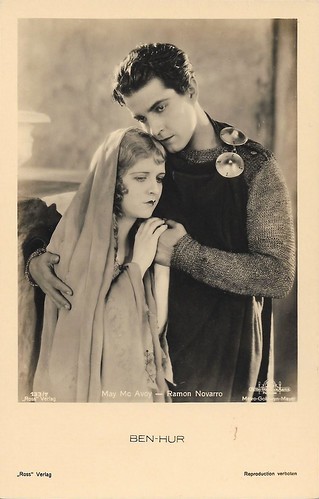
German postcard by Ross Verlag, no. 133/7 Photo: Metro-Goldwyn-Mayer. Ramon Novarro and May McAvoy in Ben-Hur: A Tale of the Christ (Fred Niblo, 1925).
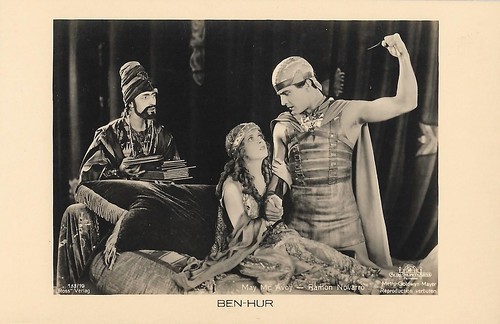
German postcard by Ross Verlag, no. 133/10 Photo: Metro-Goldwyn-Mayer. Ramon Novarro and May McAvoy in Ben-Hur: A Tale of the Christ (Fred Niblo, 1925).
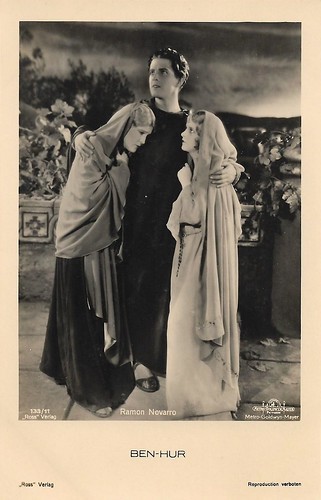
German postcard by Ross Verlag, no. 133/11. Photo: Metro-Goldwyn-Mayer. Ramon Novarro , Claire McDowell and May McAvoy in Ben-Hur: A Tale of the Christ (Fred Niblo, 1925).
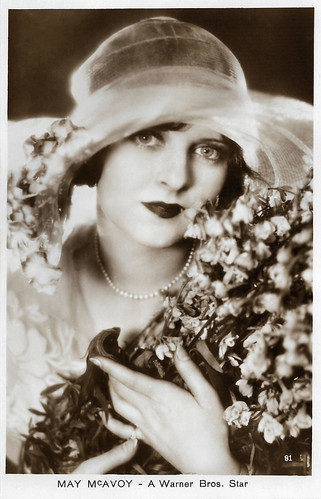
British Real Photograph postcard, no. 81. Photo: Warner Bros.
Sources: Dave Lobosco (A Trip Down Memory Lane), Wikipedia (English and German), and .

German postcard by Ross Verlag, Berlin, no. 708/1, 1925-1926. Photo: Transocean-Film-Co, Berlin.

Austrian postcard by Iris Verlag, no. 715/3. Photo: Fanamet / Metro-Goldwyn-Mayer. Ramon Novarro and May McAvoy in Ben-Hur: A Tale of the Christ (Fred Niblo, 1925).

German postcard by Ross Verlag, Berlin, no. 1042/1, 1927-1928. Photo: Phoebus Film.
Petite and Independent
May McAvoy was born in New York City in 1899, within a well-to-do family that owned and operated a livery stable.
May left school at the age of 17 to act in her first role in the film Hate by Walter Richard Stahl. From then she had small parts, even uncredited roles in films, for various Californian film companies, until she did a few films for the J. Stuart Blackton Company.
J. Stuart Blackton, the co-founder of and regular director at Vitagraph, had started his own production company in 1917. After two smaller parts in films for the company, she got her first lead in The House of the Tolling Bell (J. Stuart Blackton, 1920), a mystery film about a haunted house. Blackton let her star again, again opposite Bruce Gordon, in The Forbidden Valley (J. Stuart Blackton, 1920).
In 1921 she acted e.g. in Chester M. Franklin's A Private Scandal, which script had been purposely written by Hector Turnbull for McAvoy. The film was the first of a series of seven films at Realart Pictures, in which McAvoy constantly starred, directed either by Frank O'Connor or William Desmond Taylor. The apparent success of these films convinced Paramount to lure her away with a contract. Petite as she was, McAvoy was independent enough to defend her interests.
In 1922 May McAvoy started to act at Paramount/ Famous Players-Lasky, where she already had done an occasional film in the past. It was William C. DeMille who mostly directed her at Paramount: in Clarence (1922), starring Wallace Reid and Agnes Ayres, Grumpy (1923), starring Theodore Roberts, Only 38 (1923), in which she herself had the lead, and The Bedroom Window (1924), another starring role with Malcolm McGregor and Ricardo Cortez as her co-stars. It was probably McAvoy's last film for Paramount.
In 1923 May McAvoy got into a row with director-producer Cecil B. DeMille, because she refused the role in his film Adam's Rib, as it meant her hair would be bobbed and she had to show partial nudity. Instead, she complained parts she wanted were given to other actresses: to Betty Bronson in Peter Pan and to Betty Compson in Little Minister. After she had been suspended, she bought off her contract and started freelancing.

French postcard in the Les Vedettes de Cinéma series by A.M., Paris, no. 24. Photo: Film Paramount.

French postcard in Les Vedettes de Cinéma series by A.N., Paris, no. 36. Photo: Paramount.

French postcard by Editions Cinémagazine, Paris, no. 186. Photo: Apeda.
MGM's classic super production
Freelancing didn't mean a fallback at all, as May McAvoy managed to play memorable parts in e.g. The Enchanted Cottage (John S. Robertson, 1924) starring and produced by Richard Barthelmess, Tessie (Dallas M. Fitzgerald, 1925) and in particular Lady Windermere's Fan (Ernst Lubitsch, 1925) with Ronald Colman .
McAvoy replaced Gertrude Olmstead in her best known silent film, MGM's classic super production Ben-Hur: A Tale of the Christ (Fred Niblo 1925). McAvoy played Esther, the love interest of the title character, played by Ramon Novarro . Her former rival at Paramount, Betty Bronson, would play the small part of the Virgin Mary.
Two years after, McAvoy had an important part in what is often credited as the first sound feature, The Jazz Singer (Alan Crossland 1927), which, actually, was a part-talkie, in which most actors, including McAvoy, did not talk yet. She played Mary, girlfriend of the male lead, played by singer-actor Al Jolson.
Afterward, May McAvoy did act in all-talkie movies, such as The Lion and the Mouse (Lloyd Bacon, 1928), and The Terror (Roy Del Ruth, 1928), shot at Warner's studio in Burbank with failing technology, distorting her voice. Not so much because of her voice, but on request of her new (1929) husband, Maurice Cleary, banker and treasurer of United Artists, she withdrew to private life and took care of their son, Patrick (1932-2012).
Despite some sources write they remained married until his death, Wikipedia has convincing proof they divorced in 1940. It also explains that in 1940 McAvoy went back to the set, but had to satisfy with bit parts. Hollywood was not kind to its former stars. Still, until 1959 she had small parts, even uncredited ones - her last part being an extra in the remake of Ben-Hur (1959) by William Wyler, himself a former assistant-director on the silent version.
May McAvoy died in 1984, in Los Angeles, as the consequence of a heart attack one year earlier. She was interred in the Holy Cross Cemetery in Culver City. May McAvoy has a star on the Hollywood Walk of Fame at 1731 Vine Street.

German postcard by Ross Verlag, no. 133/7 Photo: Metro-Goldwyn-Mayer. Ramon Novarro and May McAvoy in Ben-Hur: A Tale of the Christ (Fred Niblo, 1925).

German postcard by Ross Verlag, no. 133/10 Photo: Metro-Goldwyn-Mayer. Ramon Novarro and May McAvoy in Ben-Hur: A Tale of the Christ (Fred Niblo, 1925).

German postcard by Ross Verlag, no. 133/11. Photo: Metro-Goldwyn-Mayer. Ramon Novarro , Claire McDowell and May McAvoy in Ben-Hur: A Tale of the Christ (Fred Niblo, 1925).

British Real Photograph postcard, no. 81. Photo: Warner Bros.
Sources: Dave Lobosco (A Trip Down Memory Lane), Wikipedia (English and German), and .
Published on May 16, 2019 22:00
May 15, 2019
Monpti (1957)
Romy Schneider and Horst Buchholz were one of the most beloved 'Traumpaare' (dream couples) of the German cinema of the 1950s. Their most successful film together was the romantic drama Monpti/Love from Paris (Helmut Käutner, 1957), situated in, oui!, Paris.
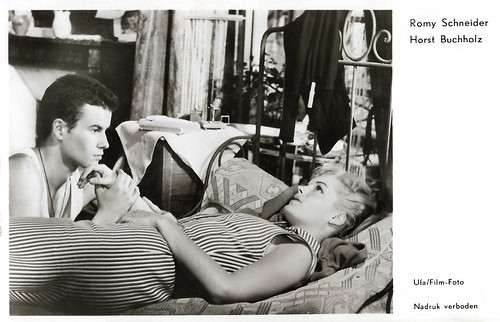
Dutch postcard by Gebr. Spanjersberg, Rotterdam, no. 1012. Photo: Ufa. Romy Schneider and Horst Buchholz in Monpti (Helmut Käutner, 1957).
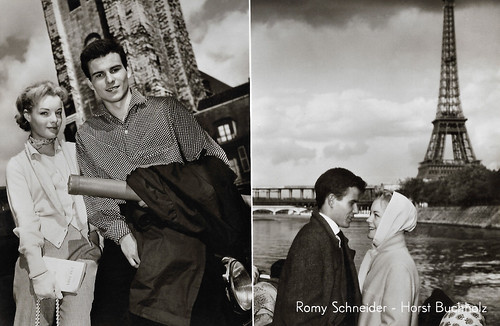
German postcard by Franz Josef Rüdel, Filmpostkartenverlag, Hamburg-Bergedorf, no. 2268. Photo: NDF / Herzog / Vogelmann; NDF / Herzog / Brünjes. Publicity stills for Monpti (Helmut Käutner, 1957) with Romy Schneider and Horst Buchholz .
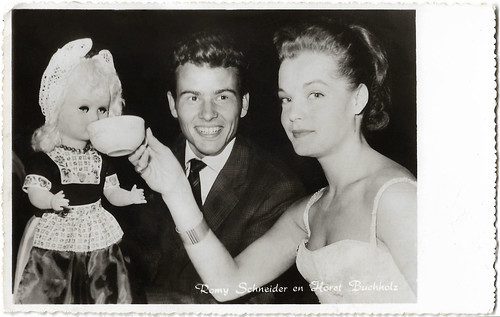
Dutch postcard by Int. Filmpers, Amsterdam, no. 1221. Photo: Cont Press / Heinz Fremke. Caption: Special picture made at the premiere of Monpti. A film based on the novel 'Monpti' issued in 15 languages in a total edition of 2.000.000 copies. Author: Gabor von Vasary.
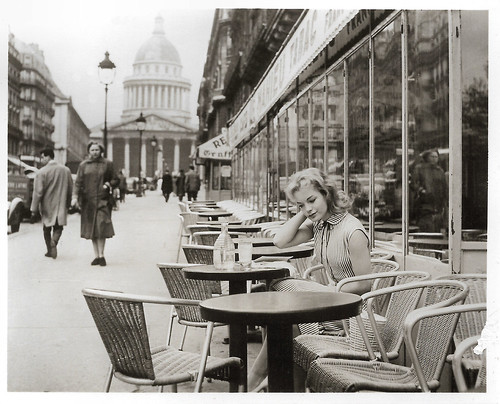
Dutch postcard by Gebr. Spanjersberg, Rotterdam, no. 1027. Photo: Ufa. Publicity still for Monpti (Helmut Käutner, 1957) with Romy Schneider. Sadly, a former owner of this postcard cut the sides off.
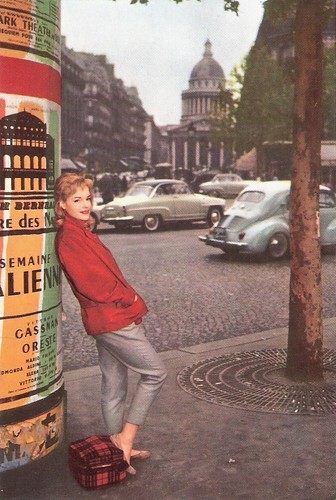
Dutch postcard by Gebr. Spanjersberg N.V., Rotterdam (Licency holder for Universum-Film Aktiengesellschaft, Berlin-Tempelhof), no. 1003. Photo: Ufa. Publicity still for Monpti (Helmut Käutner, 1957).
A cat and mouse play-like erotic relationship
Monpti/Love from Paris (Helmut Käutner, 1957) is a cheerful, yet melancholic love story set in Paris that ends tragically.
Horst Buchholz plays a young, starving art student from Budapest who meets Anne-Claire ( Romy Schneider ), a pretty, French girl on a bench in the Luxembourg park in Paris.
Anne-Claire is a 17-year old seamstress, who pretends to be of rich family in order to crash society. In reality, she is poor and orphaned. She falls in love with the Hungarian artist whom she calls Monpti (short for Mon petit – My little one).
She tells him that she comes from a wealthy family and has a private chauffeur, and even takes Monpti to a family church funeral and points out all her relatives, even telling which ones are not on speaking terms.
A cat and mouse play-like erotic relationship starts. Monpti has no time for women of wealth. Sensing a challenge, Anne-Claire pursues Monpti, keeping her true identity a secret. But when he learns the truth, he hits her in the open street, takes a cab, and drives away.
What starts as a light-hearted romp unexpectedly deepens into tragedy.Anne-Claire tries to follow him but runs into a car. In the background of many scenes we have seen the couple who overrun Anne-Claire, and their shallow emotions were recurrently contrasted with the genuine love of the young couple.
Monpti sees Anne-Claire one last time, lying in the hospital. Monpti promises he will marry her, but Anne-Claire dies a little while later from her injuries. In a dream, Monpti sees her in a wedding dress.
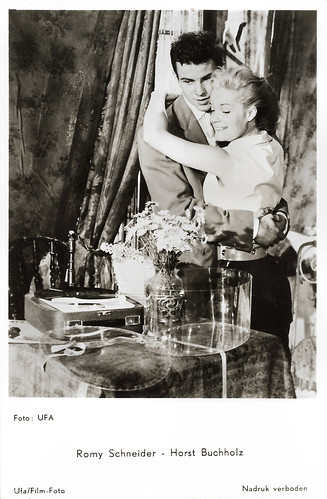
Dutch postcard by Gebr. Spanjersberg, Rotterdam, no. 1016. Photo: Ufa. Romy Schneider and Horst Buchholz in Monpti (Helmut Käutner, 1957).
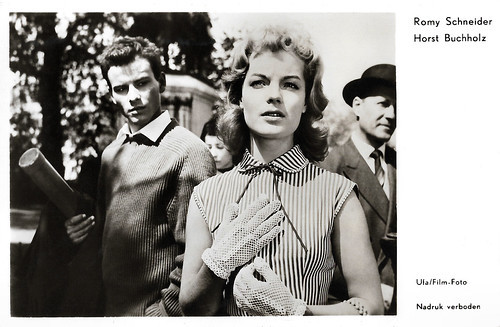
Dutch postcard by Gebr. Spanjersberg, Rotterdam, no. 1019. Photo: Ufa. Romy Schneider and Horst Buchholz in Monpti (Helmut Käutner, 1957).
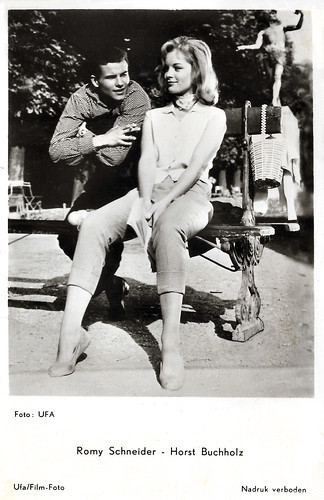
Dutch postcard by Gebr. Spanjersberg, Rotterdam. Photo: Ufa. Romy Schneider and Horst Buchholz in Monpti (Helmut Käutner, 1957).
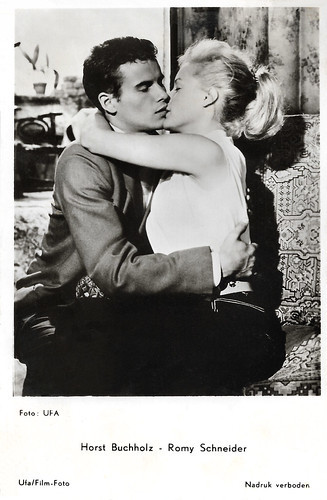
Dutch postcard by Gebr. Spanjersberg, Rotterdam. Photo: Ufa. Romy Schneider and Horst Buchholz in Monpti (Helmut Käutner, 1957).
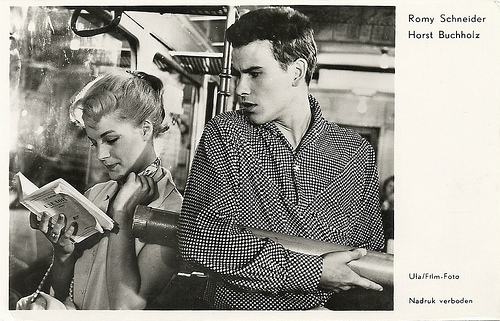
Dutch postcard by Gebr. Spanjersberg, Rotterdam, no. 1022. Photo: Ufa. Romy Schneider and Horst Buchholz in Monpti (Helmut Käutner, 1957).
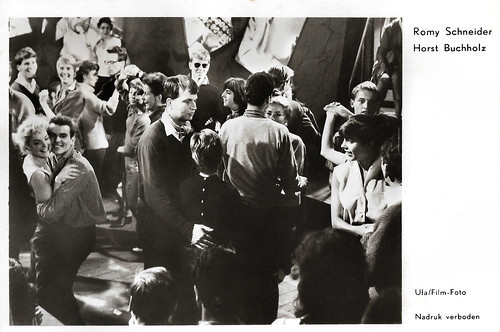
Dutch postcard by Gebr. Spanjersberg, Rotterdam, no. 1024. Photo: Ufa. Romy Schneider and Horst Buchholz in Monpti (Helmut Käutner, 1957).
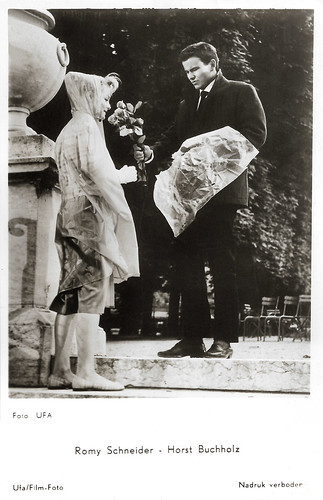
Dutch postcard by Gebr. Spanjersberg, Rotterdam, no. 1025. Photo: Ufa. Romy Schneider and Horst Buchholz in Monpti (Helmut Käutner, 1957).
The turning point for Romy Schneider
In 1957, Romy Schneider and Horst Buchholz were Germany's biggest film stars. They had teamed up the year before in Robinson Soll nicht sterben/The Girl and the Legend (Josef von Báky, 1957) which dealt with author Daniel Defoe's childhood. Horst Buchholz had also been the hero of the German version of Julien Duvivier's Marianne de Ma Jeunesse/Marianne of My Youth (1955).
The young and fascinating Romy grew in popularity in the wake of the Sissi saga. Monpti (English-language title Love From Paris) was the first time she had left the costume- and Heimatfilms. Monpti became the turning point which explained her further evolution. It was not yet Orson Welles or Luchino Visconti but it was a step in the right direction.
Montpi was directed by Helmut Käutner and produced by Harald Braun. It was filmed in the Bavaria Filmstudios and on location in Paris. The scenes often take place in the Luxembourg gardens in the Latin Quarter. The cinematographer was Heinz Pehlke, who used different techniques to convey the mood of the film, including using a concealed camera to capture the sights and sounds of Paris.
Helmut Käutner was influenced by the French director Julien Duvivier whose Sous le ciel de Paris/Under the Sky of Paris (1951) and other films revolved around the whims of fate, with a voice over. Monpti is narrated by a wry, all-knowing Bistro customer, who functions as a sort of keyhole peeper in a cabaret-like farce. The old Bistro customer is played by director Käutner himself.
Marcin Kukuczka at IMDb : "MONPTI is a nice underrated film about simplicity, youthful joy, pure affection that all young people may get through when they only want to. It's also a wonderful insight into a change introduced in cinema. Highly recommended!"
J.J. Gittes at IMDb : "The film is completely dazzling, and as some say this is Käutner's biggest coup de main, though I'm not so sure myself, I definitely cannot disagree. Monpti left me a bit dumbfounded, gasping for air, as it's as fast as seemingly innocent while going through the motions in a nether-land somewhere between Andrzej Zulawski's Possession (1981) and Ernst Marischka's Sissi (1955). Definitely one-of-its-kind, this is a testament to the 50s as a disjointed decade stuck between the 40s and 60s, on a planet of its own. "
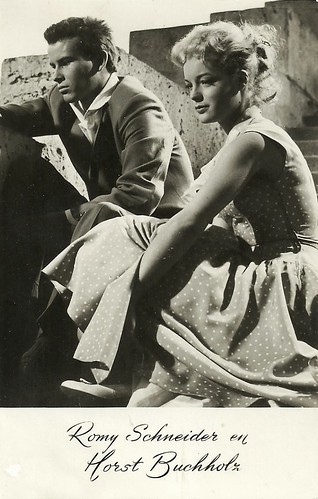
Dutch postcard by Uitg. Takken, Utrecht, no. AX 3168. Photo: Filmex N.V. Romy Schneider and Horst Buchholz in Monpti (Helmut Käutner, 1957).
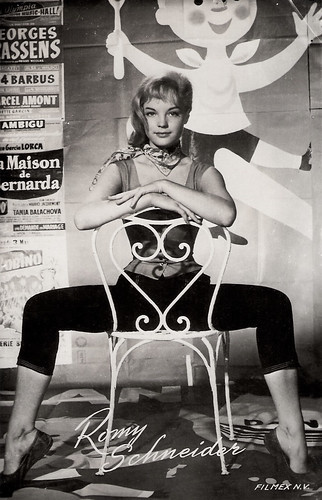
Dutch postcard by Uitg. Takken, Utrecht, no. AX 3175. Photo: Filmex N.V. Romy Schneider in Monpti (Helmut Käutner, 1957).
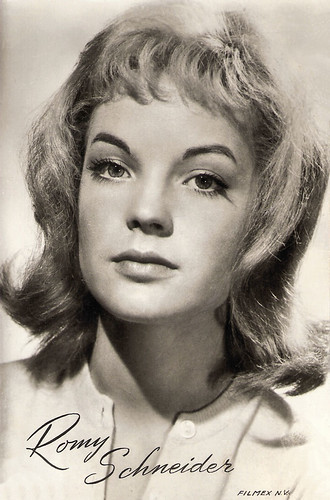
Dutch postcard by Uitg. Takken, Utrecht, no. AX 3177. Photo: Filmex N.V. Romy Schneider in Monpti (Helmut Käutner, 1957).
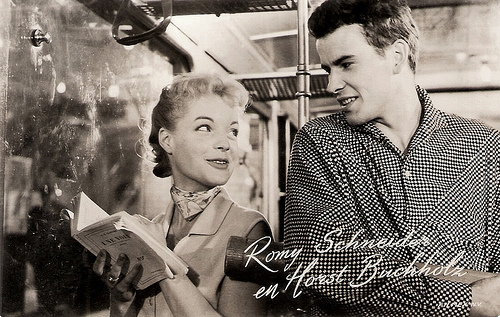
Dutch postcard by Uitg. Takken, Utrecht, no. AX 3179. Photo: Filmex N.V. Romy Schneider and Horst Buchholz in Monpti (Helmut Käutner, 1957).
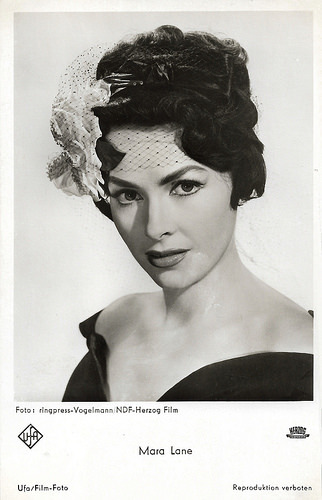
West-German postcard by Ufa/Film-Foto, Berlin-Tempelhof, no. FK 3674. Photo: Ringpress / Vogelmann / NDF / Herzog Film. Mara Lane in Monpti/Love from Paris (Helmut Käutner, 1957).
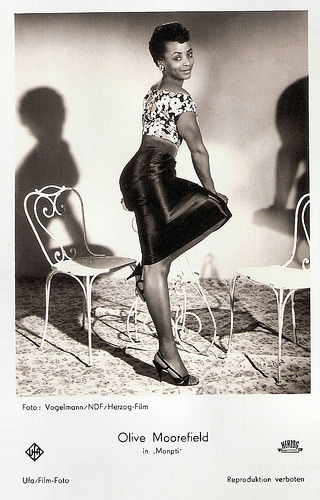
German postcard by Ufa. Photo: Vogelmann / NDF / Herzog-film. Olive Moorefield in Monpti (Helmut Käutner, 1957).
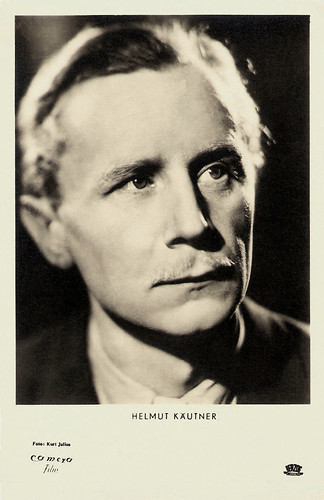
Director and actor Helmut Käutner . German postcard by Photo-Kitt, München, no. 504. Photo: Kurt Julius / Camera Film.
Sources: Wikipedia and IMDb.

Dutch postcard by Gebr. Spanjersberg, Rotterdam, no. 1012. Photo: Ufa. Romy Schneider and Horst Buchholz in Monpti (Helmut Käutner, 1957).

German postcard by Franz Josef Rüdel, Filmpostkartenverlag, Hamburg-Bergedorf, no. 2268. Photo: NDF / Herzog / Vogelmann; NDF / Herzog / Brünjes. Publicity stills for Monpti (Helmut Käutner, 1957) with Romy Schneider and Horst Buchholz .

Dutch postcard by Int. Filmpers, Amsterdam, no. 1221. Photo: Cont Press / Heinz Fremke. Caption: Special picture made at the premiere of Monpti. A film based on the novel 'Monpti' issued in 15 languages in a total edition of 2.000.000 copies. Author: Gabor von Vasary.

Dutch postcard by Gebr. Spanjersberg, Rotterdam, no. 1027. Photo: Ufa. Publicity still for Monpti (Helmut Käutner, 1957) with Romy Schneider. Sadly, a former owner of this postcard cut the sides off.

Dutch postcard by Gebr. Spanjersberg N.V., Rotterdam (Licency holder for Universum-Film Aktiengesellschaft, Berlin-Tempelhof), no. 1003. Photo: Ufa. Publicity still for Monpti (Helmut Käutner, 1957).
A cat and mouse play-like erotic relationship
Monpti/Love from Paris (Helmut Käutner, 1957) is a cheerful, yet melancholic love story set in Paris that ends tragically.
Horst Buchholz plays a young, starving art student from Budapest who meets Anne-Claire ( Romy Schneider ), a pretty, French girl on a bench in the Luxembourg park in Paris.
Anne-Claire is a 17-year old seamstress, who pretends to be of rich family in order to crash society. In reality, she is poor and orphaned. She falls in love with the Hungarian artist whom she calls Monpti (short for Mon petit – My little one).
She tells him that she comes from a wealthy family and has a private chauffeur, and even takes Monpti to a family church funeral and points out all her relatives, even telling which ones are not on speaking terms.
A cat and mouse play-like erotic relationship starts. Monpti has no time for women of wealth. Sensing a challenge, Anne-Claire pursues Monpti, keeping her true identity a secret. But when he learns the truth, he hits her in the open street, takes a cab, and drives away.
What starts as a light-hearted romp unexpectedly deepens into tragedy.Anne-Claire tries to follow him but runs into a car. In the background of many scenes we have seen the couple who overrun Anne-Claire, and their shallow emotions were recurrently contrasted with the genuine love of the young couple.
Monpti sees Anne-Claire one last time, lying in the hospital. Monpti promises he will marry her, but Anne-Claire dies a little while later from her injuries. In a dream, Monpti sees her in a wedding dress.

Dutch postcard by Gebr. Spanjersberg, Rotterdam, no. 1016. Photo: Ufa. Romy Schneider and Horst Buchholz in Monpti (Helmut Käutner, 1957).

Dutch postcard by Gebr. Spanjersberg, Rotterdam, no. 1019. Photo: Ufa. Romy Schneider and Horst Buchholz in Monpti (Helmut Käutner, 1957).

Dutch postcard by Gebr. Spanjersberg, Rotterdam. Photo: Ufa. Romy Schneider and Horst Buchholz in Monpti (Helmut Käutner, 1957).

Dutch postcard by Gebr. Spanjersberg, Rotterdam. Photo: Ufa. Romy Schneider and Horst Buchholz in Monpti (Helmut Käutner, 1957).

Dutch postcard by Gebr. Spanjersberg, Rotterdam, no. 1022. Photo: Ufa. Romy Schneider and Horst Buchholz in Monpti (Helmut Käutner, 1957).

Dutch postcard by Gebr. Spanjersberg, Rotterdam, no. 1024. Photo: Ufa. Romy Schneider and Horst Buchholz in Monpti (Helmut Käutner, 1957).

Dutch postcard by Gebr. Spanjersberg, Rotterdam, no. 1025. Photo: Ufa. Romy Schneider and Horst Buchholz in Monpti (Helmut Käutner, 1957).
The turning point for Romy Schneider
In 1957, Romy Schneider and Horst Buchholz were Germany's biggest film stars. They had teamed up the year before in Robinson Soll nicht sterben/The Girl and the Legend (Josef von Báky, 1957) which dealt with author Daniel Defoe's childhood. Horst Buchholz had also been the hero of the German version of Julien Duvivier's Marianne de Ma Jeunesse/Marianne of My Youth (1955).
The young and fascinating Romy grew in popularity in the wake of the Sissi saga. Monpti (English-language title Love From Paris) was the first time she had left the costume- and Heimatfilms. Monpti became the turning point which explained her further evolution. It was not yet Orson Welles or Luchino Visconti but it was a step in the right direction.
Montpi was directed by Helmut Käutner and produced by Harald Braun. It was filmed in the Bavaria Filmstudios and on location in Paris. The scenes often take place in the Luxembourg gardens in the Latin Quarter. The cinematographer was Heinz Pehlke, who used different techniques to convey the mood of the film, including using a concealed camera to capture the sights and sounds of Paris.
Helmut Käutner was influenced by the French director Julien Duvivier whose Sous le ciel de Paris/Under the Sky of Paris (1951) and other films revolved around the whims of fate, with a voice over. Monpti is narrated by a wry, all-knowing Bistro customer, who functions as a sort of keyhole peeper in a cabaret-like farce. The old Bistro customer is played by director Käutner himself.
Marcin Kukuczka at IMDb : "MONPTI is a nice underrated film about simplicity, youthful joy, pure affection that all young people may get through when they only want to. It's also a wonderful insight into a change introduced in cinema. Highly recommended!"
J.J. Gittes at IMDb : "The film is completely dazzling, and as some say this is Käutner's biggest coup de main, though I'm not so sure myself, I definitely cannot disagree. Monpti left me a bit dumbfounded, gasping for air, as it's as fast as seemingly innocent while going through the motions in a nether-land somewhere between Andrzej Zulawski's Possession (1981) and Ernst Marischka's Sissi (1955). Definitely one-of-its-kind, this is a testament to the 50s as a disjointed decade stuck between the 40s and 60s, on a planet of its own. "

Dutch postcard by Uitg. Takken, Utrecht, no. AX 3168. Photo: Filmex N.V. Romy Schneider and Horst Buchholz in Monpti (Helmut Käutner, 1957).

Dutch postcard by Uitg. Takken, Utrecht, no. AX 3175. Photo: Filmex N.V. Romy Schneider in Monpti (Helmut Käutner, 1957).

Dutch postcard by Uitg. Takken, Utrecht, no. AX 3177. Photo: Filmex N.V. Romy Schneider in Monpti (Helmut Käutner, 1957).

Dutch postcard by Uitg. Takken, Utrecht, no. AX 3179. Photo: Filmex N.V. Romy Schneider and Horst Buchholz in Monpti (Helmut Käutner, 1957).

West-German postcard by Ufa/Film-Foto, Berlin-Tempelhof, no. FK 3674. Photo: Ringpress / Vogelmann / NDF / Herzog Film. Mara Lane in Monpti/Love from Paris (Helmut Käutner, 1957).

German postcard by Ufa. Photo: Vogelmann / NDF / Herzog-film. Olive Moorefield in Monpti (Helmut Käutner, 1957).

Director and actor Helmut Käutner . German postcard by Photo-Kitt, München, no. 504. Photo: Kurt Julius / Camera Film.
Sources: Wikipedia and IMDb.
Published on May 15, 2019 22:00
May 14, 2019
Die Fürstin von Beranien (1918)
In the silent German drama Die Fürstin von Beranien/The Princess of Berania (Ernst Reicher, 1918), heartthrob Bruno Kastner plays a prince who falls for the princess of Berania, played by Stella Harf. But in this story the couple does not live happily ever after...
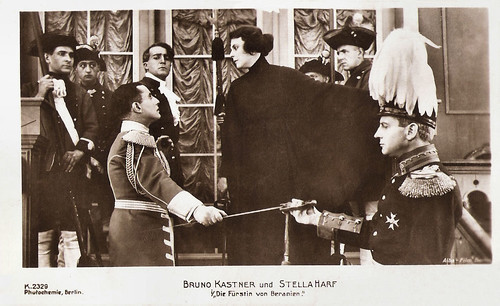
German postcard by Photochemie, Berlin, no. K. 2329. Photo: Alba-Film. Stella Harf and Bruno Kastner in Die Fürstin von Beranien/The Princess of Berania (Ernst Reicher, 1918).
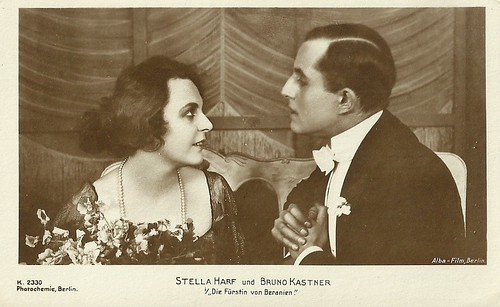
German postcard by Photochemie, Berlin, no. K. 2330. Photo: Alba-Film. Stella Harf and Bruno Kastner in Die Fürstin von Beranien (Ernst Reicher, 1918).
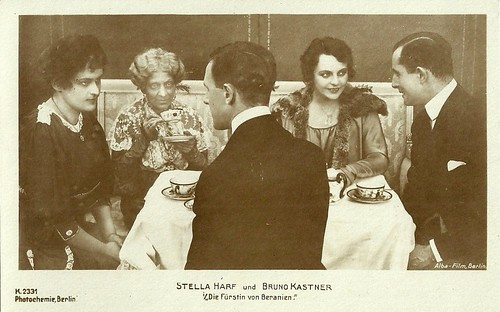
German postcard by Photochemie, Berlin, no. K. 2331. Photo: Alba-Film. Stella Harf and Bruno Kastner in Die Fürstin von Beranien (Ernst Reicher, 1918).
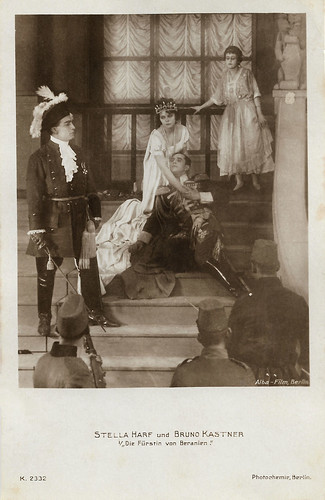
German postcard by Photochemie, Berlin, no. K. 2332. Photo: Alba-Film. Stella Harf and Bruno Kastner in Die Fürstin von Beranien (Ernst Reicher, 1918).
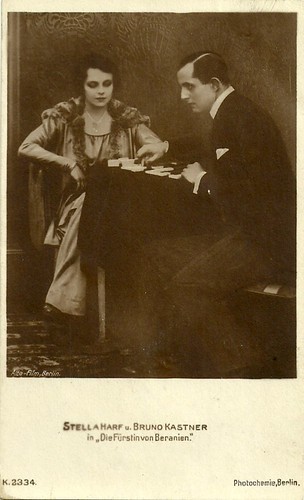
German postcard by Photochemie, Berlin, no. K. 2334. Photo: Alba-Film, Berlin. Stella Harf and Bruno Kastner in Die Fürstin von Beranien (Ernst Reicher, 1918).
A Last Sidestep
In Die Fürstin von Beranien/The Princess of Berania (Ernst Reicher, 1918), Bruno Kastner starred as prince Heinrich von Waldstein aka Dr. Heinrich von Wald. Director Ernst Reicher 's wife, Stella Harf, played the title role, princess Elisabeth Maria von Beranien.
Prince Ernst von Beranien (Leopold von Ledebur) announces his daughter Elisabeth will become crown princess. She asks for a last sidestep, and as a 'common countess', she is granted to take a holiday in the mountains, though escorted by the stern countess Elvira (Frida Richard) and her daughter Kitty.
The princess meets and falls in love with the sympathetic Dr. Heinrich von Wald, but when he proposes to her she flees, as the class difference would never permit such a marriage.
When her father dies, Elisabeth agrees to become the next ruler and must pick a husband of her class, her father's favourite Duke Rudolph (Kurt von Möllendorf). The military party opposes and rather sees her married to prince Von Waldstein. They assault the castle but when the prince and princess meet they recognise each other as the winter sports lovers.
Then the plot takes an unusal, tragic shift. Heinrich is captured but released. During a last farewell of Heinrich at Elisabeth's balcony, the guard misunderstands the situation and shoots him, mortally. After Heinrich's death Elisabeth marries her father's favourite.
Die Fürstin von Beranien premiered in April 1918 at the Berlin cinema Tauentzienpalast. The script was written by Richard Hutter. Sets were designed by future director Manfred Noa, and cinematography was done by Hans Bloch.
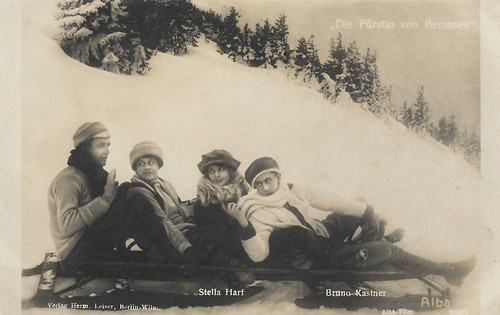
German postcard by Verlag Hermann Leiser, Berlin, no. 3267. Photo: Alba-Film. Stella Harf and Bruno Kastner in Die Fürstin von Beranien (Ernst Reicher, 1918).
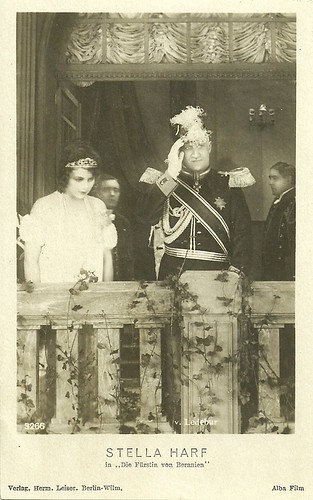
German postcard by Verlag Hermann Leiser, Berlin, no. 3266. Photo: Alba-Film. Stella Harf and Leopold von Ledebur in Die Fürstin von Beranien (Ernst Reicher, 1918).
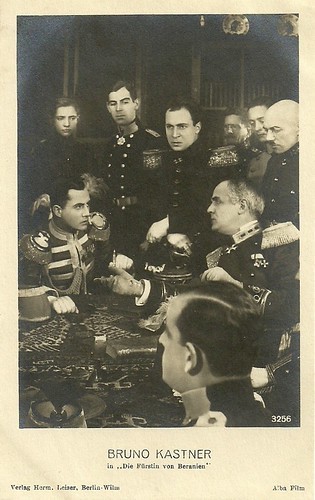
German postcard by Verlag Hermann Leiser, Berlin, no. 3256. Photo: Alba-Film. Bruno Kastner in Die Fürstin von Beranien (Ernst Reicher, 1918).
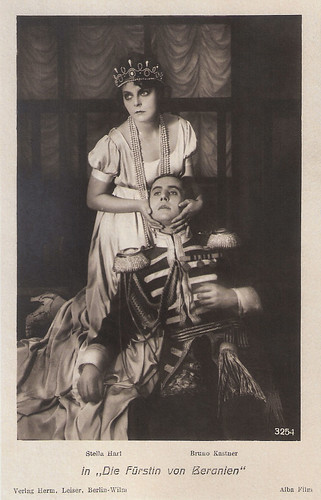
German postcard by Verlag Hermann Leiser, Berlin, no. 3254. Photo: Alba-Film. Stella Harf and Bruno Kastner in Die Fürstin von Beranien (Ernst Reicher, 1918).
Source: Wikipedia (German) and IMDb.

German postcard by Photochemie, Berlin, no. K. 2329. Photo: Alba-Film. Stella Harf and Bruno Kastner in Die Fürstin von Beranien/The Princess of Berania (Ernst Reicher, 1918).

German postcard by Photochemie, Berlin, no. K. 2330. Photo: Alba-Film. Stella Harf and Bruno Kastner in Die Fürstin von Beranien (Ernst Reicher, 1918).

German postcard by Photochemie, Berlin, no. K. 2331. Photo: Alba-Film. Stella Harf and Bruno Kastner in Die Fürstin von Beranien (Ernst Reicher, 1918).

German postcard by Photochemie, Berlin, no. K. 2332. Photo: Alba-Film. Stella Harf and Bruno Kastner in Die Fürstin von Beranien (Ernst Reicher, 1918).

German postcard by Photochemie, Berlin, no. K. 2334. Photo: Alba-Film, Berlin. Stella Harf and Bruno Kastner in Die Fürstin von Beranien (Ernst Reicher, 1918).
A Last Sidestep
In Die Fürstin von Beranien/The Princess of Berania (Ernst Reicher, 1918), Bruno Kastner starred as prince Heinrich von Waldstein aka Dr. Heinrich von Wald. Director Ernst Reicher 's wife, Stella Harf, played the title role, princess Elisabeth Maria von Beranien.
Prince Ernst von Beranien (Leopold von Ledebur) announces his daughter Elisabeth will become crown princess. She asks for a last sidestep, and as a 'common countess', she is granted to take a holiday in the mountains, though escorted by the stern countess Elvira (Frida Richard) and her daughter Kitty.
The princess meets and falls in love with the sympathetic Dr. Heinrich von Wald, but when he proposes to her she flees, as the class difference would never permit such a marriage.
When her father dies, Elisabeth agrees to become the next ruler and must pick a husband of her class, her father's favourite Duke Rudolph (Kurt von Möllendorf). The military party opposes and rather sees her married to prince Von Waldstein. They assault the castle but when the prince and princess meet they recognise each other as the winter sports lovers.
Then the plot takes an unusal, tragic shift. Heinrich is captured but released. During a last farewell of Heinrich at Elisabeth's balcony, the guard misunderstands the situation and shoots him, mortally. After Heinrich's death Elisabeth marries her father's favourite.
Die Fürstin von Beranien premiered in April 1918 at the Berlin cinema Tauentzienpalast. The script was written by Richard Hutter. Sets were designed by future director Manfred Noa, and cinematography was done by Hans Bloch.

German postcard by Verlag Hermann Leiser, Berlin, no. 3267. Photo: Alba-Film. Stella Harf and Bruno Kastner in Die Fürstin von Beranien (Ernst Reicher, 1918).

German postcard by Verlag Hermann Leiser, Berlin, no. 3266. Photo: Alba-Film. Stella Harf and Leopold von Ledebur in Die Fürstin von Beranien (Ernst Reicher, 1918).

German postcard by Verlag Hermann Leiser, Berlin, no. 3256. Photo: Alba-Film. Bruno Kastner in Die Fürstin von Beranien (Ernst Reicher, 1918).

German postcard by Verlag Hermann Leiser, Berlin, no. 3254. Photo: Alba-Film. Stella Harf and Bruno Kastner in Die Fürstin von Beranien (Ernst Reicher, 1918).
Source: Wikipedia (German) and IMDb.
Published on May 14, 2019 22:00
May 13, 2019
Doris Day (1922-2019)
Yesterday, Doris Day (1922-2019) has died at her California home at the age of 97. The legendary actress and singer with her blonde hair and blue eyes performed with several big bands before going solo in 1947. In the 1950s, she made a series of popular film musicals, including Calamity Jane (1953) and The Pajama Game (1957). 'Que Será, Será!' became her theme song. With Rock Hudson, she starred in the box office hit Pillow Talk (1959). On TV, she appeared in the sitcom The Doris Day Show (1968-1973). Day died early on Monday surrounded by her close friends at her home in Carmel Valley.

Dutch postcard by Takken / 't Sticht, no. AX 343. Photo: Warner Bros. Doris Day and Szöke Szakall in Tea for Two (David Butler, 1950), the first film for which Doris Day received top-billing.

Dutch card. Photo: Warner Bros. Doris Day and Kirk Douglas in Young Man with a Horn (Michael Curtiz, 1950).
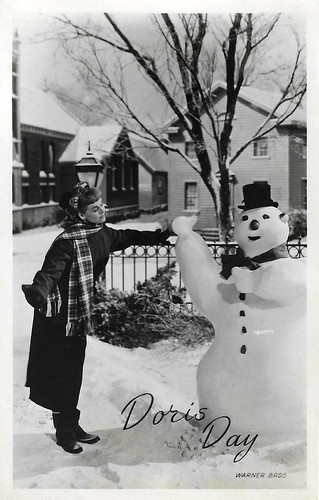
Dutch postcard by Takken, Utrecht, no. 748. Photo: Warner Bros. Doris Day in On Moonlight Bay (Roy Del Ruth, 1951).

Dutch postcard by Takken, Utrecht, no. 810. Photo: Warner Bros. Doris Day with Danny Thomas in I'll See You in My Dreams (Michael Curtiz, 1951).
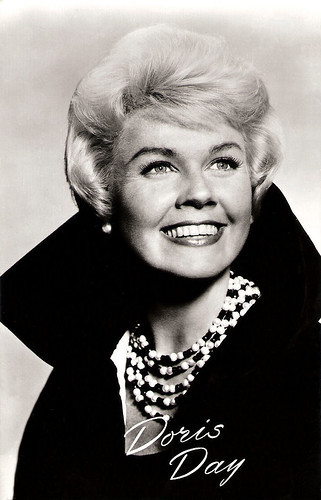
Dutch postcard by Uitg. Takken, Utrecht, no. AX 4240. Photo: Universal International. Publicity still for Pillow Talk (Michael Gordon, 1959). Collection: Geoffrey Donaldson Institute.
Audiences took to her bubbly personality
Doris Mary Ann Kappelhoff was born in 1922, in Cincinnati, Ohio, to Alma Sophia (Welz), a housewife, and William Joseph Kappelhoff, a music teacher and choir master. Her mother named her after her favourite silent film star, Doris Kenyon. She had two brothers, Richard, who died before she was born and Paul, a few years older.
For many years it was uncertain whether she was born in 1922 or 1924, with Day herself reportedly believing her birth year was the latter and giving her age accordingly. It wasn't until 3 April 2017, her 95th, not 93rd, birthday, that her birth certificate was found by the Associated Press, which confirmed she was born in 1922.
Her parents divorced while she was still a child and she lived with her mother. Like most little girls, Doris liked to dance. At fourteen, she formed a dance act with a boy, Jerry Doherty, and they won $500 in a local talent contest. She and Jerry took a brief trip to Hollywood to test the waters. They felt they could succeed, so she and Jerry returned to Cincinnati with the intention of packing and making a permanent move to Hollywood.
Tragically, the night before Doris was to move to Hollywood, her car was hit by a train and she badly injured her right leg. The accident ended the possibility of a dancing career. She spent her next years wheelchair-bound, but during this time began singing along with the radio. Observing her daughter sing Alma decided Doris should have singing lessons. She engaged a teacher, Grace Raine. After three lessons, Raine told Alma that young Doris had "tremendous potential". Raine was so impressed that she gave Doris three lessons a week for the price of one. Years later, Day said that Raine had the biggest effect on her singing style and career.
At age 17, Day had her first professional jobs as a vocalist, on the WLW radio program 'Carlin's Carnival', and in a local restaurant, Charlie Yee's Shanghai Inn. While performing for the radio, she was approached by band leader Barney Rapp. He felt that her name, Kappelhoff, was too harsh and awkward and that she should change her name to something more pleasant. The name 'Day' was suggested by Rapp from one of the songs in Doris' repertoire, 'Day by Day'. She didn't like the name at first, feeling that it sounded too much like a burlesque performer.
While she was performing in Barney Rapp's band, she met trombonist Al Jorden, and they married in 1941. The marriage was extremely unhappy and there were reports of Jordan's alcoholism and abuse of the young star. They divorced within two years, not long after the birth of their son Terrence Jorden called Terry. Despondent and feeling his life had little meaning after the much publicised divorce, Jorden later committed suicide.
After working with Rapp, Day worked with bandleaders Jimmy James, Bob Crosby, and Les Brown. The years touring with Les Brown & His Band of Renown, she later called 'the happiest times in my life'. In 1941, Day appeared as a singer in three Soundies (three-minute film clips containing a song, dance and/or band or orchestral number) with the Les Brown band. Her first hit recording was 'Sentimental Journey' in 1945. It became an anthem of the desire of World War II demobilising troops to return home. In 1946, Doris married saxophone player and former child actor George Weidler, but this union lasted less than a year. After leaving Brown to embark on a solo career, she recorded more than 650 songs from 1947 to 1967.
Day's agent talked her into taking a screen test at Warner Bros. The executives there liked what they saw and signed her to a contract. Her first starring role was in Romance on the High Seas (Michael Curtiz, Busby Berkeley, 1948), with Jack Carson and Janis Paige. The next year, she made two more films, My Dream Is Yours (Michael Curtiz, 1949) and It's a Great Feeling (David Butler, 1949). Audiences took to her beauty, terrific singing voice and bubbly personality, and she turned in fine performances in the films she made - in addition to several hit records.
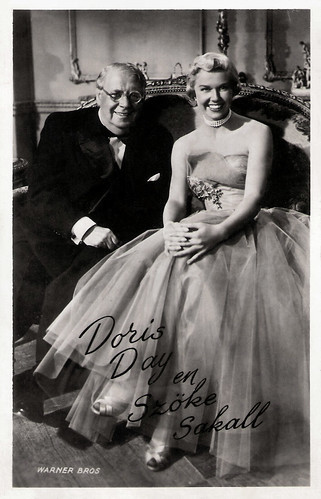
Dutch postcard by Takken / 't Sticht, no. AX 631. Photo: Warner Bros. Szöke Szakall and Doris Day in Lullaby of Broadway (David Butler, 1951).
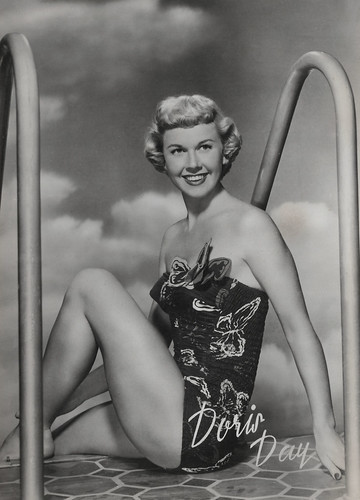
Big Belgian Collectors Card, no. F 44. Photo: Warner Bros.
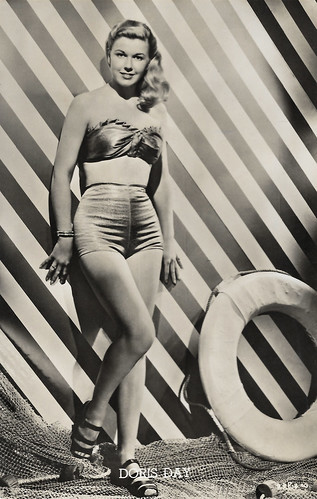
Belgian postcard, no. 1051. Photo: Warner Bros.
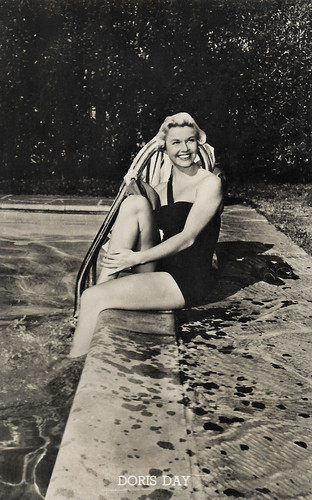
Belgian postcard, no. 1151. Photo: Warner Bros.
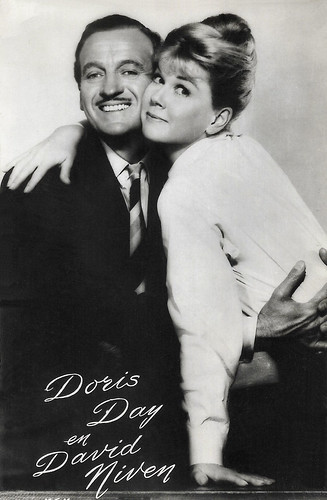
Dutch postcard by Takken, Utrecht, no. 4457. Photo: MGM. David Niven and Doris Day in Please Don't Eat the Daisies (Charles Walters, 1960).
Dating Ronald Reagan
Doris Day made three films for Warner Bros. in 1950 and five more in 1951. She co-starred with Gordon MacRae in five nostalgic period musicals: Tea for Two (David Butler, 1950), The West Point Story (Roy Del Ruth, 1950) with James Cagney and Virginia Mayo , On Moonlight Bay (Roy Del Ruth, 1951), Starlift (Roy Del Ruth, 1951), and By the Light of the Silvery Moon (David Butler, 1953).
Her most commercially successful film for Warner was I'll See You in My Dreams (1951), which broke box-office records of 20 years. The film is a musical biography of lyricist Gus Kahn, played by Danny Thomas. It was Day's fourth film directed by Michael Curtiz.
One of her few dramatic roles was in Storm Warning (Stuart Heisler, 1951) with Ginger Rogers and Ronald Reagan. She briefly dated Ronald Reagan - with whom she also co-starred in The Winning Team (1952) - shortly after his divorce from Jane Wyman when she and Reagan were contract players at Warner Bros.
Doris Day met and married Martin Melcher in 1951. He adopted her young son Terry and became her manager.
In 1953, Doris starred in Calamity Jane (David Butler, 1953), which was a major hit. She performed 'Secret Love' in the film, which won the Academy Award for Best Original Song. Several more hits followed including Lucky Me (Jack Donohue, 1954), Love Me or Leave Me (Charles Vidor, 1955) with James Cagney.
Alfred Hitchcock had seen her dramatic role in Storm Warning and choose her to play Jo McKenna opposite James Stewart in his re-make The Man Who Knew Too Much (1956). In the film she sang the song 'Que Será, Será! (Whatever Will Be, Will Be)', which won the Academy Award for Best Original Song and became an evergreen.
In 1959, Day entered her most successful phase as a film actress with a series of romantic comedies. Her best-known film is probably the first one, Pillow Talk (Michael Gordon, 1959) with Rock Hudson and Tony Randall. For her performance she received an Academy Award nomination for Best Leading Actress. She later co-starred with Hudson and Randall again in Lover Come Back (Delbert Mann, 1961), and Send Me No Flowers (Norman Jewison, 1964). In all three, Day and Hudson played love interests while Randall played Hudson's close friend.
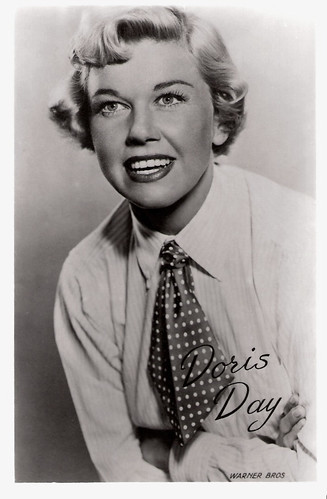
Dutch postcard. Photo: Warner Bros.

Dutch postcard by DRC, no. 147. Photo: Warner Bros. Caption: Doris Day and her mother Alma.
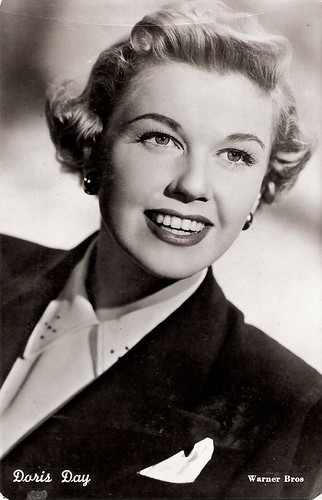
Dutch postcard. Photo: Warner Bros.
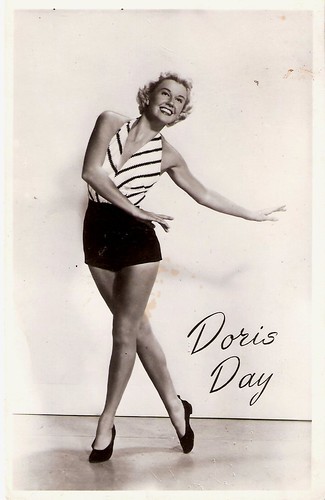
Dutch postcard by Takken, Utrecht, no. 814. Photo: Warner Bros.

Dutch postcard. Photo: Warner Bros.
Number one at the box office
Doris Day started out the 1960s with the hit Please Don't Eat the Daisies (Charles Walters, 1960) in which her co-star was David Niven . In 1962, Day appeared with Cary Grant in the comedy That Touch of Mink (Delbert Mann, 1962), the first film in history ever to gross $1 million in one theatre (Radio City Music Hall). During 1960 and the 1962 to 1964 period, she ranked number one at the box office.
Despite her successes at the box office, the late 1950s and early 1960s were a difficult period for Day. In 1958, her brother Paul had died. Around this time, her husband, who had also taken charge of her career, made deals for her to star in films she didn't really care about, which led to a bout with exhaustion.
The 1960s weren't to be a repeat of the previous busy decade. She made less films, but the ones she did make were successful: Do Not Disturb (Ralph Levy, 1965) with Rod Taylor, and The Glass Bottom Boat (Frank Tashlin, 1966).
By the late 1960s, the sexual revolution of the baby boomer generation had refocused public attitudes about sex. Times had changed, but Day's films had not. Where Were You When the Lights Went Out? (Hy Averback, 1968) and With Six You Get Eggroll (Howard Morris, 1968) with Brian Keith, would be her final features.
In 1968, her husband Martin Melcher suddenly died. Between 1956 and his death, he had produced 18 of her films. A shocked Day discovered she was millions of dollars in debt. Melcher and his business partner Jerome Bernard Rosenthal had squandered virtually all of her considerable earnings, but she was eventually awarded $22 million by the courts in a case against Rosenthal.

Dutch postcard by Takken, Utrecht, no. 287. Photo: Warner Bros.
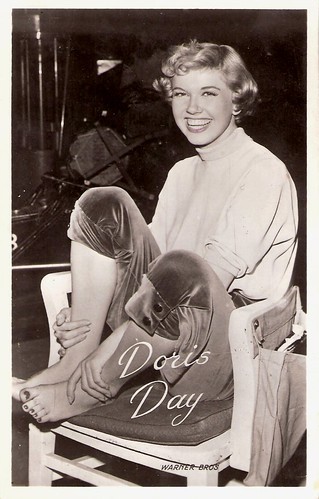
Dutch postcard by Takken, no. 335. Photo: Warner Bros.
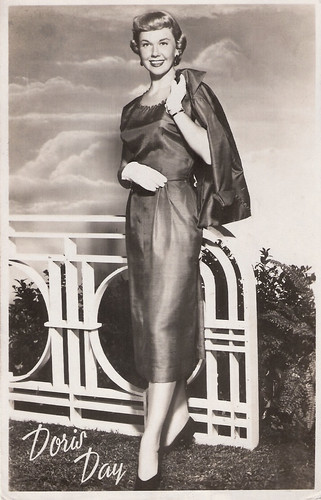
Dutch postcard by DRC, no. F 52. Photo: Warner Bros.

Vintage collectors card, no. F 129. Photo: Warner Bros.
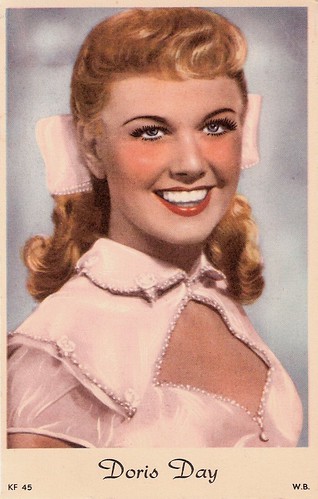
Belgian postcard, no. KF 45. Photo: Warner Bros.
A light and fluffy sitcom
After Martin Melcher's death, Doris Day never made another film. She professed not to have known that he had negotiated a multimillion-dollar deal with CBS to launch her own TV series, The Doris Day Show, the following fall. Day hated the idea of performing on television, but felt obligated to do it and needed the work to help pay off her debts. The show became successful and lasted from 1968 until 1973.
The Doris Day Show was a light and fluffy sitcom, which changed formats and producers almost every season. Originally it was about widow Doris Martin and her two young sons (Philip Brown and Todd Stark) who left the big city for the quiet and peace of her family's ranch, which was run by her dad Buck (Denver Pyle) and ranchhand Leroy (James Hampton). Later Doris, Buck and sons Billy and Toby moved to San Francisco, where Doris got a job as a secretary to bumbling magazine publisher Michael Nicholson (McLean Stevenson). In Season Three, the Martin family moved into an apartment above the Paluccis' Italian restaurant, and Doris began writing features for Today's World magazine. Finally, the kids, family, Nicholson, the Paluccis' and all other cast members vanished, and Doris became a single staff writer for Today's World, where her new boss was Cy Bennett (John Dehner).
After her series went off the air, Doris Day only made occasional TV appearances. She did two television specials, The Doris Mary Anne Kappelhoff Special (1971) and Doris Day Today (1975). She also appeared on the John Denver TV show (1974). In 1976, she married for the fourth time, to Barry Comden, 12 years her junior. They had met at the Beverly Hills Old World Restaurant where he was the maitre d'. The couple divorced in 1982. Comden complained that Day preferred the company of her dogs more than him.
From then on Doris devoted her life to animals. During the location filming of The Man Who Knew Too Much (Alfred Hitchcock, 1956) she had seen how camels, goats and other 'animal extras' in a marketplace scene were being treated. It began her lifelong commitment to prevent animal abuse. For years, she ran the Doris Day Animal League in Carmel, a resort town a little south of San Francisco.
In the 1985–1986 season, Day returned to the screen with her own television talk show, Doris Day's Best Friends, on CBN. The network cancelled the show after 26 episodes, despite the worldwide publicity it received. Much of that came from her interview with Rock Hudson, in which a visibly ill Hudson was showing the first public symptoms of AIDS. Hudson would die from the syndrome a year later.
Her son Terry Melcher had become a music producer and composer who worked with The Beach Boys, Bobby Darin and The Byrds. With Terry and a partner, she co-owned the Cypress Inn in Carmel, a small inn built in a Mediterranean motif. Terry died of melanoma in 2004, aged 62.
In June 2004 she was awarded the Presidential Medal of Freedom by George W. Bush. She did not attend the White House award ceremony because of her intense fear of flying. In 2006, she received a Grammy Lifetime Achievement Award.
In a rare interview with The Hollywood Reporter on 4 April 2019, a day after her 97th birthday, Day talked about her work on the Doris Day Animal Foundation, founded in 1978. On the question of what her favourite film was, she answered Calamity Jane: "I was such a tomboy growing up, and she was such a fun character to play. Of course, the music was wonderful, too—'Secret Love,' especially, is such a beautiful song."
As per her last wishes, there will be no funeral or graveside service. Doris Day will be cremated and her ashes scattered in Carmel.
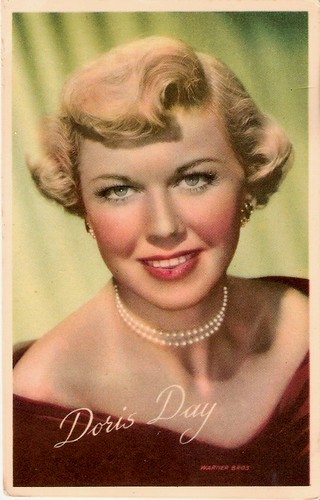
Dutch postcard. Photo: Warner Bros.
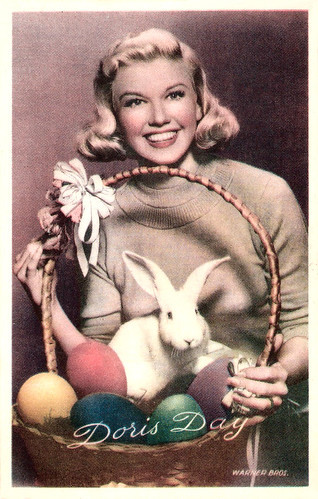
Belgian postcard. Photo: Warner Bros.
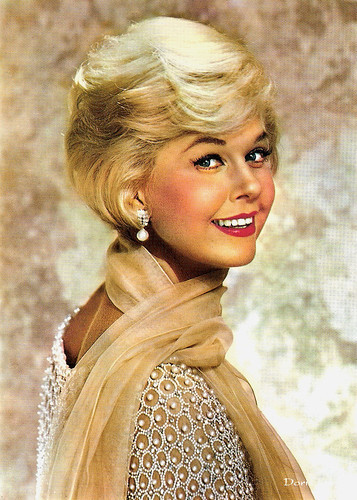
Big Italian postcard in the Artisti di Sempre series by Rotalfoto, Milano, no. 341.
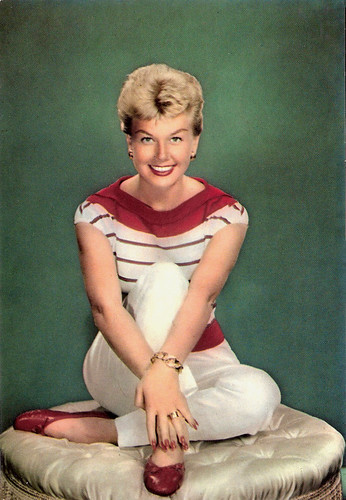
Italian postcard by Rotalfoto, Milano, no. N 27.
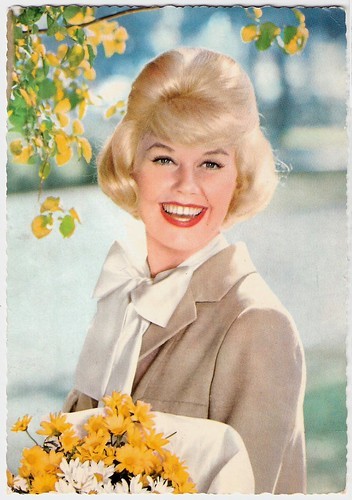
German postcard by Krüger, no. 902/143. Photo: Terb Agency / UFA.
Sources: Wikipedia and .

Dutch postcard by Takken / 't Sticht, no. AX 343. Photo: Warner Bros. Doris Day and Szöke Szakall in Tea for Two (David Butler, 1950), the first film for which Doris Day received top-billing.

Dutch card. Photo: Warner Bros. Doris Day and Kirk Douglas in Young Man with a Horn (Michael Curtiz, 1950).

Dutch postcard by Takken, Utrecht, no. 748. Photo: Warner Bros. Doris Day in On Moonlight Bay (Roy Del Ruth, 1951).

Dutch postcard by Takken, Utrecht, no. 810. Photo: Warner Bros. Doris Day with Danny Thomas in I'll See You in My Dreams (Michael Curtiz, 1951).

Dutch postcard by Uitg. Takken, Utrecht, no. AX 4240. Photo: Universal International. Publicity still for Pillow Talk (Michael Gordon, 1959). Collection: Geoffrey Donaldson Institute.
Audiences took to her bubbly personality
Doris Mary Ann Kappelhoff was born in 1922, in Cincinnati, Ohio, to Alma Sophia (Welz), a housewife, and William Joseph Kappelhoff, a music teacher and choir master. Her mother named her after her favourite silent film star, Doris Kenyon. She had two brothers, Richard, who died before she was born and Paul, a few years older.
For many years it was uncertain whether she was born in 1922 or 1924, with Day herself reportedly believing her birth year was the latter and giving her age accordingly. It wasn't until 3 April 2017, her 95th, not 93rd, birthday, that her birth certificate was found by the Associated Press, which confirmed she was born in 1922.
Her parents divorced while she was still a child and she lived with her mother. Like most little girls, Doris liked to dance. At fourteen, she formed a dance act with a boy, Jerry Doherty, and they won $500 in a local talent contest. She and Jerry took a brief trip to Hollywood to test the waters. They felt they could succeed, so she and Jerry returned to Cincinnati with the intention of packing and making a permanent move to Hollywood.
Tragically, the night before Doris was to move to Hollywood, her car was hit by a train and she badly injured her right leg. The accident ended the possibility of a dancing career. She spent her next years wheelchair-bound, but during this time began singing along with the radio. Observing her daughter sing Alma decided Doris should have singing lessons. She engaged a teacher, Grace Raine. After three lessons, Raine told Alma that young Doris had "tremendous potential". Raine was so impressed that she gave Doris three lessons a week for the price of one. Years later, Day said that Raine had the biggest effect on her singing style and career.
At age 17, Day had her first professional jobs as a vocalist, on the WLW radio program 'Carlin's Carnival', and in a local restaurant, Charlie Yee's Shanghai Inn. While performing for the radio, she was approached by band leader Barney Rapp. He felt that her name, Kappelhoff, was too harsh and awkward and that she should change her name to something more pleasant. The name 'Day' was suggested by Rapp from one of the songs in Doris' repertoire, 'Day by Day'. She didn't like the name at first, feeling that it sounded too much like a burlesque performer.
While she was performing in Barney Rapp's band, she met trombonist Al Jorden, and they married in 1941. The marriage was extremely unhappy and there were reports of Jordan's alcoholism and abuse of the young star. They divorced within two years, not long after the birth of their son Terrence Jorden called Terry. Despondent and feeling his life had little meaning after the much publicised divorce, Jorden later committed suicide.
After working with Rapp, Day worked with bandleaders Jimmy James, Bob Crosby, and Les Brown. The years touring with Les Brown & His Band of Renown, she later called 'the happiest times in my life'. In 1941, Day appeared as a singer in three Soundies (three-minute film clips containing a song, dance and/or band or orchestral number) with the Les Brown band. Her first hit recording was 'Sentimental Journey' in 1945. It became an anthem of the desire of World War II demobilising troops to return home. In 1946, Doris married saxophone player and former child actor George Weidler, but this union lasted less than a year. After leaving Brown to embark on a solo career, she recorded more than 650 songs from 1947 to 1967.
Day's agent talked her into taking a screen test at Warner Bros. The executives there liked what they saw and signed her to a contract. Her first starring role was in Romance on the High Seas (Michael Curtiz, Busby Berkeley, 1948), with Jack Carson and Janis Paige. The next year, she made two more films, My Dream Is Yours (Michael Curtiz, 1949) and It's a Great Feeling (David Butler, 1949). Audiences took to her beauty, terrific singing voice and bubbly personality, and she turned in fine performances in the films she made - in addition to several hit records.

Dutch postcard by Takken / 't Sticht, no. AX 631. Photo: Warner Bros. Szöke Szakall and Doris Day in Lullaby of Broadway (David Butler, 1951).

Big Belgian Collectors Card, no. F 44. Photo: Warner Bros.

Belgian postcard, no. 1051. Photo: Warner Bros.

Belgian postcard, no. 1151. Photo: Warner Bros.

Dutch postcard by Takken, Utrecht, no. 4457. Photo: MGM. David Niven and Doris Day in Please Don't Eat the Daisies (Charles Walters, 1960).
Dating Ronald Reagan
Doris Day made three films for Warner Bros. in 1950 and five more in 1951. She co-starred with Gordon MacRae in five nostalgic period musicals: Tea for Two (David Butler, 1950), The West Point Story (Roy Del Ruth, 1950) with James Cagney and Virginia Mayo , On Moonlight Bay (Roy Del Ruth, 1951), Starlift (Roy Del Ruth, 1951), and By the Light of the Silvery Moon (David Butler, 1953).
Her most commercially successful film for Warner was I'll See You in My Dreams (1951), which broke box-office records of 20 years. The film is a musical biography of lyricist Gus Kahn, played by Danny Thomas. It was Day's fourth film directed by Michael Curtiz.
One of her few dramatic roles was in Storm Warning (Stuart Heisler, 1951) with Ginger Rogers and Ronald Reagan. She briefly dated Ronald Reagan - with whom she also co-starred in The Winning Team (1952) - shortly after his divorce from Jane Wyman when she and Reagan were contract players at Warner Bros.
Doris Day met and married Martin Melcher in 1951. He adopted her young son Terry and became her manager.
In 1953, Doris starred in Calamity Jane (David Butler, 1953), which was a major hit. She performed 'Secret Love' in the film, which won the Academy Award for Best Original Song. Several more hits followed including Lucky Me (Jack Donohue, 1954), Love Me or Leave Me (Charles Vidor, 1955) with James Cagney.
Alfred Hitchcock had seen her dramatic role in Storm Warning and choose her to play Jo McKenna opposite James Stewart in his re-make The Man Who Knew Too Much (1956). In the film she sang the song 'Que Será, Será! (Whatever Will Be, Will Be)', which won the Academy Award for Best Original Song and became an evergreen.
In 1959, Day entered her most successful phase as a film actress with a series of romantic comedies. Her best-known film is probably the first one, Pillow Talk (Michael Gordon, 1959) with Rock Hudson and Tony Randall. For her performance she received an Academy Award nomination for Best Leading Actress. She later co-starred with Hudson and Randall again in Lover Come Back (Delbert Mann, 1961), and Send Me No Flowers (Norman Jewison, 1964). In all three, Day and Hudson played love interests while Randall played Hudson's close friend.

Dutch postcard. Photo: Warner Bros.

Dutch postcard by DRC, no. 147. Photo: Warner Bros. Caption: Doris Day and her mother Alma.

Dutch postcard. Photo: Warner Bros.

Dutch postcard by Takken, Utrecht, no. 814. Photo: Warner Bros.

Dutch postcard. Photo: Warner Bros.
Number one at the box office
Doris Day started out the 1960s with the hit Please Don't Eat the Daisies (Charles Walters, 1960) in which her co-star was David Niven . In 1962, Day appeared with Cary Grant in the comedy That Touch of Mink (Delbert Mann, 1962), the first film in history ever to gross $1 million in one theatre (Radio City Music Hall). During 1960 and the 1962 to 1964 period, she ranked number one at the box office.
Despite her successes at the box office, the late 1950s and early 1960s were a difficult period for Day. In 1958, her brother Paul had died. Around this time, her husband, who had also taken charge of her career, made deals for her to star in films she didn't really care about, which led to a bout with exhaustion.
The 1960s weren't to be a repeat of the previous busy decade. She made less films, but the ones she did make were successful: Do Not Disturb (Ralph Levy, 1965) with Rod Taylor, and The Glass Bottom Boat (Frank Tashlin, 1966).
By the late 1960s, the sexual revolution of the baby boomer generation had refocused public attitudes about sex. Times had changed, but Day's films had not. Where Were You When the Lights Went Out? (Hy Averback, 1968) and With Six You Get Eggroll (Howard Morris, 1968) with Brian Keith, would be her final features.
In 1968, her husband Martin Melcher suddenly died. Between 1956 and his death, he had produced 18 of her films. A shocked Day discovered she was millions of dollars in debt. Melcher and his business partner Jerome Bernard Rosenthal had squandered virtually all of her considerable earnings, but she was eventually awarded $22 million by the courts in a case against Rosenthal.

Dutch postcard by Takken, Utrecht, no. 287. Photo: Warner Bros.

Dutch postcard by Takken, no. 335. Photo: Warner Bros.

Dutch postcard by DRC, no. F 52. Photo: Warner Bros.

Vintage collectors card, no. F 129. Photo: Warner Bros.

Belgian postcard, no. KF 45. Photo: Warner Bros.
A light and fluffy sitcom
After Martin Melcher's death, Doris Day never made another film. She professed not to have known that he had negotiated a multimillion-dollar deal with CBS to launch her own TV series, The Doris Day Show, the following fall. Day hated the idea of performing on television, but felt obligated to do it and needed the work to help pay off her debts. The show became successful and lasted from 1968 until 1973.
The Doris Day Show was a light and fluffy sitcom, which changed formats and producers almost every season. Originally it was about widow Doris Martin and her two young sons (Philip Brown and Todd Stark) who left the big city for the quiet and peace of her family's ranch, which was run by her dad Buck (Denver Pyle) and ranchhand Leroy (James Hampton). Later Doris, Buck and sons Billy and Toby moved to San Francisco, where Doris got a job as a secretary to bumbling magazine publisher Michael Nicholson (McLean Stevenson). In Season Three, the Martin family moved into an apartment above the Paluccis' Italian restaurant, and Doris began writing features for Today's World magazine. Finally, the kids, family, Nicholson, the Paluccis' and all other cast members vanished, and Doris became a single staff writer for Today's World, where her new boss was Cy Bennett (John Dehner).
After her series went off the air, Doris Day only made occasional TV appearances. She did two television specials, The Doris Mary Anne Kappelhoff Special (1971) and Doris Day Today (1975). She also appeared on the John Denver TV show (1974). In 1976, she married for the fourth time, to Barry Comden, 12 years her junior. They had met at the Beverly Hills Old World Restaurant where he was the maitre d'. The couple divorced in 1982. Comden complained that Day preferred the company of her dogs more than him.
From then on Doris devoted her life to animals. During the location filming of The Man Who Knew Too Much (Alfred Hitchcock, 1956) she had seen how camels, goats and other 'animal extras' in a marketplace scene were being treated. It began her lifelong commitment to prevent animal abuse. For years, she ran the Doris Day Animal League in Carmel, a resort town a little south of San Francisco.
In the 1985–1986 season, Day returned to the screen with her own television talk show, Doris Day's Best Friends, on CBN. The network cancelled the show after 26 episodes, despite the worldwide publicity it received. Much of that came from her interview with Rock Hudson, in which a visibly ill Hudson was showing the first public symptoms of AIDS. Hudson would die from the syndrome a year later.
Her son Terry Melcher had become a music producer and composer who worked with The Beach Boys, Bobby Darin and The Byrds. With Terry and a partner, she co-owned the Cypress Inn in Carmel, a small inn built in a Mediterranean motif. Terry died of melanoma in 2004, aged 62.
In June 2004 she was awarded the Presidential Medal of Freedom by George W. Bush. She did not attend the White House award ceremony because of her intense fear of flying. In 2006, she received a Grammy Lifetime Achievement Award.
In a rare interview with The Hollywood Reporter on 4 April 2019, a day after her 97th birthday, Day talked about her work on the Doris Day Animal Foundation, founded in 1978. On the question of what her favourite film was, she answered Calamity Jane: "I was such a tomboy growing up, and she was such a fun character to play. Of course, the music was wonderful, too—'Secret Love,' especially, is such a beautiful song."
As per her last wishes, there will be no funeral or graveside service. Doris Day will be cremated and her ashes scattered in Carmel.

Dutch postcard. Photo: Warner Bros.

Belgian postcard. Photo: Warner Bros.

Big Italian postcard in the Artisti di Sempre series by Rotalfoto, Milano, no. 341.

Italian postcard by Rotalfoto, Milano, no. N 27.

German postcard by Krüger, no. 902/143. Photo: Terb Agency / UFA.
Sources: Wikipedia and .
Published on May 13, 2019 22:00
May 12, 2019
Vera Hrubá Ralston
After achieving modest fame as an ice skater in her native Czechoslovakia, Vera Hruba (1923-2003) was brought to Hollywood by Republic Pictures head Herbert J. Yates, who hoped to turn her into the next Sonja Henie. After featuring her in two Ice-Capades films, he added 'Ralston' to her name and tried to pass her off as a leading lady.
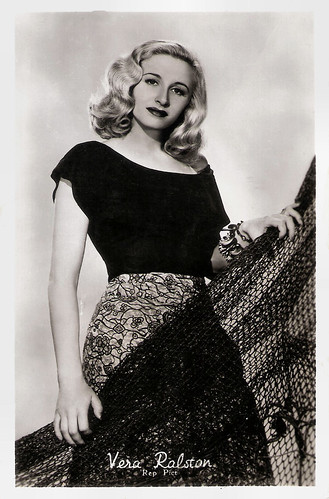
Vintage card. Photo: Republic Pictures.
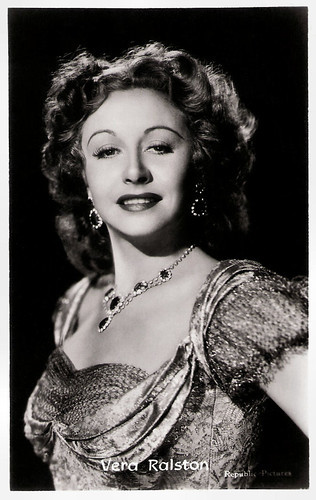
Vintage card. Photo: Republic Pictures.
Figure Skating Champion in Czechoslovakia
Věra Helena Hrubá was born in Prague, Czechoslovakia (now Czech Republic) in 1923. Her age and date of birth were often uncertain; various sources gave her birth year as 1919, 1920, 1921, and 1923. Her accurate date of birth is 12 July 1923, as verified by the social security death index as well as her burial records at Santa Barbara Cemetery, Santa Barbara, California.
Her father, Rudolf Hruba, was a wealthy jeweller and president of the Jewels Association. Her brother later became a film producer in the United States under the name of Rudy Ralston. Vera studied ballet as a child and turned to ice skating when she was 10 years old.
As a figure skater, she represented Czechoslovakia in competition under her birth name Věra Hrubá. She competed at the 1936 European Figure Skating Championships and placed 15th. Later that season, she competed at the 1936 Winter Olympics in Garmisch-Partenkirchen in Nazi Germany, where she placed 17th. Hrubá also competed at the 1937 European Figure Skating Championships and placed 7th.
In 1937, she toured the United States in ice revues. RKO offered her a screen test, but she refused because she was getting married. Her engagement to a half-Jewish boy dissolved when his parents did not consent to his wedding a Catholic.
Vera Hruba escaped her native Czechoslovakia in March 1939 on the last plane out before the Nazis closed the borders in Czechoslovakia. Via Paris, she and her mother travelled by ship to New York. Later her brother and father followed them. In 1946 she would become an American citizen.
Hubra became part of the 'Ice Vanities' and toured America. When the show came to California, Republic Pictures representatives saw the show and loved it. Republic put everyone under contract and made Ice-Capades (Joseph Santley, 1941) which was so successful they made a follow-up, Ice-Capades Revue (Bernard Vorhaus, 1942), the following year.
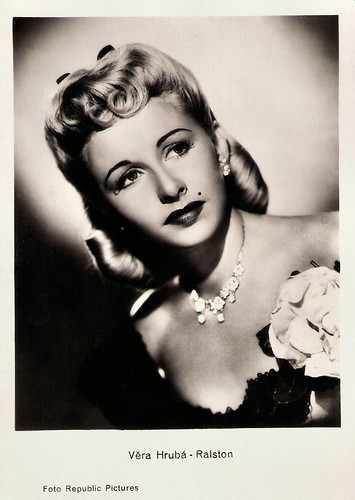
Czech postcard by Ceskoslovenské filmové naklatefstvi (CSFN), Praha, no. 69. Photo: Republic Pictures.
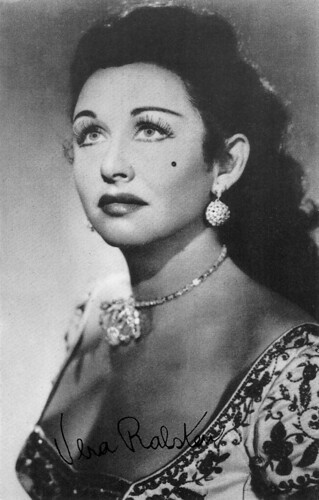
British postcard in the Celebrity Autograph Series, London, no. 188. Photo: Republic. Publicity still for Timberjack (Joseph Kane, 1955).
Golden Turkey Award
Vera Hruba moved to Hollywood with her mother and signed a long-term contract in 1943 with Republic Pictures. She chooses Ralston, from the breakfast cereal, as her screen name. She was advertised by Republic as skating “out of Czechoslovakia into the hearts of America.” During her early film career she was known as Vera Hrubá Ralston and later as Vera Ralston.
Ralston’s films weren’t just skating musical comedies. Her first film under the new contract was the Sci-Fi thriller The Lady and the Monster (George Sherman, 1944) with Erich von Stroheim and Richard Arlen. It was the first version of Curt Siodmak's often filmed Science Fiction novel 'Donovan's Brain', about the living brain of millionaire Donovan who possesses the mind of scientist Richard Arlen to clear his illegitimate son who has been wrongly convicted of murder. Critics said Ralston was wooden and complained of her Czech accent.
Hruba normally played an immigrant girl, because of her limited English skills. Among the 27 films Ralston starred in were Storm Over Lisbon (George Sherman, 1944) with again Erich von Stroheim , the Western Dakota (Joseph Kane, 1945) with John Wayne, I, Jane Doe (John H. Auer, 1948) with Ruth Hussey and John Carrol, and The Fighting Kentuckian (George Waggner, 1949), also with John Wayne. Joseph Kane directed her 11 times.
Late 1947, Republic studio head Herbert Yates leaves his wife and four adult children to be with her. He's 67; she's 27. Her father doesn't approve of the relationship and returns to Prague. In 1952 Ralston married Yates. He used his position to obtain roles for Ralston, such as in A Perilous Journey (R.G. Springsteen, 1953) with David Brian, and Fair Wind to Java (Joseph Kane, 1953) with Fred MacMurray. In 1956, he was sued by two studio shareholders for using company assets to promote his wife and having given her brother producer status at a salary far beyond industry worth.
Vera Ralston retired from films in 1958, the year Yates was deposed as head of the studio. Reportedly only 2 of her 20 films had made money. The 85-year-old Herbert Yates died in 1966, leaving his $8 million estate to Ralston (other sources say the estate was $10 million or more and she inherited half of it). She suffered a nervous breakdown shortly thereafter, then remarried in 1973 to Charles L. Alva, a Santa Barbara businessman, and lived quietly in southern California.
Vera Ralston died in 2003, in Santa Barbara, California, after a long battle with cancer. She was 79. The authors of the book 'The Golden Turkey Awards' nominated her for the dubious honour of 'The Worst Actress of All Time', along with Candice Bergen and Mamie Van Doren . They all lost to Raquel Welch .
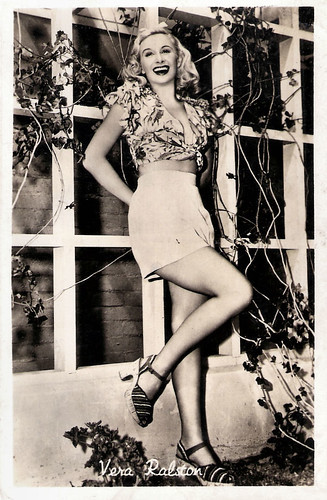
Belgian postcard by Nieuwe Merksemsche Chocolaterie S.P.R.L., Merksem (Anvers). Photo: Republic.
Red McCarthy and Vera Hruba in finale of Ice-Capades (1941). Source: Carl Moseley (YouTube).
Trailer for The Lady and the Monster (1944). Source: Ivot Kuzo (YouTube).
Sources: (IMDb), Jessica Pickens (Comet over Hollywood), The Glamour Girls of the Silver Screen, Wikipedia and .

Vintage card. Photo: Republic Pictures.

Vintage card. Photo: Republic Pictures.
Figure Skating Champion in Czechoslovakia
Věra Helena Hrubá was born in Prague, Czechoslovakia (now Czech Republic) in 1923. Her age and date of birth were often uncertain; various sources gave her birth year as 1919, 1920, 1921, and 1923. Her accurate date of birth is 12 July 1923, as verified by the social security death index as well as her burial records at Santa Barbara Cemetery, Santa Barbara, California.
Her father, Rudolf Hruba, was a wealthy jeweller and president of the Jewels Association. Her brother later became a film producer in the United States under the name of Rudy Ralston. Vera studied ballet as a child and turned to ice skating when she was 10 years old.
As a figure skater, she represented Czechoslovakia in competition under her birth name Věra Hrubá. She competed at the 1936 European Figure Skating Championships and placed 15th. Later that season, she competed at the 1936 Winter Olympics in Garmisch-Partenkirchen in Nazi Germany, where she placed 17th. Hrubá also competed at the 1937 European Figure Skating Championships and placed 7th.
In 1937, she toured the United States in ice revues. RKO offered her a screen test, but she refused because she was getting married. Her engagement to a half-Jewish boy dissolved when his parents did not consent to his wedding a Catholic.
Vera Hruba escaped her native Czechoslovakia in March 1939 on the last plane out before the Nazis closed the borders in Czechoslovakia. Via Paris, she and her mother travelled by ship to New York. Later her brother and father followed them. In 1946 she would become an American citizen.
Hubra became part of the 'Ice Vanities' and toured America. When the show came to California, Republic Pictures representatives saw the show and loved it. Republic put everyone under contract and made Ice-Capades (Joseph Santley, 1941) which was so successful they made a follow-up, Ice-Capades Revue (Bernard Vorhaus, 1942), the following year.

Czech postcard by Ceskoslovenské filmové naklatefstvi (CSFN), Praha, no. 69. Photo: Republic Pictures.

British postcard in the Celebrity Autograph Series, London, no. 188. Photo: Republic. Publicity still for Timberjack (Joseph Kane, 1955).
Golden Turkey Award
Vera Hruba moved to Hollywood with her mother and signed a long-term contract in 1943 with Republic Pictures. She chooses Ralston, from the breakfast cereal, as her screen name. She was advertised by Republic as skating “out of Czechoslovakia into the hearts of America.” During her early film career she was known as Vera Hrubá Ralston and later as Vera Ralston.
Ralston’s films weren’t just skating musical comedies. Her first film under the new contract was the Sci-Fi thriller The Lady and the Monster (George Sherman, 1944) with Erich von Stroheim and Richard Arlen. It was the first version of Curt Siodmak's often filmed Science Fiction novel 'Donovan's Brain', about the living brain of millionaire Donovan who possesses the mind of scientist Richard Arlen to clear his illegitimate son who has been wrongly convicted of murder. Critics said Ralston was wooden and complained of her Czech accent.
Hruba normally played an immigrant girl, because of her limited English skills. Among the 27 films Ralston starred in were Storm Over Lisbon (George Sherman, 1944) with again Erich von Stroheim , the Western Dakota (Joseph Kane, 1945) with John Wayne, I, Jane Doe (John H. Auer, 1948) with Ruth Hussey and John Carrol, and The Fighting Kentuckian (George Waggner, 1949), also with John Wayne. Joseph Kane directed her 11 times.
Late 1947, Republic studio head Herbert Yates leaves his wife and four adult children to be with her. He's 67; she's 27. Her father doesn't approve of the relationship and returns to Prague. In 1952 Ralston married Yates. He used his position to obtain roles for Ralston, such as in A Perilous Journey (R.G. Springsteen, 1953) with David Brian, and Fair Wind to Java (Joseph Kane, 1953) with Fred MacMurray. In 1956, he was sued by two studio shareholders for using company assets to promote his wife and having given her brother producer status at a salary far beyond industry worth.
Vera Ralston retired from films in 1958, the year Yates was deposed as head of the studio. Reportedly only 2 of her 20 films had made money. The 85-year-old Herbert Yates died in 1966, leaving his $8 million estate to Ralston (other sources say the estate was $10 million or more and she inherited half of it). She suffered a nervous breakdown shortly thereafter, then remarried in 1973 to Charles L. Alva, a Santa Barbara businessman, and lived quietly in southern California.
Vera Ralston died in 2003, in Santa Barbara, California, after a long battle with cancer. She was 79. The authors of the book 'The Golden Turkey Awards' nominated her for the dubious honour of 'The Worst Actress of All Time', along with Candice Bergen and Mamie Van Doren . They all lost to Raquel Welch .

Belgian postcard by Nieuwe Merksemsche Chocolaterie S.P.R.L., Merksem (Anvers). Photo: Republic.
Red McCarthy and Vera Hruba in finale of Ice-Capades (1941). Source: Carl Moseley (YouTube).
Trailer for The Lady and the Monster (1944). Source: Ivot Kuzo (YouTube).
Sources: (IMDb), Jessica Pickens (Comet over Hollywood), The Glamour Girls of the Silver Screen, Wikipedia and .
Published on May 12, 2019 22:00
Paul van Yperen's Blog
- Paul van Yperen's profile
- 13 followers
Paul van Yperen isn't a Goodreads Author
(yet),
but they
do have a blog,
so here are some recent posts imported from
their feed.



